Paul van Yperen's Blog, page 377
July 8, 2015
Patricia Roc
Fresh-faced Patricia Roc (1915-2003) was between 1943 and 1953 one of Britain's top 10 box office stars. The elegant, well spoken actress seemed the epitome of the English rose. She had international success in such Gainsborough costume dramas as Madonna of the Seven Moons (1945) and The Wicked Lady (1945), and in When the Bough Breaks (1947) as an unmarried mother.
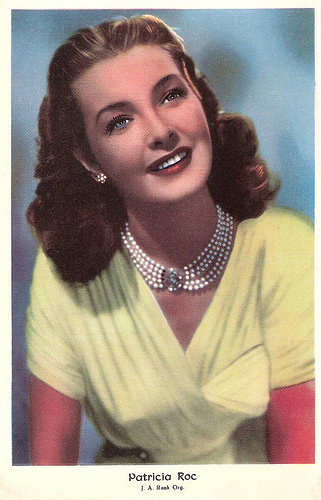
British postcard. Photo: J.A. Rank Org.
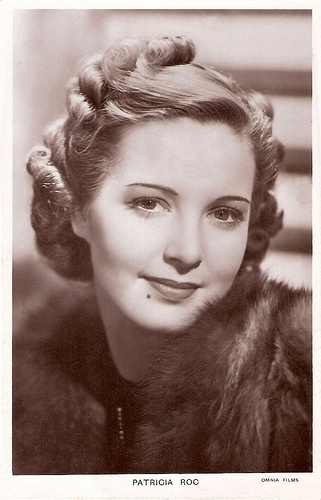
British postcard in the Picturegoer series, London, no. 1122. Photo: Omnia Films.
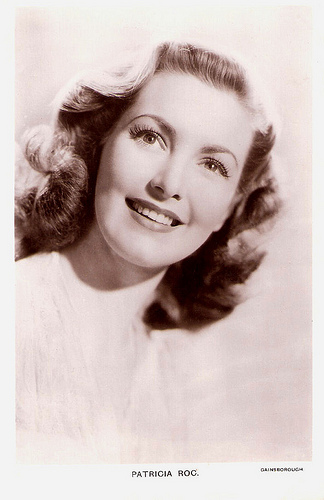
British postcard. Photo: Gainsborough.
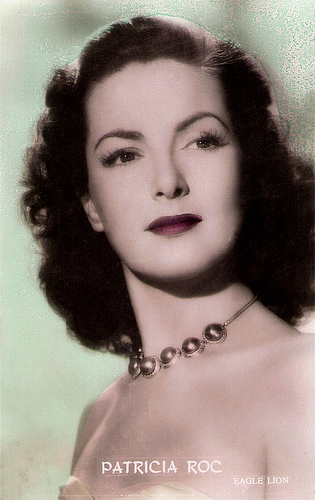
Vintage postcard. Photo: Eagle Lion.
Lady in Distress
Patricia Roc was born Felicia Miriam Ursula Herold in London in 1915. She was the adoptive daughter of a Dutch-Belgian father, André Riese, a wealthy stockbroker, and a half-French mother. She had two sisters called Marie-Louise and Barbara. ‘Pat’ did not learn that she was adopted as a baby until she was 34 when she needed her birth certificate in order to marry her second, French husband.
Roc was educated at private schools in London, followed by a finishing education in Paris. In 1937 she joined London's Royal Academy of Dramatic Arts (RADA). A year later she started as a stage actress, debuting in a Guy Bolton revue, Nuts And May (1938).
She was seen in this production by film mogul Alexander Korda who cast her in a minor role in the romantic comedy The Divorce of Lady X (Tim Whelan, 1938) starring Merle Oberon and Laurence Olivier .
Korda then offered her a leading role as the Polish Princess in the costume epic The Rebel Son (Adrian Brunel, Albert de Courville, Alexis Granowsky, 1938). This was an English-language version of the French film Tarass Boulba (Alexis Granowsky, 1936) starring Harry Baur , utilising much of the action footage from the earlier film.
She learned the trade in a few B-films as a 'lady in distress', including the Edgar Wallace thrillers The Gaunt Stranger (Walter Forde, 1938) and The Mind Of Mr Reeder (Jack Raymond, 1939).
Roc came into her own in patriotic films backing the war effort. She helped Alastair Sim fight the closing of a village hall in Let The People Sing (John Baxter, 1941) based on a novel by J.B. Priestley, and she supported Vera Lynn, the 'Forces' Sweetheart', in We'll Meet Again (Philip Brandon, 1942), a story loosely based on Lynn’s rise to radio fame.
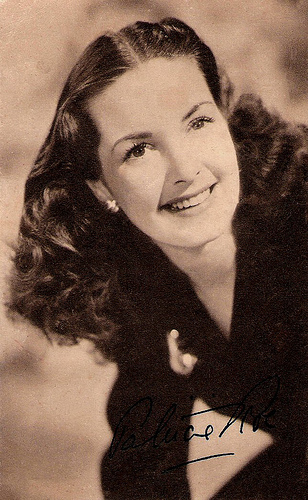
British postcard.
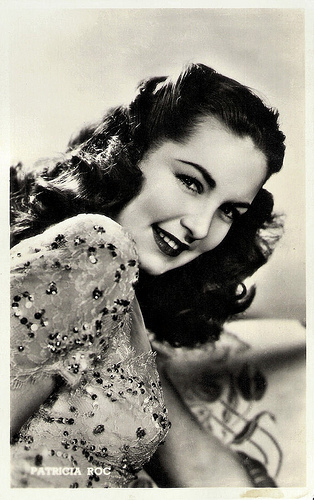
Dutch postcard.
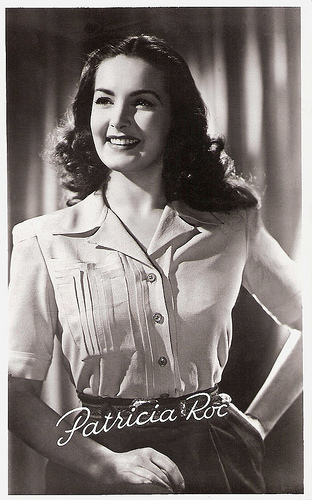
Dutch postcard by Uitgeverij Takken, Utrecht, no. 3105.
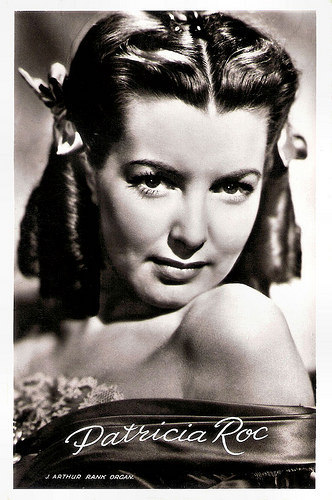
Dutch postcard, no. 3238. Photo: J. Arthur Rank Org.
Demure Lower-middle-class Girl
In 1943 Patricia Roc became one of Britain's 10 box-office stars for 10 consecutive years, surpassed only by Margaret Lockwood . In the Gainsborough production Millions Like Us (Sidney Gilliat, Frank Launder, 1943), she played the demure lower-middle-class girl who is called up for war service and is directed into a factory making aircraft parts. She marries a young airman (Gordon Jackson) but he is killed in action.
The Rank Organization (with the distinctive logo of the Gongman) contracted her. Rank was the largest and most vertically-integrated film company in Britain, owning distribution, exhibition and production facilities (including the Gainsborough Studios). The head of the studio, J. Arthur Rank described Roc as ‘the archetypal British beauty, the Goddess of Odeon's’.
'Pat' co-starred with Phyllis Calvert , Jean Kent and Flora Robson as internment camp inmates in Two Thousand Women (Frank Launder, 1944), who secretly assist the underground.
She then achieved her greatest level of popularity in a series of escapist melodramas for Gainsborough. In these films Roc usually represented the stereotype of the sweet young thing, menaced by ‘bad girls’ like Jean Kent or Margaret Lockwood , or by rakes like James Mason or Stewart Granger .
Love Story (Leslie Arliss, 1944) allowed her to play a concert pianist ánd Margaret Lockwood 's jealous rival for Stewart Granger 's love. In one scene they had to slap each other's faces, but she later commented that she and Lockwood remained always the best of friends.
They again played rivals in the costume dramas The Wicked Lady (Leslie Arliss, 1945) and Jassy (Bernard Knowles, 1947). The most famous of these films is The Wicked Lady, the top box-office draw of 1946 in the UK. Roc is back in the ‘nice girl’ role and has her fiancé stolen from her by Lockwood, her best friend. Lockwood does the 'dirty' on Roc again in Jassy by pinching Dermot Walsh from her.
Another huge success was the melodrama Madonna of the Seven Moons (Arthur Crabtree, 1945) in which she played the daughter of Phyllis Calvert (although the two actresses differed only four months in age). The films were loathed by critics and loved by the public.
Roc's more overt sexuality in these films was downplayed for the American market. Her - and Lockwood’s - cleavage led US censors to call for retakes to de-emphasise it.
In the US Roc made only one film, Walter Wanger's production Canyon Passage (Jacques Tourneur, 1946). In this offbeat Western she again loses the hero (Dana Andrews) to the bigger star (Susan Hayward). This brief move to Hollywood was a loan-out arrangement between Rank and Universal Studios of British in return for American film actors.
During filming, Roc was romantically linked with Ronald Reagan. The following year the romance resumed when Reagan came to Great Britain to make The Hasty Heart (Vincent Sherman, 1949).
Roc played a tempestuous orphan girl in a Scottish fishing village in her next film, The Brothers (David MacDonald, 1947). The orphan has her pick of men, causing rivalry, murder, suicide and ritual killing in the highly superstitious community. The grim tale was not popular at the time but has since gained in reputation.
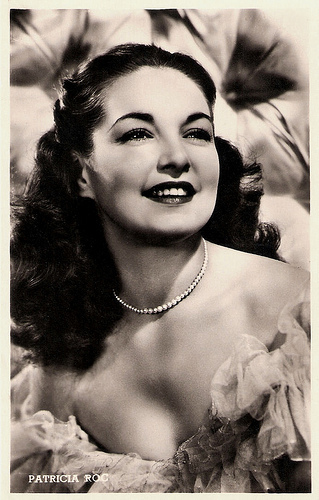
Dutch postcard by J.S.A. Photo: Universal M.P.E.
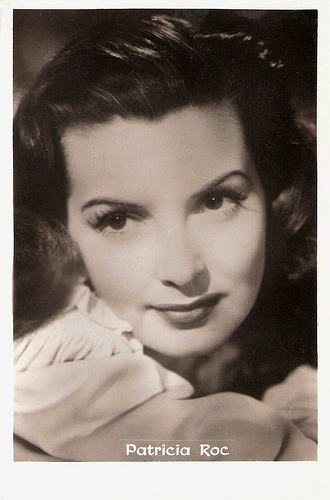
British postcard.
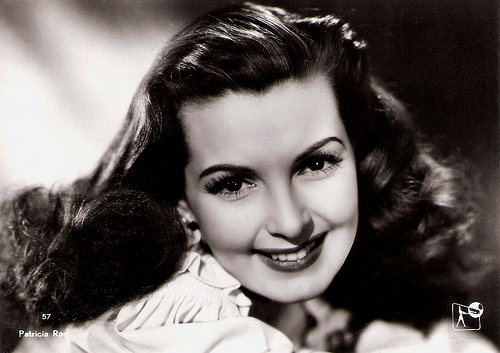
Norvegian postcard by Enerett K. Harstad, Kunstforlag, Oslo, no. 57. Photo: Rank.
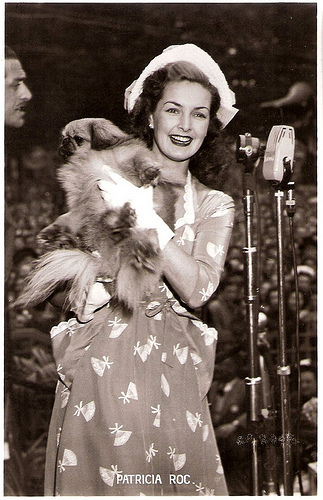
British postcard in the A Real Photograph series, no. F. S. 38. Patricia Roc with pet Peke 'Floppy' welcome some of the 25,000 guests at the Sunday Pictorial Film Garden Party.
The Goddess of the Odeons
Patricia Roc’s career reached another peak in 1948 with When The Bough Breaks (Lawrence Huntington, 1948), an adoption drama that mirrored her own life, and with the musical One Night With You (Terence Young), 1948. During the shooting of the latter film film she met and fell in love with the French director of photography André Thomas, who was to become her second husband.
Roc was married three times. In 1939 - two weeks after the start of the war, the 24-year-old actress had married for the first time, to the 44-year-old Canadian osteopath Dr. Murray Laing. The union swiftly foundered, and they divorced in 1944. In 1949 she married André Thomas, and they moved to Paris.
Roc's contract with Rank had ended and she started to work in France. Her French films included the anthology Retour à la vie/Return to Life (Georges Lampin, André Cayatte, Henri-Georges Clouzot, Jean Dréville, 1949), and the Georges Simenon adaptation L'homme de la tour Eiffel/The Man on the Eiffel Tower (Burgess Meredith, 1949) starring Charles Laughton as inspector Jules Maigret.
Thomas was unable to have children, which Roc wanted. She had an affair with her co-star Anthony Steel during the filming of Something Money Can't Buy (Pat Jackson, 1952). And in 1952 Roc gave birth to a son Michael as a result of the affair. Thomas agreed to raise Michael as his own and Michael was not told the truth about his father's identity until he was in his mid-40s.
Roc appeared in the Italian films La mia vita è tua/My Life is Yours (Giuseppe Masini, 1953), Le avventure di Cartouche/Cartouche (Steve Sekely, Gianni Vernuccio, 1954) opposite Richard Baseheart, and the woman's film La vedova X/The Widow (Lewis Milestone, 1955).
After the death of Thomas, Roc returned to England in 1957. She appeared in only 3 more films including Bluebeard's Ten Honeymoons (W. Lee Wilder, 1960) in which she played one of the rich victims, thrown off a railway bridge by George Sanders. She also made a few television appearances such as the first episode of The Saint (1962) with Roger Moore as Simon Templar.
She married a third and final time, to businessman Walter Reif, in 1964, and retired from acting. Known as Felicia Reif, Patricia Roc was all but forgotten until she hit the headlines again in 1975 when she was fined £25 for shoplifting from Marks & Spencer in Oxford Street. She later stated that it was purely absent-mindedness, but she pleaded guilty in the hope of avoiding publicity.
The following year, she and her husband moved to a house overlooking the Lago Maggiore in Locarno, Switzerland. There she died in 2003 of kidney failure, aged 88. Recently a biography of Patricia Roc was published, Patricia Roc: The Goddess of the Odeons (2010) by Michael Hodgson.
Excerpt from Millions Like Us (1943). Source: Takethetube9010 (YouTube).
Trailer of The Wicked Lady (1945). Source: Littleshoemaker (YouTube).
Scene from Holiday Camp (1947). Source: Feverpitch96 (YouTube).
Sources: Ronald Bergan (The Guardian), Henry Jaremko (The Wicked Lady), Tom Vallance (The Independent), Tony Williams (Encyclopedia of British Film), BBC News, Wikipedia and .

British postcard. Photo: J.A. Rank Org.

British postcard in the Picturegoer series, London, no. 1122. Photo: Omnia Films.

British postcard. Photo: Gainsborough.

Vintage postcard. Photo: Eagle Lion.
Lady in Distress
Patricia Roc was born Felicia Miriam Ursula Herold in London in 1915. She was the adoptive daughter of a Dutch-Belgian father, André Riese, a wealthy stockbroker, and a half-French mother. She had two sisters called Marie-Louise and Barbara. ‘Pat’ did not learn that she was adopted as a baby until she was 34 when she needed her birth certificate in order to marry her second, French husband.
Roc was educated at private schools in London, followed by a finishing education in Paris. In 1937 she joined London's Royal Academy of Dramatic Arts (RADA). A year later she started as a stage actress, debuting in a Guy Bolton revue, Nuts And May (1938).
She was seen in this production by film mogul Alexander Korda who cast her in a minor role in the romantic comedy The Divorce of Lady X (Tim Whelan, 1938) starring Merle Oberon and Laurence Olivier .
Korda then offered her a leading role as the Polish Princess in the costume epic The Rebel Son (Adrian Brunel, Albert de Courville, Alexis Granowsky, 1938). This was an English-language version of the French film Tarass Boulba (Alexis Granowsky, 1936) starring Harry Baur , utilising much of the action footage from the earlier film.
She learned the trade in a few B-films as a 'lady in distress', including the Edgar Wallace thrillers The Gaunt Stranger (Walter Forde, 1938) and The Mind Of Mr Reeder (Jack Raymond, 1939).
Roc came into her own in patriotic films backing the war effort. She helped Alastair Sim fight the closing of a village hall in Let The People Sing (John Baxter, 1941) based on a novel by J.B. Priestley, and she supported Vera Lynn, the 'Forces' Sweetheart', in We'll Meet Again (Philip Brandon, 1942), a story loosely based on Lynn’s rise to radio fame.

British postcard.

Dutch postcard.

Dutch postcard by Uitgeverij Takken, Utrecht, no. 3105.

Dutch postcard, no. 3238. Photo: J. Arthur Rank Org.
Demure Lower-middle-class Girl
In 1943 Patricia Roc became one of Britain's 10 box-office stars for 10 consecutive years, surpassed only by Margaret Lockwood . In the Gainsborough production Millions Like Us (Sidney Gilliat, Frank Launder, 1943), she played the demure lower-middle-class girl who is called up for war service and is directed into a factory making aircraft parts. She marries a young airman (Gordon Jackson) but he is killed in action.
The Rank Organization (with the distinctive logo of the Gongman) contracted her. Rank was the largest and most vertically-integrated film company in Britain, owning distribution, exhibition and production facilities (including the Gainsborough Studios). The head of the studio, J. Arthur Rank described Roc as ‘the archetypal British beauty, the Goddess of Odeon's’.
'Pat' co-starred with Phyllis Calvert , Jean Kent and Flora Robson as internment camp inmates in Two Thousand Women (Frank Launder, 1944), who secretly assist the underground.
She then achieved her greatest level of popularity in a series of escapist melodramas for Gainsborough. In these films Roc usually represented the stereotype of the sweet young thing, menaced by ‘bad girls’ like Jean Kent or Margaret Lockwood , or by rakes like James Mason or Stewart Granger .
Love Story (Leslie Arliss, 1944) allowed her to play a concert pianist ánd Margaret Lockwood 's jealous rival for Stewart Granger 's love. In one scene they had to slap each other's faces, but she later commented that she and Lockwood remained always the best of friends.
They again played rivals in the costume dramas The Wicked Lady (Leslie Arliss, 1945) and Jassy (Bernard Knowles, 1947). The most famous of these films is The Wicked Lady, the top box-office draw of 1946 in the UK. Roc is back in the ‘nice girl’ role and has her fiancé stolen from her by Lockwood, her best friend. Lockwood does the 'dirty' on Roc again in Jassy by pinching Dermot Walsh from her.
Another huge success was the melodrama Madonna of the Seven Moons (Arthur Crabtree, 1945) in which she played the daughter of Phyllis Calvert (although the two actresses differed only four months in age). The films were loathed by critics and loved by the public.
Roc's more overt sexuality in these films was downplayed for the American market. Her - and Lockwood’s - cleavage led US censors to call for retakes to de-emphasise it.
In the US Roc made only one film, Walter Wanger's production Canyon Passage (Jacques Tourneur, 1946). In this offbeat Western she again loses the hero (Dana Andrews) to the bigger star (Susan Hayward). This brief move to Hollywood was a loan-out arrangement between Rank and Universal Studios of British in return for American film actors.
During filming, Roc was romantically linked with Ronald Reagan. The following year the romance resumed when Reagan came to Great Britain to make The Hasty Heart (Vincent Sherman, 1949).
Roc played a tempestuous orphan girl in a Scottish fishing village in her next film, The Brothers (David MacDonald, 1947). The orphan has her pick of men, causing rivalry, murder, suicide and ritual killing in the highly superstitious community. The grim tale was not popular at the time but has since gained in reputation.

Dutch postcard by J.S.A. Photo: Universal M.P.E.

British postcard.

Norvegian postcard by Enerett K. Harstad, Kunstforlag, Oslo, no. 57. Photo: Rank.

British postcard in the A Real Photograph series, no. F. S. 38. Patricia Roc with pet Peke 'Floppy' welcome some of the 25,000 guests at the Sunday Pictorial Film Garden Party.
The Goddess of the Odeons
Patricia Roc’s career reached another peak in 1948 with When The Bough Breaks (Lawrence Huntington, 1948), an adoption drama that mirrored her own life, and with the musical One Night With You (Terence Young), 1948. During the shooting of the latter film film she met and fell in love with the French director of photography André Thomas, who was to become her second husband.
Roc was married three times. In 1939 - two weeks after the start of the war, the 24-year-old actress had married for the first time, to the 44-year-old Canadian osteopath Dr. Murray Laing. The union swiftly foundered, and they divorced in 1944. In 1949 she married André Thomas, and they moved to Paris.
Roc's contract with Rank had ended and she started to work in France. Her French films included the anthology Retour à la vie/Return to Life (Georges Lampin, André Cayatte, Henri-Georges Clouzot, Jean Dréville, 1949), and the Georges Simenon adaptation L'homme de la tour Eiffel/The Man on the Eiffel Tower (Burgess Meredith, 1949) starring Charles Laughton as inspector Jules Maigret.
Thomas was unable to have children, which Roc wanted. She had an affair with her co-star Anthony Steel during the filming of Something Money Can't Buy (Pat Jackson, 1952). And in 1952 Roc gave birth to a son Michael as a result of the affair. Thomas agreed to raise Michael as his own and Michael was not told the truth about his father's identity until he was in his mid-40s.
Roc appeared in the Italian films La mia vita è tua/My Life is Yours (Giuseppe Masini, 1953), Le avventure di Cartouche/Cartouche (Steve Sekely, Gianni Vernuccio, 1954) opposite Richard Baseheart, and the woman's film La vedova X/The Widow (Lewis Milestone, 1955).
After the death of Thomas, Roc returned to England in 1957. She appeared in only 3 more films including Bluebeard's Ten Honeymoons (W. Lee Wilder, 1960) in which she played one of the rich victims, thrown off a railway bridge by George Sanders. She also made a few television appearances such as the first episode of The Saint (1962) with Roger Moore as Simon Templar.
She married a third and final time, to businessman Walter Reif, in 1964, and retired from acting. Known as Felicia Reif, Patricia Roc was all but forgotten until she hit the headlines again in 1975 when she was fined £25 for shoplifting from Marks & Spencer in Oxford Street. She later stated that it was purely absent-mindedness, but she pleaded guilty in the hope of avoiding publicity.
The following year, she and her husband moved to a house overlooking the Lago Maggiore in Locarno, Switzerland. There she died in 2003 of kidney failure, aged 88. Recently a biography of Patricia Roc was published, Patricia Roc: The Goddess of the Odeons (2010) by Michael Hodgson.
Excerpt from Millions Like Us (1943). Source: Takethetube9010 (YouTube).
Trailer of The Wicked Lady (1945). Source: Littleshoemaker (YouTube).
Scene from Holiday Camp (1947). Source: Feverpitch96 (YouTube).
Sources: Ronald Bergan (The Guardian), Henry Jaremko (The Wicked Lady), Tom Vallance (The Independent), Tony Williams (Encyclopedia of British Film), BBC News, Wikipedia and .
Published on July 08, 2015 22:00
July 7, 2015
Imported from the USA: Abbe Lane
American Va-va-voom singer Abbe Lane (1932) achieved her greatest success as the vocalist for Xavier Cugat's orchestra, but she also appeared in American and several Italian films. The beautiful, curvaceous Lane was nicknamed 'the swingingest sexpot in show business.'
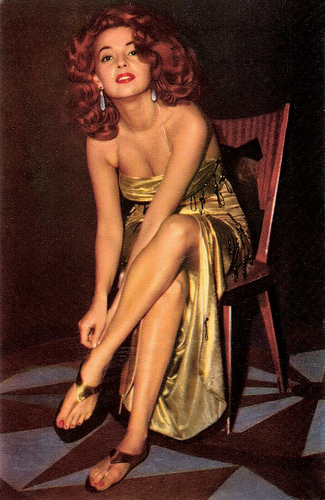
German card by Ufa, no. 1039. Photo: Ufa.
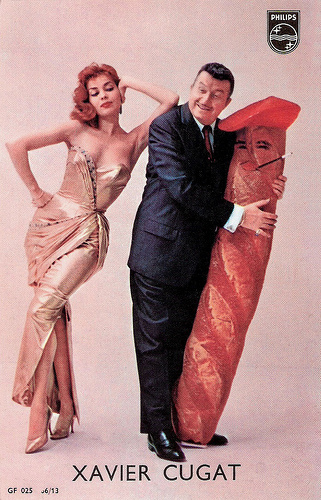
Xavier Cugat. Promotion card by Philips, no. GF 025 66/13.
Nightclub Sensation
Abbe Lane was born Abigail Francine Lassman to a Jewish family in Brooklyn, New York, in 1932. She began her career as a child actress on radio and in movie shorts by Vitaphone. From there she progressed to singing and dancing on Broadway.
At 16, she appeared on Broadway in George Abbot's Barefoot Boy with Cheek. A year later, she was a featured vocalist on the Vincent Lopez television show and worked on stage in a Michael Todd production of As the Girls Go.
Bandleader Xavier Cugat spotted her calypso number in that stage show and hired her as a vocalist for his famous orchestra. In 1952, the two married and Cugat influenced her music which favoured Latin and rumba styles.
With her palpable sexuality she became a nightclub sensation as well as a fixture on television variety shows, such as Toast of the Town. She attracted attention in talk shows for her suggestive comments such as " Jayne Mansfield may turn boys into men, but I take them from there". Her costume for an appearance on the Jackie Gleason Show was considered too revealing and she was instructed to wear something else.
Lane made her Hollywood debut in the Western Wings of the Hawk (Budd Boetticher, 1953), followed a year later by Ride Clear of Diablo (Jesse Hibbs, 1954) starring Audie Murphy. Cugat supervised her musical number in another WesternThe Americano (William Castle, 1955), starring Glenn Ford.
When the live Xavier Cugat Show premiered in 1957, Lane was front and centre. She recorded a series of Latin jazz-inspired LPs for RCA. In 1958 she collaborated with Tito Puente on the top-selling record album Be Mine Tonight and she also starred opposite Tony Randall in the Broadway musical Oh, Captain!. Lane later recorded her songs in that musical on a solo album.
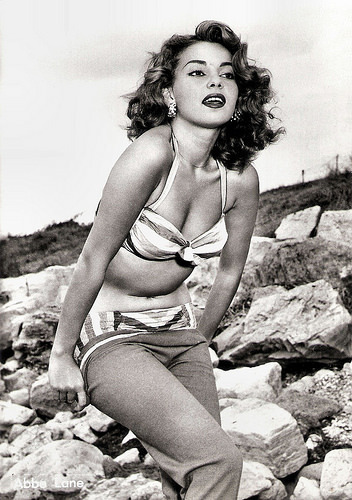
Italian postcard by Bromostampa, Milano, no. 113.

French postcard by Editions P.I.. Paris, offered by Les Carbones Korès 'Carboplane', no. 1034. Photo: Paolo Costa / Rapho.
Too sexy for the RAI
Despite these successes, Hollywood offered Abbe Lane mainly decorative parts and like many other American stars, she moved to Rome to work in Italian films. In 1955 she and Cugat toured Italy, where she co-starred in the film Quando tramonta il sole/Sunset in Naples (Guido Brignone, 1955). Her attempts to promote the project were complicated when Italian television network RAI called her 'too sexy' to appear on air.
More Italian films soon followed, like the drama I girovaghi/The Wanderers (Hugo Fregonese, 1956) starring Peter Ustinov, and the comedy Tempo di villeggiatura/Time of Vacation (Antonio Racioppi, 1956) with Vittorio de Sica. As Eva, she played the female lead in the Italian comedy Totò, Eva e il pennello proibito/Toto in Madrid (Stefano Vanzina, 1959) starring Totò and Louis de Funès .
When Cugat moved back to New York, Lane chose to stay in Italy. The distance proved too much for the couple, and they divorced in 1964. Lane remained in the public eye throughout the 1960s, guest-starring on TV series including F Troop (1966), The Man from U.N.C.L.E. (1966), The Flying Nun (1968), and The Brady Bunch (1970), but her career flagged throughout the 1970s. She appeared in a segment of Twilight Zone: The Movie (George Miller, 1983) in the role of an airline stewardess and did some final TV appearances.
In 1992 Abbe Lane unexpectedly resurfaced with But Where Is Love?, an autobiographical novel about a Broadway ingénue who falls in love with a Latin bandleader. Since 1964, she is married to Peter Leff.
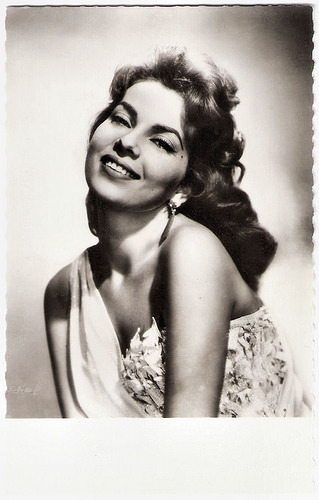
French postcard by Editions P.I., Paris, presented by Les Carbones Korès Carboplane, no. 996. Photo: Paramount. Publicity still for Maracaibo (Cornel Wilde, 1958).
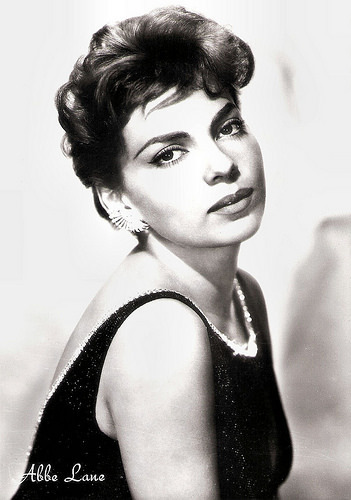
Italian postcard by Rotalfoto, no. 858.
Sources: Frank Thistle (Adam), Carina MacKenzie (Los Angeles Times), Jason Ankeny (AllMusic), Wikipedia and .

German card by Ufa, no. 1039. Photo: Ufa.

Xavier Cugat. Promotion card by Philips, no. GF 025 66/13.
Nightclub Sensation
Abbe Lane was born Abigail Francine Lassman to a Jewish family in Brooklyn, New York, in 1932. She began her career as a child actress on radio and in movie shorts by Vitaphone. From there she progressed to singing and dancing on Broadway.
At 16, she appeared on Broadway in George Abbot's Barefoot Boy with Cheek. A year later, she was a featured vocalist on the Vincent Lopez television show and worked on stage in a Michael Todd production of As the Girls Go.
Bandleader Xavier Cugat spotted her calypso number in that stage show and hired her as a vocalist for his famous orchestra. In 1952, the two married and Cugat influenced her music which favoured Latin and rumba styles.
With her palpable sexuality she became a nightclub sensation as well as a fixture on television variety shows, such as Toast of the Town. She attracted attention in talk shows for her suggestive comments such as " Jayne Mansfield may turn boys into men, but I take them from there". Her costume for an appearance on the Jackie Gleason Show was considered too revealing and she was instructed to wear something else.
Lane made her Hollywood debut in the Western Wings of the Hawk (Budd Boetticher, 1953), followed a year later by Ride Clear of Diablo (Jesse Hibbs, 1954) starring Audie Murphy. Cugat supervised her musical number in another WesternThe Americano (William Castle, 1955), starring Glenn Ford.
When the live Xavier Cugat Show premiered in 1957, Lane was front and centre. She recorded a series of Latin jazz-inspired LPs for RCA. In 1958 she collaborated with Tito Puente on the top-selling record album Be Mine Tonight and she also starred opposite Tony Randall in the Broadway musical Oh, Captain!. Lane later recorded her songs in that musical on a solo album.

Italian postcard by Bromostampa, Milano, no. 113.

French postcard by Editions P.I.. Paris, offered by Les Carbones Korès 'Carboplane', no. 1034. Photo: Paolo Costa / Rapho.
Too sexy for the RAI
Despite these successes, Hollywood offered Abbe Lane mainly decorative parts and like many other American stars, she moved to Rome to work in Italian films. In 1955 she and Cugat toured Italy, where she co-starred in the film Quando tramonta il sole/Sunset in Naples (Guido Brignone, 1955). Her attempts to promote the project were complicated when Italian television network RAI called her 'too sexy' to appear on air.
More Italian films soon followed, like the drama I girovaghi/The Wanderers (Hugo Fregonese, 1956) starring Peter Ustinov, and the comedy Tempo di villeggiatura/Time of Vacation (Antonio Racioppi, 1956) with Vittorio de Sica. As Eva, she played the female lead in the Italian comedy Totò, Eva e il pennello proibito/Toto in Madrid (Stefano Vanzina, 1959) starring Totò and Louis de Funès .
When Cugat moved back to New York, Lane chose to stay in Italy. The distance proved too much for the couple, and they divorced in 1964. Lane remained in the public eye throughout the 1960s, guest-starring on TV series including F Troop (1966), The Man from U.N.C.L.E. (1966), The Flying Nun (1968), and The Brady Bunch (1970), but her career flagged throughout the 1970s. She appeared in a segment of Twilight Zone: The Movie (George Miller, 1983) in the role of an airline stewardess and did some final TV appearances.
In 1992 Abbe Lane unexpectedly resurfaced with But Where Is Love?, an autobiographical novel about a Broadway ingénue who falls in love with a Latin bandleader. Since 1964, she is married to Peter Leff.

French postcard by Editions P.I., Paris, presented by Les Carbones Korès Carboplane, no. 996. Photo: Paramount. Publicity still for Maracaibo (Cornel Wilde, 1958).

Italian postcard by Rotalfoto, no. 858.
Sources: Frank Thistle (Adam), Carina MacKenzie (Los Angeles Times), Jason Ankeny (AllMusic), Wikipedia and .
Published on July 07, 2015 22:00
July 6, 2015
Lou Tellegen
Lou Tellegen (1883-1934) was considered one of the best-looking actors of the silent screen - first in France and later in the United States. He made three pictures with Sarah Bernhardt. Then the ‘Stage Adonis’ starred in a London production of Oscar Wilde’s The Picture of Dorian Gray. In Hollywood he married opera diva Geraldine Farrar and co-starred with her in three of her films. As the silent era ended, Tellegen's career was also over. He finished his tempestuous life by committing hara-kiri with a pair of golden scissors, as the legend goes.
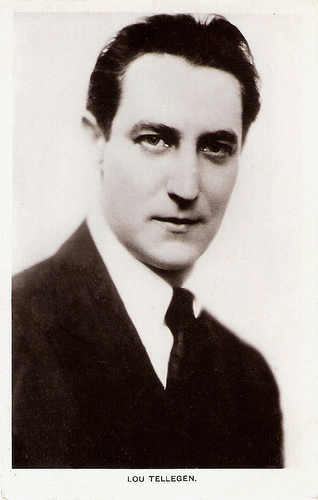
British postcard in the Picturegoer series, London, no. 212.
The Divine Sarah
Lou Tellegen (or Lou-Tellegen) was born as Isidor Louis Bernard Edmon van Dommelen in Sint-Oedenrode, The Netherlands, in 1883 (several sources mistakenly mention 1881). He was the illegitimate child of former army lieutenant Isidor Louis Bernard Edmon Tellegen and actress Anna Maria van Dommelen. His family moved a year later to Nijmegen and then to Amsterdam.
Lou made his stage debut in 1903 with the stage company Rotterdamsch Tooneel of Dieck van Eysden. He moved to Brussels and later to Paris, where he worked as a model for such artists as Lacroix, Constantin Meunier and Auguste Rodin, and as a prize-boxer. He studied at the Conservatoire Nationale de Musique et de Déclamation, and worked for the Théâtre de l'Odéon under André Antoine, the innovative founder of the Théâtre Libre. Tellegen became an eager and dedicated stage actor with Italy’s most famous actress at the time, Eleonora Duse .
Later he met dandy-actor Edouard de Max , who introduced him to Sarah Bernhardt . Eventually Lou co-starred in several roles with the Divine Sarah, and was also romantically involved with her. In 1910, he made his motion picture debut as Armand Duval alongside Bernhardt in La dame aux camellias/Camille (Louis Mercanton, 1911), a French silent film based on the play by Alexandre Dumas, fils.
In 1910, Tellegen and Bernhardt travelled to the United States to appear on stage in Jeanne d’Arc (Joan of Arc). The New York Times first published, and then retracted, the announcement of their impending marriage. She was 37 years his senior.
Back in France, they made their second film together, Les Amours de la reine Élisabeth/Queen Elizabeth (Henri Desfontaines, Louis Mercanton, 1912). The film was an adaptation of a play by Émile Moreau about episodes of the life of Elizabeth I, Queen of England (1533-1603), and focussed on her ill-fated love affair with Robert Devereux, Earl of Essex (Tellegen). It was an enormous success in the U.S., where it was distributed by a young Adolph Zukor.
The following year, Bernhardt and Tellegen appeared again together in Adrienne Lecouvreur/An Actress's Romance (Henri Desfontaines, Louis Mercanton, 1913). This film is considered a lost film. In the summer of 1913, Tellegen went to London where he produced, directed and starred in the Oscar Wilde play The Picture of Dorian Gray.
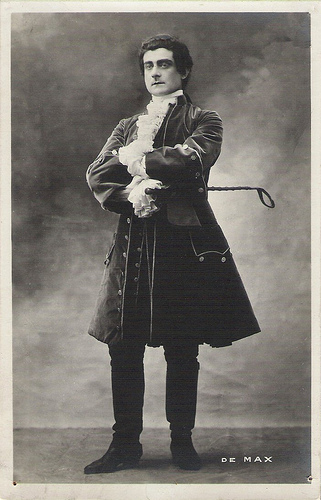
Edouard de Max . French postcard.
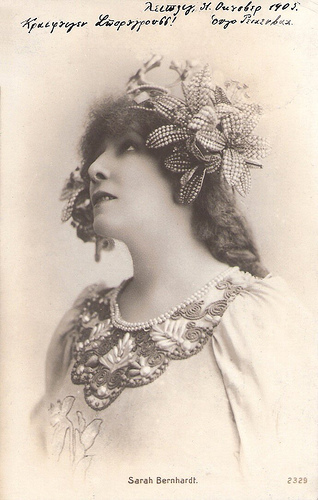
Sarah Bernhardt . Postcard sent from Leipzig, 31 October 1905, to Laibach, Krain, Austria (now Ljubljana, Slovenia). The author wrote in German but using the Greek alphabet and signed Hugo Reizenbach. The adressee was Christl Kantz.
One of the Best-looking Actors on Screen
Invited back to the United States, Lou Tellegen worked in the theatre and soon became a matinee idol. One of the reviews read: 'French romance, hand-kissing romance, dashing romance, it lives again with Tellegen'. His leading role in the melodrama Maria Rosa was a spectacular success.
Samuel Goldwyn, at the time financial director of the Jesse L. Lasky Feature Play Company, saw Tellegen in 1915 in this play and offered him a contract for six films. His American film début was The Explorer (George Melford, 1915), followed by The Unknown (George Melford, 1915), both with Dorothy Davenport as his co-star.
Considered one of the best-looking actors on screen, Tellegen starred in numerous silent films opposite such stars as Sessue Hayakawa, in The Victoria Cross (Edward LeSaint, 1916), and Nell Shipman, in The Black Wolf (Frank Reicher, 1917).
In 1916, he married Geraldine Farrar, a well-known opera diva turned film actress, who was herself known to be the lover of Germany's Crown Prince Wilhelm of Germany. He appeared with Farrar in three films: The World and Its Woman (Frank Lloyd, 1919), Flame of the Desert (Reginald Barker, 1919) and The Woman and the Puppet (Reginald Barker, 1920). Their marriage did not last and they divorced in 1923.
Lou Tellegen had become an American citizen in 1918. He combined his work in the cinema with a successful stage career. Tellegen also worked as a producer and co-wrote two successful plays - Blind youth (1917) with Willard Mack, and The lust of gold (1919) with Andor Garvay – which earned him a lot of money.
For Vitagraph and Fox Film he appeared in numerous silent films including The Redeeming Sin (J. Stuart Blackton, 1925) with Alla Nazimova and Parisian Love (Louis J. Gasnier, 1925) with Clara Bow.
One of his memorable roles was as the corrupt Sheriff in John Ford's Western 3 Bad Men (1926) who wore a white hat instead of the stereotypical bad guy black hat. He directed a film starring Dolores del Rio, No Other Woman (Lou Tellegen, 1928), but it was not a success.
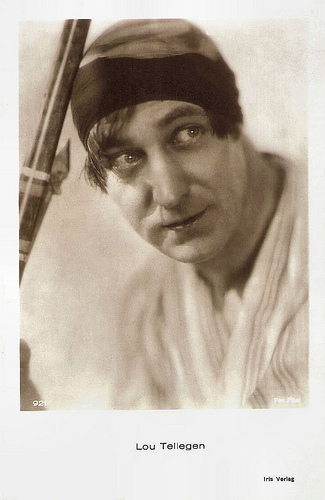
Austrian postcard by Iris Verlag, no. 921. Photo: Fox Film.
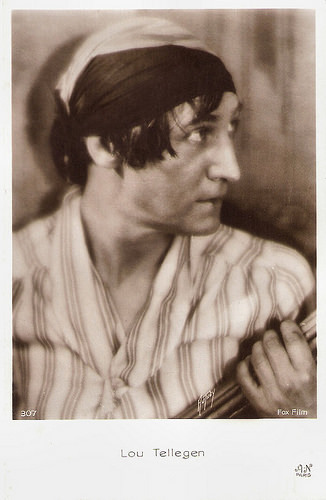
French postcard by A.N., Paris, no. 307. Photo: (Max Munn) Autrey / Fox Film.
Harakiri
After his face was damaged in a hotel fire in 1929 and sound film had arrived, Lou Tellegen’s fame faded. According to novelist Kathy Charles, Lou possessed “a high-pitched voice that could curl the hairs on your neck, Tellegen’s career was destroyed by the advent of dialogue in the cinema, and he instantly became a has-been.”
Among his rare sound film appearances were a supporting part in the crime film Enemies of the Law (Lawrence C. Windom, 1931) with Mary Nolan, and a bit part in Caravane (Erik Charell, 1934) starring Charles Boyer . Employment was not forthcoming and debt-ridden, he went bankrupt.
He was diagnosed with cancer, though this information was kept from him, and he became despondent. In 1934, Tellegen locked himself in the bathroom of a mansion of a female admirer, the rich widow Edna Cuhady, on North Vine Street in Los Angeles. He shaved and powdered his face, and while standing in front of a full-length mirror, he committed hara-kiri by stabbing himself seven times with a pair of golden scissors (which had his name engraved on them). Reportedly he was surrounded by newspaper clippings of his career, which he had always cut with the same golden scissors.
According to a 1934 article in Time Magazine, the many obituaries “told how at 15 he ran off with his father's mistress, how he specialized in love-making while he was successively a baker's assistant, a trapeze artist, a model for Auguste Rodin (Eternal Springtime, the original which is now in the Metropolitan Museum), how he first arrived in the U.S. as Sarah Bernhardt 's leading man. The final Hollywood picture was of a broken, hollow-eyed matinee idol who kept having his face lifted.“
These obituaries were mostly taken from Tellegen's highly fictitious memoir, Women Have Been Kind (1931). Dorothy Parker called it "rubbish" in Vanity Fair, and suggested the title should have been Women Have Been Kind - of Dumb. Tellegen's wives were Countess Jeanne de Brouckère (1903-1905) - an artist whom he had met while he was an artist’s model in Paris and with whom he had a daughter, Diane; Geraldine Farrar (1916-1923); Isabelle Craven Dilworth - an actress with the stage name Nina Romano (1923-1928) with whom he had a son, Rex; and actress and former Ziegfield girl Eve Casanova (1930-1934).
When asked to comment on Tellegen's death, Geraldine Farrar replied candidly: "Why should that interest me?" The Tellegen interlude, the prima donna claimed long ago, left only "a surface scar." His wife Eve Casanova sent her regrets from New York but did not have the time to attend his funeral. All in all, only 37 family members and friends showed up for the funeral of a man that at one time had millions of fans worldwide.
Lou Tellegen was burned to ashes which, as a last theatrical gesture, he ordered sprinkled on the waves of the Pacific. Posthumously his last film was released, the drama Together We Live (Willard Mack, 1935). In 2011, David W. Menefee published The Rise and Fall of Lou Tellegen.
Short clip from from Les Amours de la reine Élisabeth/Queen Elizabeth (1912). Robert Devereux (Tellegen) is executed. Queen Elizabeth ( Sarah Bernhardt ) visits his corpse, and mourns for him. Source: swagner99 (YouTube).
Long clip from Parisian Love (Louis Gasnier, 1925) with Lou Tellegen and Clara Bow. Source: classicmoviegirl91 (YouTube).
Sources: Bob Bertina (Lou Tellegen. Een Hollander in Hollywood, VN Bijlage 1985 - Dutch), A.J.C.M. Gabriëls (Institute of Netherlands History), Erik Brouwer (De Volkskrant - Dutch), Kathy Charles (John Belushi is Dead), Allan Ellenberger (Hollywoodland), Time, Wikipedia and .

British postcard in the Picturegoer series, London, no. 212.
The Divine Sarah
Lou Tellegen (or Lou-Tellegen) was born as Isidor Louis Bernard Edmon van Dommelen in Sint-Oedenrode, The Netherlands, in 1883 (several sources mistakenly mention 1881). He was the illegitimate child of former army lieutenant Isidor Louis Bernard Edmon Tellegen and actress Anna Maria van Dommelen. His family moved a year later to Nijmegen and then to Amsterdam.
Lou made his stage debut in 1903 with the stage company Rotterdamsch Tooneel of Dieck van Eysden. He moved to Brussels and later to Paris, where he worked as a model for such artists as Lacroix, Constantin Meunier and Auguste Rodin, and as a prize-boxer. He studied at the Conservatoire Nationale de Musique et de Déclamation, and worked for the Théâtre de l'Odéon under André Antoine, the innovative founder of the Théâtre Libre. Tellegen became an eager and dedicated stage actor with Italy’s most famous actress at the time, Eleonora Duse .
Later he met dandy-actor Edouard de Max , who introduced him to Sarah Bernhardt . Eventually Lou co-starred in several roles with the Divine Sarah, and was also romantically involved with her. In 1910, he made his motion picture debut as Armand Duval alongside Bernhardt in La dame aux camellias/Camille (Louis Mercanton, 1911), a French silent film based on the play by Alexandre Dumas, fils.
In 1910, Tellegen and Bernhardt travelled to the United States to appear on stage in Jeanne d’Arc (Joan of Arc). The New York Times first published, and then retracted, the announcement of their impending marriage. She was 37 years his senior.
Back in France, they made their second film together, Les Amours de la reine Élisabeth/Queen Elizabeth (Henri Desfontaines, Louis Mercanton, 1912). The film was an adaptation of a play by Émile Moreau about episodes of the life of Elizabeth I, Queen of England (1533-1603), and focussed on her ill-fated love affair with Robert Devereux, Earl of Essex (Tellegen). It was an enormous success in the U.S., where it was distributed by a young Adolph Zukor.
The following year, Bernhardt and Tellegen appeared again together in Adrienne Lecouvreur/An Actress's Romance (Henri Desfontaines, Louis Mercanton, 1913). This film is considered a lost film. In the summer of 1913, Tellegen went to London where he produced, directed and starred in the Oscar Wilde play The Picture of Dorian Gray.

Edouard de Max . French postcard.

Sarah Bernhardt . Postcard sent from Leipzig, 31 October 1905, to Laibach, Krain, Austria (now Ljubljana, Slovenia). The author wrote in German but using the Greek alphabet and signed Hugo Reizenbach. The adressee was Christl Kantz.
One of the Best-looking Actors on Screen
Invited back to the United States, Lou Tellegen worked in the theatre and soon became a matinee idol. One of the reviews read: 'French romance, hand-kissing romance, dashing romance, it lives again with Tellegen'. His leading role in the melodrama Maria Rosa was a spectacular success.
Samuel Goldwyn, at the time financial director of the Jesse L. Lasky Feature Play Company, saw Tellegen in 1915 in this play and offered him a contract for six films. His American film début was The Explorer (George Melford, 1915), followed by The Unknown (George Melford, 1915), both with Dorothy Davenport as his co-star.
Considered one of the best-looking actors on screen, Tellegen starred in numerous silent films opposite such stars as Sessue Hayakawa, in The Victoria Cross (Edward LeSaint, 1916), and Nell Shipman, in The Black Wolf (Frank Reicher, 1917).
In 1916, he married Geraldine Farrar, a well-known opera diva turned film actress, who was herself known to be the lover of Germany's Crown Prince Wilhelm of Germany. He appeared with Farrar in three films: The World and Its Woman (Frank Lloyd, 1919), Flame of the Desert (Reginald Barker, 1919) and The Woman and the Puppet (Reginald Barker, 1920). Their marriage did not last and they divorced in 1923.
Lou Tellegen had become an American citizen in 1918. He combined his work in the cinema with a successful stage career. Tellegen also worked as a producer and co-wrote two successful plays - Blind youth (1917) with Willard Mack, and The lust of gold (1919) with Andor Garvay – which earned him a lot of money.
For Vitagraph and Fox Film he appeared in numerous silent films including The Redeeming Sin (J. Stuart Blackton, 1925) with Alla Nazimova and Parisian Love (Louis J. Gasnier, 1925) with Clara Bow.
One of his memorable roles was as the corrupt Sheriff in John Ford's Western 3 Bad Men (1926) who wore a white hat instead of the stereotypical bad guy black hat. He directed a film starring Dolores del Rio, No Other Woman (Lou Tellegen, 1928), but it was not a success.

Austrian postcard by Iris Verlag, no. 921. Photo: Fox Film.

French postcard by A.N., Paris, no. 307. Photo: (Max Munn) Autrey / Fox Film.
Harakiri
After his face was damaged in a hotel fire in 1929 and sound film had arrived, Lou Tellegen’s fame faded. According to novelist Kathy Charles, Lou possessed “a high-pitched voice that could curl the hairs on your neck, Tellegen’s career was destroyed by the advent of dialogue in the cinema, and he instantly became a has-been.”
Among his rare sound film appearances were a supporting part in the crime film Enemies of the Law (Lawrence C. Windom, 1931) with Mary Nolan, and a bit part in Caravane (Erik Charell, 1934) starring Charles Boyer . Employment was not forthcoming and debt-ridden, he went bankrupt.
He was diagnosed with cancer, though this information was kept from him, and he became despondent. In 1934, Tellegen locked himself in the bathroom of a mansion of a female admirer, the rich widow Edna Cuhady, on North Vine Street in Los Angeles. He shaved and powdered his face, and while standing in front of a full-length mirror, he committed hara-kiri by stabbing himself seven times with a pair of golden scissors (which had his name engraved on them). Reportedly he was surrounded by newspaper clippings of his career, which he had always cut with the same golden scissors.
According to a 1934 article in Time Magazine, the many obituaries “told how at 15 he ran off with his father's mistress, how he specialized in love-making while he was successively a baker's assistant, a trapeze artist, a model for Auguste Rodin (Eternal Springtime, the original which is now in the Metropolitan Museum), how he first arrived in the U.S. as Sarah Bernhardt 's leading man. The final Hollywood picture was of a broken, hollow-eyed matinee idol who kept having his face lifted.“
These obituaries were mostly taken from Tellegen's highly fictitious memoir, Women Have Been Kind (1931). Dorothy Parker called it "rubbish" in Vanity Fair, and suggested the title should have been Women Have Been Kind - of Dumb. Tellegen's wives were Countess Jeanne de Brouckère (1903-1905) - an artist whom he had met while he was an artist’s model in Paris and with whom he had a daughter, Diane; Geraldine Farrar (1916-1923); Isabelle Craven Dilworth - an actress with the stage name Nina Romano (1923-1928) with whom he had a son, Rex; and actress and former Ziegfield girl Eve Casanova (1930-1934).
When asked to comment on Tellegen's death, Geraldine Farrar replied candidly: "Why should that interest me?" The Tellegen interlude, the prima donna claimed long ago, left only "a surface scar." His wife Eve Casanova sent her regrets from New York but did not have the time to attend his funeral. All in all, only 37 family members and friends showed up for the funeral of a man that at one time had millions of fans worldwide.
Lou Tellegen was burned to ashes which, as a last theatrical gesture, he ordered sprinkled on the waves of the Pacific. Posthumously his last film was released, the drama Together We Live (Willard Mack, 1935). In 2011, David W. Menefee published The Rise and Fall of Lou Tellegen.
Short clip from from Les Amours de la reine Élisabeth/Queen Elizabeth (1912). Robert Devereux (Tellegen) is executed. Queen Elizabeth ( Sarah Bernhardt ) visits his corpse, and mourns for him. Source: swagner99 (YouTube).
Long clip from Parisian Love (Louis Gasnier, 1925) with Lou Tellegen and Clara Bow. Source: classicmoviegirl91 (YouTube).
Sources: Bob Bertina (Lou Tellegen. Een Hollander in Hollywood, VN Bijlage 1985 - Dutch), A.J.C.M. Gabriëls (Institute of Netherlands History), Erik Brouwer (De Volkskrant - Dutch), Kathy Charles (John Belushi is Dead), Allan Ellenberger (Hollywoodland), Time, Wikipedia and .
Published on July 06, 2015 22:00
July 5, 2015
Gerhard Riedmann
Austrian film actor Gerhard Riedmann (1925–2004) was the romantic lead in German and Austrian musical comedies, operettas and Heimatfilms of the 1950s and 1960s.
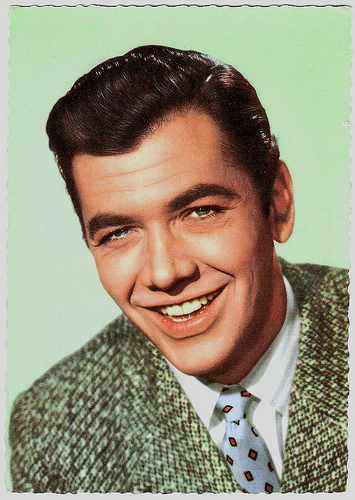
German postcard, Berlin-Tempelhof, no. CK-52. Photo: Werler / Prisma-Film.
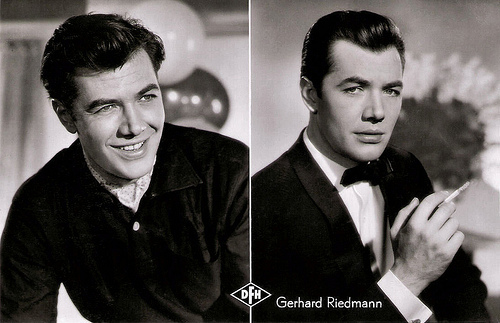
German postcard by Franz Josef Rudel, Hamburg-Bergedorf, no. 2291. Photo: CCC / Deutsche Film Hansa / A. Grimm.
The Bird Seller
Gerhard Anton Riedmann was born in Vienna, the capital of Austria in 1925. He was the son of a railway official. Riedmann studied music (violin) for one year and then moved to the Max-Reinhardt-Seminar. His first stage parts were at the Theater an der Josefstadt in Vienna.
In 1948 he made his film debut with an uncredited bit role in Das andere Leben/The Different Life (Rudolf Steinboeck, 1948), made by the crew and cast of the Viennese Theater an der Josefsstadt. At IMDb , Martin Kukuczka writes: “The story is based upon the novel by Alexander Lernet-Holenia. Interestingly, it has not lost any of its vigour or message and still appears to work perfectly as a post-WWII social insight and, more powerfully, the judgment of the time.”
Riedmann had his breakthrough as Adam, the title character in Der Vogelhändler/The Bird Seller (Arthur Maria Rabenalt, 1953), based on the popular operetta by Carl Zeller. His co-stars were Ilse Werner , Wolf Albach Retty and Eva Probst, who would become his first wife.
Next he played the male lead in another operetta, Der Vetter aus Dingsda/The Cousin from Nowhere (Karl Anton, 1953), also starring Vera Molnar and Grethe Weiser. The film was based on the 1921 operetta Der Vetter aus Dingsda composed by Eduard Künneke. Another popular operetta adaptation was Der Zigeunerbaron/The Gypsy Baron (Arthur Maria Rabenalt, 1954) with Paul Hörbiger and Margit Saad .
In 1955 he played King Ludwig II in the American biographical film Magic Fire (William Dieterle, 1955) about the life of composer Richard Wagner (Alan Badel). The film depicted King Ludwig II's patronage of Wagner, without going into much detail about the king's controversial personality. The film, produced by independent film studio Republic Pictures, used a very large cast, opulent sets, and lavish costumes. Magic Fire was shot in Italy and Germany over 12 weeks. Since Republic was known primarily for Westerns and adventure serials, Magic Fire was one of the rare ‘prestige’ films to be produced by studio chief Herbert Yates. Nevertheless, critical response was mixed and box office receipts in the U.S. were disappointing.
Riedmann then played the title roles in the drama Oberwachtmeister Borck/Sergeant Borck (Gerhard Lamprecht, 1955) and the German musical Der Bettelstudent/The Beggar Student (Werner Jacobs, 1956) with Waltraut Haas and Elma Karlowa and based on the operetta Der Bettelstudent by Karl Millöcker. After a Polish aristocrat refuses to marry a Colonel, he manoeuvers to force her to marry a penniless student in revenge. The following year, he played the lead in Der Graf von Luxemburg/The Count of Luxemburg (Werner Jacobs, 1957) based on the operetta Der Graf von Luxemburg by Franz Lehár.
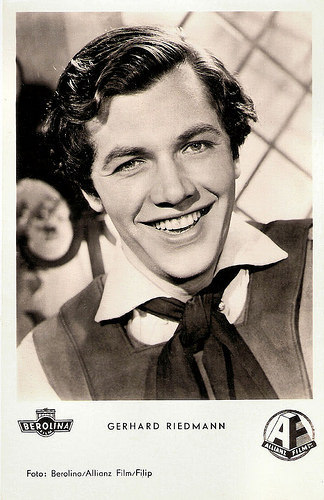
German postcard by Kunst und Bild, Berlin, no. A 898. Photo: Berolina-Film / Allianz Film / Filip. Publicity still for Der Vogelhändler/The Bird Seller (Arthur Maria Rabenalt, 1953).
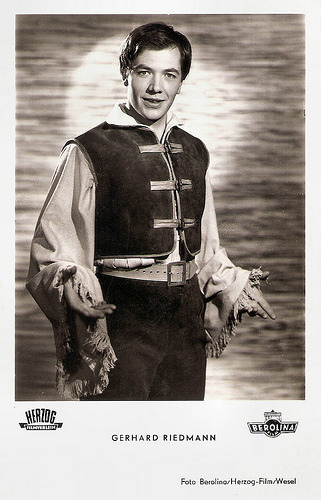
German postcard by Kunst und Bild, Berlin, no. A 1127. Photo: Berolina-Film / Herzog-Film / Wesel. Publicity still for Der Zigeunerbaron/The Gypsy Baron (Arthur Maria Rabenalt, 1954).
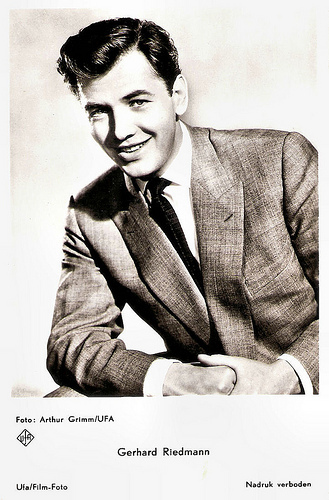
Belgian postcard by DRC, no. 3692. Photo: Arthur Grimm / Ufa.
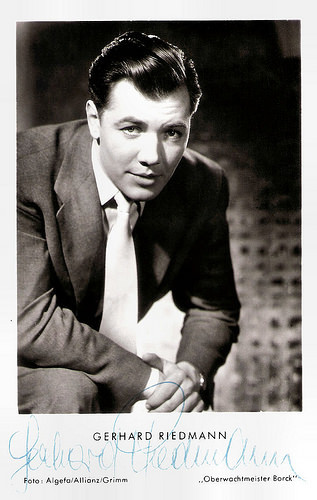
German autograph card. Photo: Algefa / Allianz / Grimm. Publicity still for Oberwachtmeister Borck/Sergeant Borck (Gerhard Lamprecht, 1955).
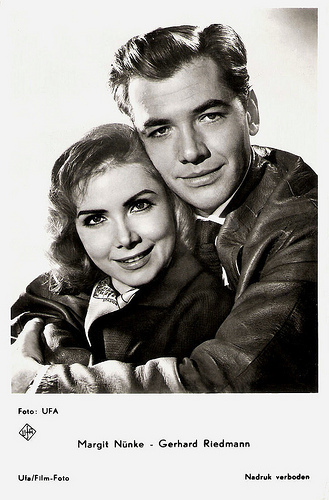
Dutch postcard by DRC Holland, no. 1223. Photo: Ufa. Publicity still for Geliebte Bestie/Hippodrome (Arthur Maria Rabenalt, 1959) with Margit Nünke.
Waldrausch
During the early 1960s, Gerhard Riedmann continued to star in light entertainment films like the Austrian comedy Ich heirate Herrn Direktor/I'm getting married to the director (Wolfgang Liebeneiner, 1960) with Heidelinde Weiss , and the Heimat film Waldrausch (Paul May, 1962) starring Marianne Hold . In Waldrausch, Riedmann played an architect, who proposes a plan to build a damn, flooding a valley. A farmer tries to block the ambitious plans.
When the German cinema imploded, he focused more on television, where he remade old film successes as Der Vogelhändler (Kurt Wilhelm, 1960). He then had a supporting part in the Czechoslovak film Dýmky/The Pipes (Vojtěch Jasný, 1966), which was entered into the 1966 Cannes Film Festival.
In Italy, he co-starred in the Spaghetti Western Clint il solitario/Clint the Stranger (Alfonso Balcázar, 1967) with George Martin and Marianne Koch . He also starred in Die nackte Bovary/Madame Bovary (Hans Schott-Schönbinger, 1969) with Edwige Fenech as Gustave Flaubert’s heroin.
In 1977 he played a supporting part in the remake of Waldrausch (Horst Hächler, 1977) starring Uschi Glas . His last screen role was in the TV series Der Bergdoktor/The mountain doctor (1992–1997).
When not acting in films or on stage (notably at the Munich Kammerspiele), he was employed as Project Director in his father-in-law's glass and optics factory.
Gerhard Riedmann died in Kematen in the Tyrol region of Austria. He was married to the actress Eva Probst from 1954 till 1960. His second marriage was to Anita Swarowski. Since 1991 he was married to Gertrud Anna Wettstein. He had seven children.
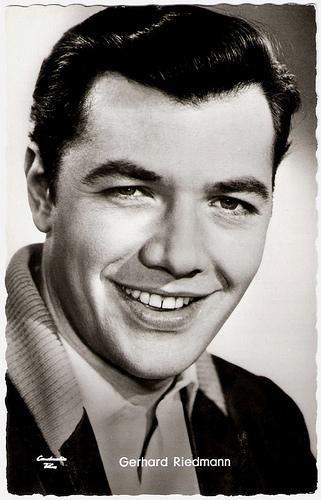
German postcard by Kolibri-Verlag, Minden/Westf., no. 1986. Photo: Neubach / Constantin / Bockelberg. Publicity still for Die Fischerin vom Bodensee/The Fisher-girl from Lake Bodensee (Harald Reinl, 1956).
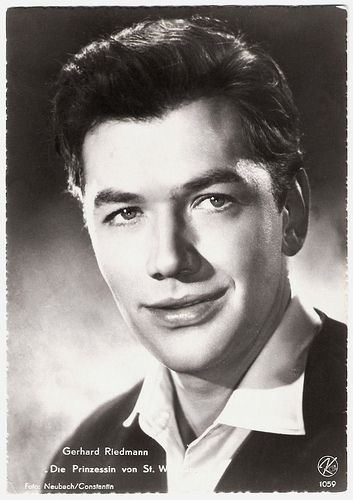
Austrian postcard by Kellner-Fotokarten, Wien, no. 1059. Photo: Neubach / Constantin. Publicity still for Die Prinzessin von St. Wolfgang/The Princess of St. Wolfgang (Harald Reinl, 1957).
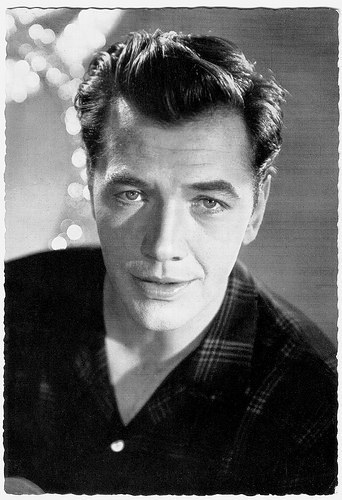
German postcard by WS-Druck, Wanne-Eickel, no. 432. Photo: Saschafilm.
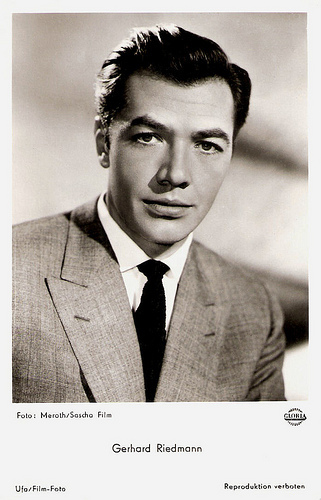
German postcard by Ufa, Berlin-Tempelhof, no. FK 3829. Photo: Meroth / Sascha Film / Gloria.
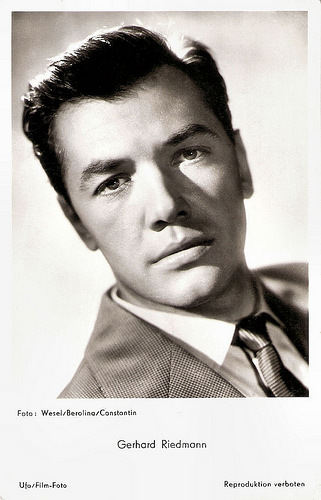
German postcard by Ufa, Berlin-Tempelhof, no. FK 3326. Photo: Berolina-Film / Constantin-Film / Wesel. Publicity still for Liebe ist ja nur ein Märchen/Love is just a fairytale (Arthur Maria Rabenalt, 1955).
Sources: Wikipedia and .

German postcard, Berlin-Tempelhof, no. CK-52. Photo: Werler / Prisma-Film.

German postcard by Franz Josef Rudel, Hamburg-Bergedorf, no. 2291. Photo: CCC / Deutsche Film Hansa / A. Grimm.
The Bird Seller
Gerhard Anton Riedmann was born in Vienna, the capital of Austria in 1925. He was the son of a railway official. Riedmann studied music (violin) for one year and then moved to the Max-Reinhardt-Seminar. His first stage parts were at the Theater an der Josefstadt in Vienna.
In 1948 he made his film debut with an uncredited bit role in Das andere Leben/The Different Life (Rudolf Steinboeck, 1948), made by the crew and cast of the Viennese Theater an der Josefsstadt. At IMDb , Martin Kukuczka writes: “The story is based upon the novel by Alexander Lernet-Holenia. Interestingly, it has not lost any of its vigour or message and still appears to work perfectly as a post-WWII social insight and, more powerfully, the judgment of the time.”
Riedmann had his breakthrough as Adam, the title character in Der Vogelhändler/The Bird Seller (Arthur Maria Rabenalt, 1953), based on the popular operetta by Carl Zeller. His co-stars were Ilse Werner , Wolf Albach Retty and Eva Probst, who would become his first wife.
Next he played the male lead in another operetta, Der Vetter aus Dingsda/The Cousin from Nowhere (Karl Anton, 1953), also starring Vera Molnar and Grethe Weiser. The film was based on the 1921 operetta Der Vetter aus Dingsda composed by Eduard Künneke. Another popular operetta adaptation was Der Zigeunerbaron/The Gypsy Baron (Arthur Maria Rabenalt, 1954) with Paul Hörbiger and Margit Saad .
In 1955 he played King Ludwig II in the American biographical film Magic Fire (William Dieterle, 1955) about the life of composer Richard Wagner (Alan Badel). The film depicted King Ludwig II's patronage of Wagner, without going into much detail about the king's controversial personality. The film, produced by independent film studio Republic Pictures, used a very large cast, opulent sets, and lavish costumes. Magic Fire was shot in Italy and Germany over 12 weeks. Since Republic was known primarily for Westerns and adventure serials, Magic Fire was one of the rare ‘prestige’ films to be produced by studio chief Herbert Yates. Nevertheless, critical response was mixed and box office receipts in the U.S. were disappointing.
Riedmann then played the title roles in the drama Oberwachtmeister Borck/Sergeant Borck (Gerhard Lamprecht, 1955) and the German musical Der Bettelstudent/The Beggar Student (Werner Jacobs, 1956) with Waltraut Haas and Elma Karlowa and based on the operetta Der Bettelstudent by Karl Millöcker. After a Polish aristocrat refuses to marry a Colonel, he manoeuvers to force her to marry a penniless student in revenge. The following year, he played the lead in Der Graf von Luxemburg/The Count of Luxemburg (Werner Jacobs, 1957) based on the operetta Der Graf von Luxemburg by Franz Lehár.

German postcard by Kunst und Bild, Berlin, no. A 898. Photo: Berolina-Film / Allianz Film / Filip. Publicity still for Der Vogelhändler/The Bird Seller (Arthur Maria Rabenalt, 1953).

German postcard by Kunst und Bild, Berlin, no. A 1127. Photo: Berolina-Film / Herzog-Film / Wesel. Publicity still for Der Zigeunerbaron/The Gypsy Baron (Arthur Maria Rabenalt, 1954).

Belgian postcard by DRC, no. 3692. Photo: Arthur Grimm / Ufa.

German autograph card. Photo: Algefa / Allianz / Grimm. Publicity still for Oberwachtmeister Borck/Sergeant Borck (Gerhard Lamprecht, 1955).

Dutch postcard by DRC Holland, no. 1223. Photo: Ufa. Publicity still for Geliebte Bestie/Hippodrome (Arthur Maria Rabenalt, 1959) with Margit Nünke.
Waldrausch
During the early 1960s, Gerhard Riedmann continued to star in light entertainment films like the Austrian comedy Ich heirate Herrn Direktor/I'm getting married to the director (Wolfgang Liebeneiner, 1960) with Heidelinde Weiss , and the Heimat film Waldrausch (Paul May, 1962) starring Marianne Hold . In Waldrausch, Riedmann played an architect, who proposes a plan to build a damn, flooding a valley. A farmer tries to block the ambitious plans.
When the German cinema imploded, he focused more on television, where he remade old film successes as Der Vogelhändler (Kurt Wilhelm, 1960). He then had a supporting part in the Czechoslovak film Dýmky/The Pipes (Vojtěch Jasný, 1966), which was entered into the 1966 Cannes Film Festival.
In Italy, he co-starred in the Spaghetti Western Clint il solitario/Clint the Stranger (Alfonso Balcázar, 1967) with George Martin and Marianne Koch . He also starred in Die nackte Bovary/Madame Bovary (Hans Schott-Schönbinger, 1969) with Edwige Fenech as Gustave Flaubert’s heroin.
In 1977 he played a supporting part in the remake of Waldrausch (Horst Hächler, 1977) starring Uschi Glas . His last screen role was in the TV series Der Bergdoktor/The mountain doctor (1992–1997).
When not acting in films or on stage (notably at the Munich Kammerspiele), he was employed as Project Director in his father-in-law's glass and optics factory.
Gerhard Riedmann died in Kematen in the Tyrol region of Austria. He was married to the actress Eva Probst from 1954 till 1960. His second marriage was to Anita Swarowski. Since 1991 he was married to Gertrud Anna Wettstein. He had seven children.

German postcard by Kolibri-Verlag, Minden/Westf., no. 1986. Photo: Neubach / Constantin / Bockelberg. Publicity still for Die Fischerin vom Bodensee/The Fisher-girl from Lake Bodensee (Harald Reinl, 1956).

Austrian postcard by Kellner-Fotokarten, Wien, no. 1059. Photo: Neubach / Constantin. Publicity still for Die Prinzessin von St. Wolfgang/The Princess of St. Wolfgang (Harald Reinl, 1957).

German postcard by WS-Druck, Wanne-Eickel, no. 432. Photo: Saschafilm.

German postcard by Ufa, Berlin-Tempelhof, no. FK 3829. Photo: Meroth / Sascha Film / Gloria.

German postcard by Ufa, Berlin-Tempelhof, no. FK 3326. Photo: Berolina-Film / Constantin-Film / Wesel. Publicity still for Liebe ist ja nur ein Märchen/Love is just a fairytale (Arthur Maria Rabenalt, 1955).
Sources: Wikipedia and .
Published on July 05, 2015 22:00
July 4, 2015
Laurence Harvey
At the 29th edition of Il Cinema Ritrovato in Bologna, which ended yesterday, one of the programs was Beautiful youth: Renato Castellani. The Italian film director and screenwriter made the wonderful young love trilogy of Neorealism with Sotto il sole di Roma (1948), È primavera...(1950) and Due soldi di speranza (1952), about which I wrote about last week in my post about Maria Fiore. After the trilogy, Castellani won the Grand Prix in Cannes with a film adaptation of the ultimate drama of young love, Romeo and Julia (1954). Handsome Lithuanian-born actor Laurence Harvey (1928–1973) played a terrific Romeo in this film. Harvey is best known for his lead performance as a ruthless social climber in Room at the Top (1959), but there is much more to tell about his career and life.
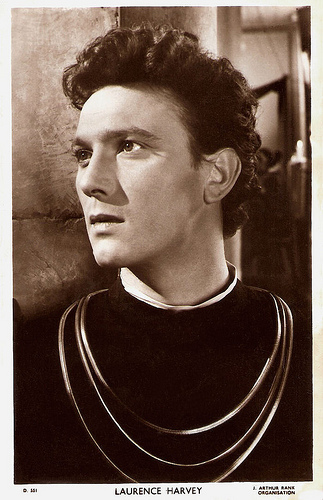
British postcard in the Picturegoer Series, London, no. D 551. Photo: J. Arthur Rank Organisation. Publicity still for Romeo and Juliet (1954).
A terrific Romeo
Laurence Harvey was born in the town of Joniškis, Lithuania in 1928. He maintained throughout his life that his birth name was Laruschka Mischa Skikne, but it was actually Zvi Mosheh Skikne. He was the youngest of three boys born to Ella Skikne Zotnickaita and Ber Skikne, a Lithuanian Jewish family.
Aged five, his family emigrated to South Africa, where he was known as Harry Skikne. He grew up in Johannesburg, and as a teenager he served with the entertainment unit of the South African Army during the Second World War in Egypt and Italy.
After moving to London, he enrolled in the Royal Academy of Dramatic Art where he became known as Larry. After leaving RADA early, he began to perform on stage in regional theatre. He made his cinema debut as Laurence Harvey in the British horror film House of Darkness (Oswald Mitchell, 1948).
After this the Associated British Picture Corporation (ABPC) offered him a two year contract and he appeared in several of their lower budget films such as the film noir Man on the Run (Lawrence Huntington, 1949) starring Derek Farr, and the narcotics crime drama Cairo Road (David MacDonald, 1950). After failing in the commercial theatre in London's West End, Harvey joined the company of the Shakespeare Memorial Theatre at Stratford-upon-Avon for the 1952 season.
His film career got a boost when he appeared in Women of Twilight (Gordon Parry, 1952) opposite René Ray. This crime drama was made by Romulus Films who signed Harvey to a long-term contract. He secured a small role in a Hollywood film, Knights of the Round Table (Richard Thorpe, 1953), and was cast with Rex Harrison in King Richard and the Crusaders (David Butler, 1954).
That year he also played Romeo in Renato Castellani's adaptation of William Shakespeare's Romeo and Juliet (1954), narrated by John Gielgud . Patrick Hunter at IMDb : “a very worthwhile movie, especially for Shakespeare fans. I personally think Laurence Harvey is a terrific Romeo. Yes, he's a bit of a simp, but that's the character. In fact, Harvey is the screen's best Romeo; he's a lot more passionate than Leslie Howard in the MGM version, and he speaks the verse better than either DiCaprio or Leonard Whiting in the two subsequent versions.”
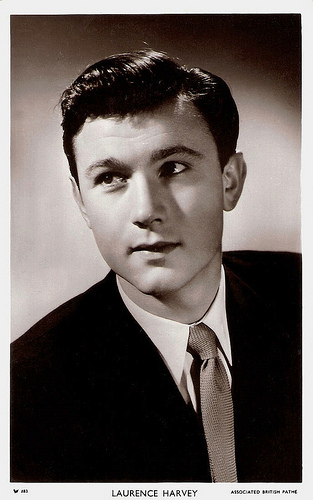
British postcard in the Picturegoer series, London, no. W 883. Photo: British Associated Pathé.
Notorious for his high-spending, high-living ways
Laurence Harvey was now established as an emerging British star. He was cast as the writer Christopher Isherwood in I Am A Camera (Henry Cornelius, 1955), with Julie Harris as Sally Bowles. Later, the musical Cabaret would also be based on the same books by Christopher Isherwood.
Harvey also appeared on American TV and on Broadway. He made his Broadway debut in 1955 in the play Island of Goats. The play closed after one week, though his performance won Harvey a 1956 Theatre World Award. A hit in France was the film Three Men in a Boat (Ken Annakin, 1956) with Shirley Eaton . Harvey appeared twice more on Broadway, in 1957 with Julie Harris in William Wycherley's The Country Wife, and as William Shakespeare's Henry V in 1959, as part of the Old Vic company, which featured a young Judi Dench as Katherine, the Daughter of the King of France.
Jon C. Hopwood writes at IMDb : “The colorful Harvey, a press favorite, became notorious for his high-spending, high-living ways. He found himself frequently in debt, his travails faithfully reported by entertainment columnists. More fame was to come.“
His breakthrough to international stardom came in 1959 when he was cast as the social climber Joe Lampton in Room at the Top (Jack Clayton, 1959). The film was produced by British film producing brothers Sir John and James Woolf of Romulus Films and Remus Films. For his performance, Harvey received a BAFTA Award nomination and a nomination for the Academy Award for Best Actor, the first person of Lithuanian descent to be nominated for an acting Oscar. His co-star, Simone Signoret , did win the Oscar for her performance. Room at the Top (1959) and Look Back in Anger (Tony Richardson, 1959) inaugurated the ‘kitchen sink’ cinema, the New Wave that revolutionized Britain’s film industry.

German postcard by Ufa, Berlin-Tempelhof, no. FK 1322. Photo: J. Arthur Rank Organisation. Publicity still for Romeo and Juliet (1954).
Decline
During the 1960s, Laurence Harvey appeared in several major films. He starred in Butterfield 8 (Daniel Mann, 1960) opposite Elizabeth Taylor, and John Wayne's epic The Alamo (1960), released within a month of each other. Harvey was then cast in the film version of the war drama The Long and the Short and the Tall (Leslie Norman, 1961) with Richard Todd . The role had earlier made Peter O'Toole prominent in the West End, but O'Toole was not yet established in cinema and Harvey was clearly more ‘bankable’.
Other films included Walk on the Wild Side (Edward Dmytryk, 1962) with Barbara Stanwyck, a young Jane Fonda and Capucine ; the film adaptation of Tennessee Williams' Summer and Smoke (Peter Glenville, 1961) with Geraldine Page, and Darling (John Schlesinger, 1965) with Julie Christie and Dirk Bogarde .
He also appeared as a brainwashed former Korean War POW in the Cold War thriller The Manchurian Candidate (John Frankenheimer, 1962). He became very good friends with his co-star Frank Sinatra, and was a member in good standing of high society, then dubbed ‘The Jet Set’.
His career began to decline from the mid-1960s. The remake of W. Somerset Maugham's Of Human Bondage (Ken Hughes, 1964) was a failure, as was The Outrage (Martin Ritt, 1964) starring Paul Newman, a remake of Akira Kurosawa's classic Rashômon (1950). Harvey reprised his Oscar-nominated role as Joe Lampton in the sequel Life at the Top (Ted Kotcheff, 1965), but the film was not a success.
Harvey returned to Britain to make the comedy The Spy with a Cold Nose (Daniel Petri, 1966) with Daliah Lavi . His last hurrah was his appearance in the spy thriller A Dandy in Aspic (1968), of which he took the direction over after the original director Anthony Mann died during shooting.
In settlement of a dispute with Woodfall Films over the rights to The Charge of the Light Brigade (Tony Richardson, 1968), Woodfall cast him in their version as a Russian prince. He performed as cast, but was never seen as the Prince in the finished film. The only part of his performance remaining in the final cut is a brief appearance of him in the background of one shot, as an anonymous member of a theatre audience.
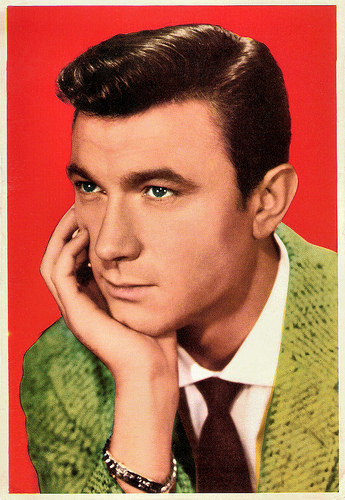
Spanish postcard by Archivo Bermejo, no. C-222. Photo: M.G.M. Publicity still for The Outrage (Martin Ritt, 1964).
Guest murderer of the week
Laurence Harvey played out his career largely in undistinguished films, TV work and the occasional supporting role in a major production. In The Magic Christian (Joseph McGrath, 1969), he recited Hamlet's soliloquy, almost nude and very thin.
A promising project, Orson Welles ' The Deep (1970) with Jeanne Moreau , was never finished. One of his better performances from this period was in an episode of Rod Serling's TV series Night Gallery (1971). He was also guest murderer of the week on Columbo: The Most Dangerous Match (1973) as a chess champion who murders his opponent. He directed himself in the last picture in which he appeared, Welcome to Arrow Beach (1974).
Harvey was married three times. In 1957 he married actress Margaret Leighton, whom he had met on the set of The Good Die Young (1954). They divorced in 1961. His second marriage in 1968 was to Joan Perry Cohn, who was 17 years his senior and the widow of film mogul Harry Cohn of Columbia Pictures. Finally he married Paulene Stone. Harvey met Stone on the set of A Dandy in Aspic, and while still married to Cohn he became a father for the first time when Stone gave birth to a daughter, Domino, in 1969. Eventually, Harvey divorced Cohn and married Stone in 1972.
Harvey was bisexual. His long-term lover was his manager James Woolf, who had discovered Harvey in the 1950s. A heavy smoker and drinker, Harvey died from stomach cancer in 1973. He was only 45. His daughter, Domino (1969–2005), who worked as a bounty hunter, was only 35 when she died. They are buried together in Santa Barbara Cemetery in Santa Barbara, California, USA.
Trailer for Romeo and Juliet (1954). Source: HanseSound Musik und Film GmbH (YouTube).
Complete film I am a camera (1955). Source: LostCinemaChannel (YouTube).
Sources: (IMDb), Wikipedia and .

British postcard in the Picturegoer Series, London, no. D 551. Photo: J. Arthur Rank Organisation. Publicity still for Romeo and Juliet (1954).
A terrific Romeo
Laurence Harvey was born in the town of Joniškis, Lithuania in 1928. He maintained throughout his life that his birth name was Laruschka Mischa Skikne, but it was actually Zvi Mosheh Skikne. He was the youngest of three boys born to Ella Skikne Zotnickaita and Ber Skikne, a Lithuanian Jewish family.
Aged five, his family emigrated to South Africa, where he was known as Harry Skikne. He grew up in Johannesburg, and as a teenager he served with the entertainment unit of the South African Army during the Second World War in Egypt and Italy.
After moving to London, he enrolled in the Royal Academy of Dramatic Art where he became known as Larry. After leaving RADA early, he began to perform on stage in regional theatre. He made his cinema debut as Laurence Harvey in the British horror film House of Darkness (Oswald Mitchell, 1948).
After this the Associated British Picture Corporation (ABPC) offered him a two year contract and he appeared in several of their lower budget films such as the film noir Man on the Run (Lawrence Huntington, 1949) starring Derek Farr, and the narcotics crime drama Cairo Road (David MacDonald, 1950). After failing in the commercial theatre in London's West End, Harvey joined the company of the Shakespeare Memorial Theatre at Stratford-upon-Avon for the 1952 season.
His film career got a boost when he appeared in Women of Twilight (Gordon Parry, 1952) opposite René Ray. This crime drama was made by Romulus Films who signed Harvey to a long-term contract. He secured a small role in a Hollywood film, Knights of the Round Table (Richard Thorpe, 1953), and was cast with Rex Harrison in King Richard and the Crusaders (David Butler, 1954).
That year he also played Romeo in Renato Castellani's adaptation of William Shakespeare's Romeo and Juliet (1954), narrated by John Gielgud . Patrick Hunter at IMDb : “a very worthwhile movie, especially for Shakespeare fans. I personally think Laurence Harvey is a terrific Romeo. Yes, he's a bit of a simp, but that's the character. In fact, Harvey is the screen's best Romeo; he's a lot more passionate than Leslie Howard in the MGM version, and he speaks the verse better than either DiCaprio or Leonard Whiting in the two subsequent versions.”

British postcard in the Picturegoer series, London, no. W 883. Photo: British Associated Pathé.
Notorious for his high-spending, high-living ways
Laurence Harvey was now established as an emerging British star. He was cast as the writer Christopher Isherwood in I Am A Camera (Henry Cornelius, 1955), with Julie Harris as Sally Bowles. Later, the musical Cabaret would also be based on the same books by Christopher Isherwood.
Harvey also appeared on American TV and on Broadway. He made his Broadway debut in 1955 in the play Island of Goats. The play closed after one week, though his performance won Harvey a 1956 Theatre World Award. A hit in France was the film Three Men in a Boat (Ken Annakin, 1956) with Shirley Eaton . Harvey appeared twice more on Broadway, in 1957 with Julie Harris in William Wycherley's The Country Wife, and as William Shakespeare's Henry V in 1959, as part of the Old Vic company, which featured a young Judi Dench as Katherine, the Daughter of the King of France.
Jon C. Hopwood writes at IMDb : “The colorful Harvey, a press favorite, became notorious for his high-spending, high-living ways. He found himself frequently in debt, his travails faithfully reported by entertainment columnists. More fame was to come.“
His breakthrough to international stardom came in 1959 when he was cast as the social climber Joe Lampton in Room at the Top (Jack Clayton, 1959). The film was produced by British film producing brothers Sir John and James Woolf of Romulus Films and Remus Films. For his performance, Harvey received a BAFTA Award nomination and a nomination for the Academy Award for Best Actor, the first person of Lithuanian descent to be nominated for an acting Oscar. His co-star, Simone Signoret , did win the Oscar for her performance. Room at the Top (1959) and Look Back in Anger (Tony Richardson, 1959) inaugurated the ‘kitchen sink’ cinema, the New Wave that revolutionized Britain’s film industry.

German postcard by Ufa, Berlin-Tempelhof, no. FK 1322. Photo: J. Arthur Rank Organisation. Publicity still for Romeo and Juliet (1954).
Decline
During the 1960s, Laurence Harvey appeared in several major films. He starred in Butterfield 8 (Daniel Mann, 1960) opposite Elizabeth Taylor, and John Wayne's epic The Alamo (1960), released within a month of each other. Harvey was then cast in the film version of the war drama The Long and the Short and the Tall (Leslie Norman, 1961) with Richard Todd . The role had earlier made Peter O'Toole prominent in the West End, but O'Toole was not yet established in cinema and Harvey was clearly more ‘bankable’.
Other films included Walk on the Wild Side (Edward Dmytryk, 1962) with Barbara Stanwyck, a young Jane Fonda and Capucine ; the film adaptation of Tennessee Williams' Summer and Smoke (Peter Glenville, 1961) with Geraldine Page, and Darling (John Schlesinger, 1965) with Julie Christie and Dirk Bogarde .
He also appeared as a brainwashed former Korean War POW in the Cold War thriller The Manchurian Candidate (John Frankenheimer, 1962). He became very good friends with his co-star Frank Sinatra, and was a member in good standing of high society, then dubbed ‘The Jet Set’.
His career began to decline from the mid-1960s. The remake of W. Somerset Maugham's Of Human Bondage (Ken Hughes, 1964) was a failure, as was The Outrage (Martin Ritt, 1964) starring Paul Newman, a remake of Akira Kurosawa's classic Rashômon (1950). Harvey reprised his Oscar-nominated role as Joe Lampton in the sequel Life at the Top (Ted Kotcheff, 1965), but the film was not a success.
Harvey returned to Britain to make the comedy The Spy with a Cold Nose (Daniel Petri, 1966) with Daliah Lavi . His last hurrah was his appearance in the spy thriller A Dandy in Aspic (1968), of which he took the direction over after the original director Anthony Mann died during shooting.
In settlement of a dispute with Woodfall Films over the rights to The Charge of the Light Brigade (Tony Richardson, 1968), Woodfall cast him in their version as a Russian prince. He performed as cast, but was never seen as the Prince in the finished film. The only part of his performance remaining in the final cut is a brief appearance of him in the background of one shot, as an anonymous member of a theatre audience.

Spanish postcard by Archivo Bermejo, no. C-222. Photo: M.G.M. Publicity still for The Outrage (Martin Ritt, 1964).
Guest murderer of the week
Laurence Harvey played out his career largely in undistinguished films, TV work and the occasional supporting role in a major production. In The Magic Christian (Joseph McGrath, 1969), he recited Hamlet's soliloquy, almost nude and very thin.
A promising project, Orson Welles ' The Deep (1970) with Jeanne Moreau , was never finished. One of his better performances from this period was in an episode of Rod Serling's TV series Night Gallery (1971). He was also guest murderer of the week on Columbo: The Most Dangerous Match (1973) as a chess champion who murders his opponent. He directed himself in the last picture in which he appeared, Welcome to Arrow Beach (1974).
Harvey was married three times. In 1957 he married actress Margaret Leighton, whom he had met on the set of The Good Die Young (1954). They divorced in 1961. His second marriage in 1968 was to Joan Perry Cohn, who was 17 years his senior and the widow of film mogul Harry Cohn of Columbia Pictures. Finally he married Paulene Stone. Harvey met Stone on the set of A Dandy in Aspic, and while still married to Cohn he became a father for the first time when Stone gave birth to a daughter, Domino, in 1969. Eventually, Harvey divorced Cohn and married Stone in 1972.
Harvey was bisexual. His long-term lover was his manager James Woolf, who had discovered Harvey in the 1950s. A heavy smoker and drinker, Harvey died from stomach cancer in 1973. He was only 45. His daughter, Domino (1969–2005), who worked as a bounty hunter, was only 35 when she died. They are buried together in Santa Barbara Cemetery in Santa Barbara, California, USA.
Trailer for Romeo and Juliet (1954). Source: HanseSound Musik und Film GmbH (YouTube).
Complete film I am a camera (1955). Source: LostCinemaChannel (YouTube).
Sources: (IMDb), Wikipedia and .
Published on July 04, 2015 22:00
July 3, 2015
Pina Menichelli
We are still at Il Cinema Ritrovato 2015 in Bologna. One of the sections is 1915: Cinema of A Hundred Years Ago. The heyday of the dazzling Italian divas, like Francesca Bertini, Lyda Borelli and fascinating and enigmatic Pina Menichelli (1890-1984). With her contorted postures and disdainful expression, she was the most bizarre Italian silent film diva. Her film Il fuoco/The Fire (1915) was shown earlier this week.
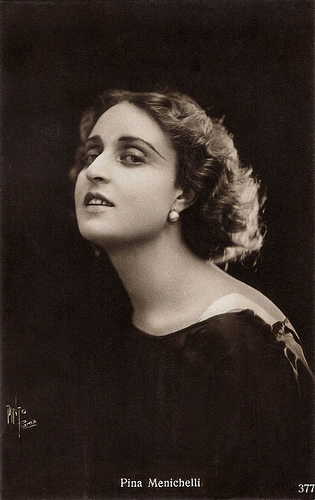
Italian postcard by Ed. A. Traldi, Milano, no. 377. Photo: Pinto, Roma.
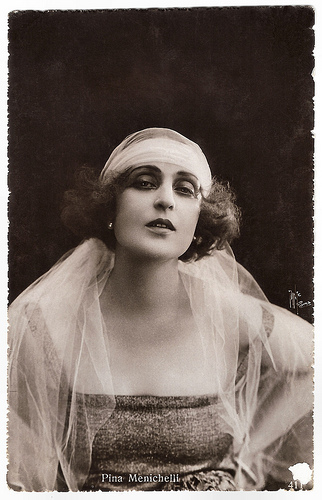
Italian postcard by Ed. A. Traldi, Milano, no. 411. Photo Pinto, Roma.
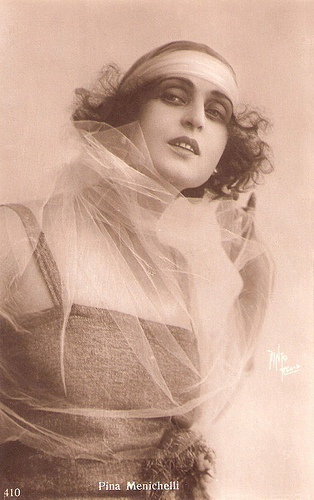
Italian postcard by Ed. A. Traldi, Milano (Milan), no. 410. Photo: Pinto.
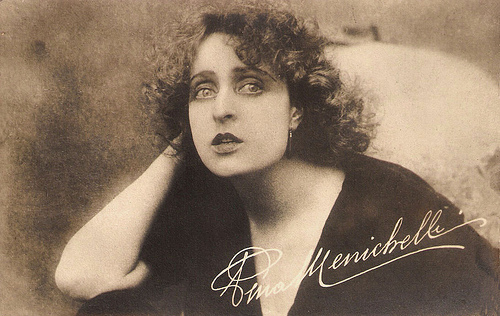
French postcard by BPA, Rueil.
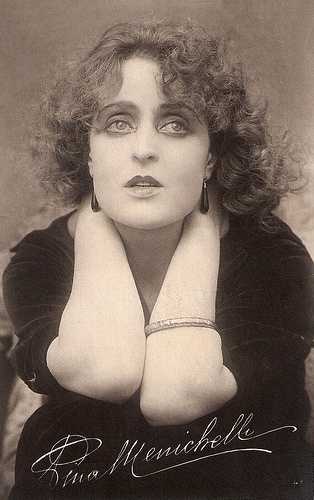
Italian postcard, no. 47.
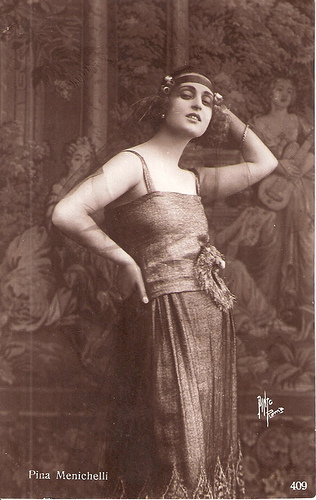
Italian postcard by Ed. A. Traldi, Milano, no. 409. Photo: Pinto, Roma.
Notre Dame des Spasmes
Giuseppina Menichelli was born in Castroreale, Italy, in 1890. She was a sister of singer and actress Dora Menichelli.
After starting her film career at the Roman Cines company in 1913, Pina was catapulted into stardom by Giovanni Pastrone's D'Annunzian film Il Fuoco/The Fire (1915) co-starring with Febo Mari . Il Fuoco tells the love story of a young, vulnerable painter and a wealthy woman. The film's erotic atmosphere caused it to be banned and prompted clerical demonstrations against the film.
Because of her femme fatale, men devouring type, and her extreme and sudden gestures she was nicknamed 'Notre Dame des Spasmes'. Menichelli did however know how to play also in a more restrained way, as Tigre Reale/Royal Tiger (Giovanni Pastrone, 1916) showed.
The script was based on a book by Giovanni Verga and was scripted by the author himself. Verga was a Sicilian writer known for his realist (verismo) fiction rather than for his symbolist-decadent works. Despite this the story of Tigre Reale is a melodrama, full of unlikely twists and turns, but the public was held, mesmerized, by the fascinating and enigmatic Menichelli.
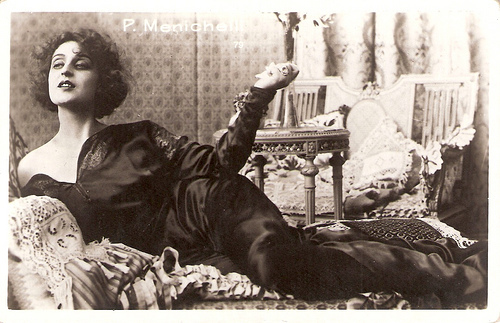
Italian postcard by Ed. Vettori, Bologna. Photo: still from Tigre Reale (Giovanni Pastrone, 1916).
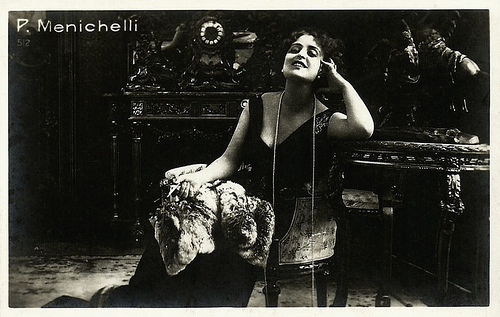
Italian postcard. Photo: probably still from Tigre reale (Giovanni Pastrone, 1916).
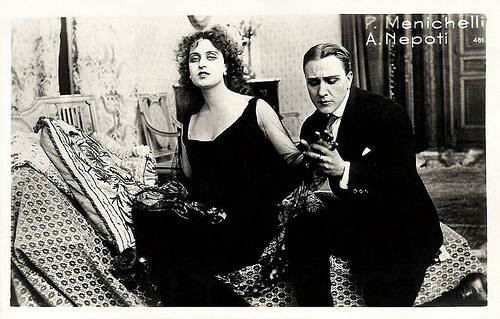
Italian postcard by Vettori, Bologna, no. 461. Pina Menichelli and Alberto Nepoti, probably in Tigre reale (Giovanni Pastrone, 1916).
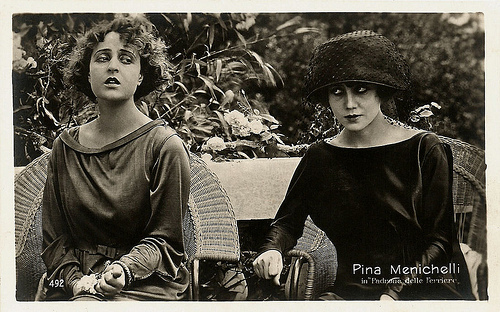
Italian postcard by Vettori, Bologna. Photo: publicity still for Il padrone delle ferriere (Eugenio Perego, 1919). The other actress must be Lina Millefleurs.
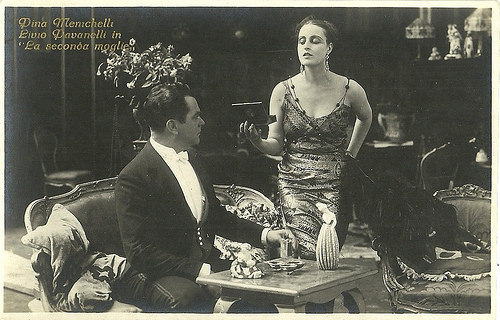
Italian postcard by Edizione G.B. Falci, no. 262. Photo: publicity still of Pina Menichelli and Livio Pavanelli in La seconda moglie (Amleto Palermi, 1922).
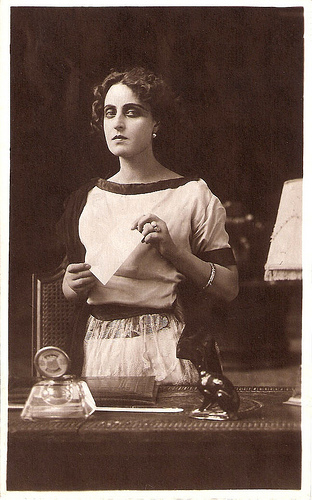
Italian postcard by Rinascimento Film, Roma. Photo: publicity still of Pina Menichelli in La seconda moglie (Amleto Palermi, 1922).
The Letter
La dama de chez Maxim's (Amleto Palermi, 1923) was one of Pina Menichelli's last films. With this film and with Occupati d'Amelia (Telemaco Ruggeri, 1925), both adaptations of boulevard comedies by Georges Feydeau, Menichelli proved she was well able to do comedy and not only melodramatic and 'vampy' films. In both films one of her co-stars was the French comedian Marcel Lévesque , on the far right on the card below.
After these comedies, however, Pina Menichelli withdrew from the cinema and held back any attempt to interview her.
Pina Menichelli died in 1984 in Milan. Fifteen years later she was one of the divas featured in Diva Dolorosa (Peter Delpeut, 1999).
In her fascinating, ironic text, Short Manual for the Aspiring Scenario Writer, the French author Colette gave a typical description of the femme fatale in cinema, largely based on Pina Menichelli.
Talking about the 'arms' of the femme fatale Colette indicates the hat and the rising gorge: "The femme fatale' s hat spares her the necessity, at the absolute apex of her wicked career, of having to expend herself in pantomime. When the spectator sees the evil woman coiffing herself with a spread-winged owl, the head of a stuffed jaguar, a bifid aigrette, or a hairy spider, he no longer has any doubts; he knows just what she is capable of. And the rising gorge? The rising gorge is the imposing and ultimate means by which the evil woman informs the audience that she is about to weep, that she is hesitating on the brink of crime, that she is struggling against steely necessity, or that the police have gotten their hands on the letter. What letter? THE letter."
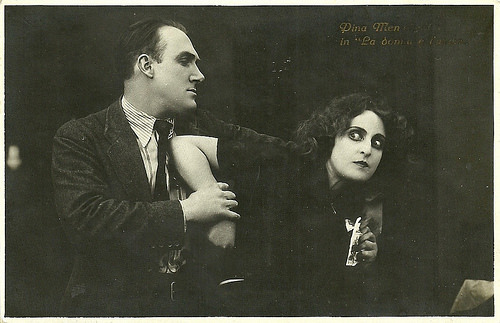
Italian postcard by Ed. G.B. Falci, Milano. Pina Menichelli and Milton Rosmer in the Italian silent film La donna e l'uomo (Amleto Palermi, 1923), produced by Rinascimento Film and distributed by UCI.
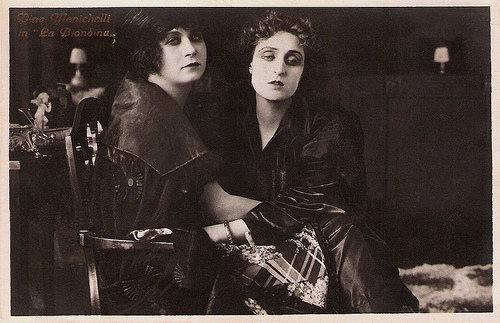
Italian postcard by G.B. Falci, Milano Milan) for one of Pina Menichelli's last films La biondina (Amleto Palermi, 1923), based on a book by Marco Praga and tells the tragedy of a woman whose husband kills her in the end. It seems that Italian censorship forced the scriptwriter to add morality to the film, so Praga's tragedy is framed within a story about a modest, conventional wife who, encouraged by her friend, dreams of breaking out, but then reads Praga's book and decides to remain honest and loyal. The actress on the left on the card could be the friend (Gemma de' Ferrari).
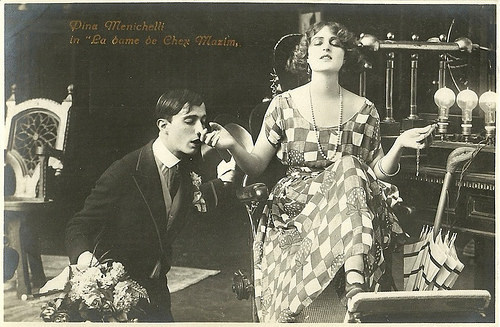
Italian postcard (G.B. Falci, Milano) for Pina Menichelli's last film La dame de Chez Maxim (Amleto Palermi, 1923). Menichelli played the legendary Môme Crevette in one of the many film adaptations of Georges Feydeau's classic boulevard comedy.
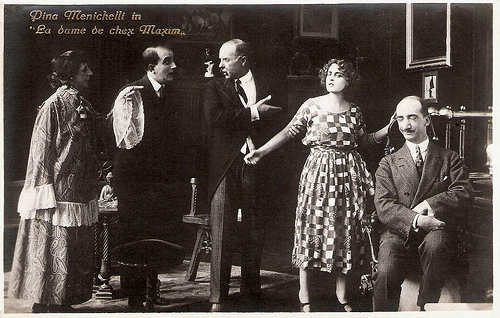
Italian postcard. Photo: G.B. Falci, Milano. Publicity still for La dama de chez Maxim's (1923) with Marcel Lévesque at far right.
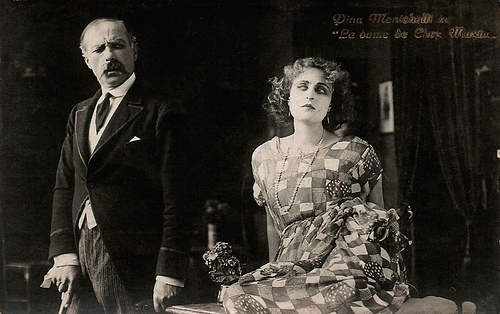
Italian postcard. Photo: G.B. Falci, Milano. Publicity still for La dama de chez Maxim's (1923).
Sources: Vittorio Martinelli (Le dive del silenzio), Greta de Groat (Unsung Divas of the Silent Screen), Il Cinema Ritrovato 2015 and .

Italian postcard by Ed. A. Traldi, Milano, no. 377. Photo: Pinto, Roma.

Italian postcard by Ed. A. Traldi, Milano, no. 411. Photo Pinto, Roma.

Italian postcard by Ed. A. Traldi, Milano (Milan), no. 410. Photo: Pinto.

French postcard by BPA, Rueil.

Italian postcard, no. 47.

Italian postcard by Ed. A. Traldi, Milano, no. 409. Photo: Pinto, Roma.
Notre Dame des Spasmes
Giuseppina Menichelli was born in Castroreale, Italy, in 1890. She was a sister of singer and actress Dora Menichelli.
After starting her film career at the Roman Cines company in 1913, Pina was catapulted into stardom by Giovanni Pastrone's D'Annunzian film Il Fuoco/The Fire (1915) co-starring with Febo Mari . Il Fuoco tells the love story of a young, vulnerable painter and a wealthy woman. The film's erotic atmosphere caused it to be banned and prompted clerical demonstrations against the film.
Because of her femme fatale, men devouring type, and her extreme and sudden gestures she was nicknamed 'Notre Dame des Spasmes'. Menichelli did however know how to play also in a more restrained way, as Tigre Reale/Royal Tiger (Giovanni Pastrone, 1916) showed.
The script was based on a book by Giovanni Verga and was scripted by the author himself. Verga was a Sicilian writer known for his realist (verismo) fiction rather than for his symbolist-decadent works. Despite this the story of Tigre Reale is a melodrama, full of unlikely twists and turns, but the public was held, mesmerized, by the fascinating and enigmatic Menichelli.

Italian postcard by Ed. Vettori, Bologna. Photo: still from Tigre Reale (Giovanni Pastrone, 1916).

Italian postcard. Photo: probably still from Tigre reale (Giovanni Pastrone, 1916).

Italian postcard by Vettori, Bologna, no. 461. Pina Menichelli and Alberto Nepoti, probably in Tigre reale (Giovanni Pastrone, 1916).

Italian postcard by Vettori, Bologna. Photo: publicity still for Il padrone delle ferriere (Eugenio Perego, 1919). The other actress must be Lina Millefleurs.

Italian postcard by Edizione G.B. Falci, no. 262. Photo: publicity still of Pina Menichelli and Livio Pavanelli in La seconda moglie (Amleto Palermi, 1922).

Italian postcard by Rinascimento Film, Roma. Photo: publicity still of Pina Menichelli in La seconda moglie (Amleto Palermi, 1922).
The Letter
La dama de chez Maxim's (Amleto Palermi, 1923) was one of Pina Menichelli's last films. With this film and with Occupati d'Amelia (Telemaco Ruggeri, 1925), both adaptations of boulevard comedies by Georges Feydeau, Menichelli proved she was well able to do comedy and not only melodramatic and 'vampy' films. In both films one of her co-stars was the French comedian Marcel Lévesque , on the far right on the card below.
After these comedies, however, Pina Menichelli withdrew from the cinema and held back any attempt to interview her.
Pina Menichelli died in 1984 in Milan. Fifteen years later she was one of the divas featured in Diva Dolorosa (Peter Delpeut, 1999).
In her fascinating, ironic text, Short Manual for the Aspiring Scenario Writer, the French author Colette gave a typical description of the femme fatale in cinema, largely based on Pina Menichelli.
Talking about the 'arms' of the femme fatale Colette indicates the hat and the rising gorge: "The femme fatale' s hat spares her the necessity, at the absolute apex of her wicked career, of having to expend herself in pantomime. When the spectator sees the evil woman coiffing herself with a spread-winged owl, the head of a stuffed jaguar, a bifid aigrette, or a hairy spider, he no longer has any doubts; he knows just what she is capable of. And the rising gorge? The rising gorge is the imposing and ultimate means by which the evil woman informs the audience that she is about to weep, that she is hesitating on the brink of crime, that she is struggling against steely necessity, or that the police have gotten their hands on the letter. What letter? THE letter."

Italian postcard by Ed. G.B. Falci, Milano. Pina Menichelli and Milton Rosmer in the Italian silent film La donna e l'uomo (Amleto Palermi, 1923), produced by Rinascimento Film and distributed by UCI.

Italian postcard by G.B. Falci, Milano Milan) for one of Pina Menichelli's last films La biondina (Amleto Palermi, 1923), based on a book by Marco Praga and tells the tragedy of a woman whose husband kills her in the end. It seems that Italian censorship forced the scriptwriter to add morality to the film, so Praga's tragedy is framed within a story about a modest, conventional wife who, encouraged by her friend, dreams of breaking out, but then reads Praga's book and decides to remain honest and loyal. The actress on the left on the card could be the friend (Gemma de' Ferrari).

Italian postcard (G.B. Falci, Milano) for Pina Menichelli's last film La dame de Chez Maxim (Amleto Palermi, 1923). Menichelli played the legendary Môme Crevette in one of the many film adaptations of Georges Feydeau's classic boulevard comedy.

Italian postcard. Photo: G.B. Falci, Milano. Publicity still for La dama de chez Maxim's (1923) with Marcel Lévesque at far right.

Italian postcard. Photo: G.B. Falci, Milano. Publicity still for La dama de chez Maxim's (1923).
Sources: Vittorio Martinelli (Le dive del silenzio), Greta de Groat (Unsung Divas of the Silent Screen), Il Cinema Ritrovato 2015 and .
Published on July 03, 2015 22:00
July 2, 2015
Alain Delon
A highlight at Il Cinema Ritrovato 2015 is the open-air screening tonight of Rocco e i suoi fratelli/Rocco and His Brothers (Luchino Visconti, 1960) in a magical black and white, thanks to a new restoration. Today's post is about Alain Delon (1935), the actor who played Rocco in this landmark Italian film. Delon was the breathtakingly good-looking James Dean of the European cinema of the late 1950s and early 1960s who proved in this film that he was also a magnificent actor.
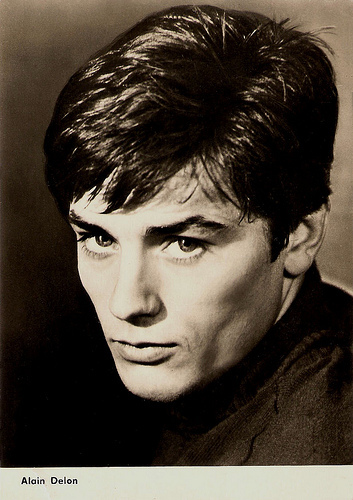
East-German postcard by VEB Progress Film-Vertrieb, Berlin, 1967. retail price: 0,20 MDN.Photo: publicity still for Rocco e i suoi fratelli/Rocco and his brothers (Luchino Visconti, 1960).
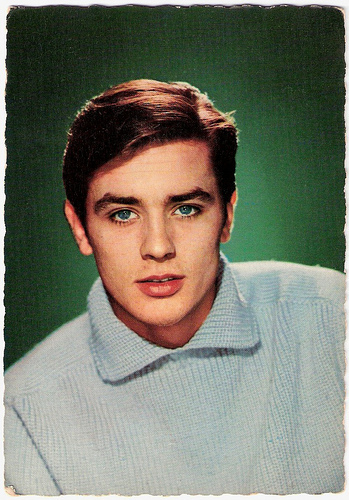
French postcard by E.D.U.G., no. 22. Photo: Sam Lévin.
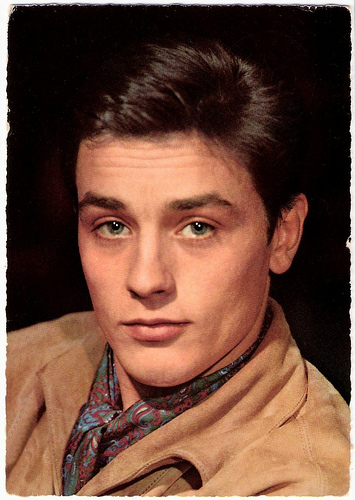
German postcard by Krüger. Photo: Ufa.
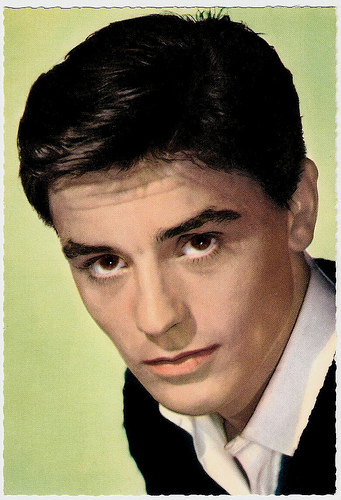
German postcard by ISV, no. H 25.
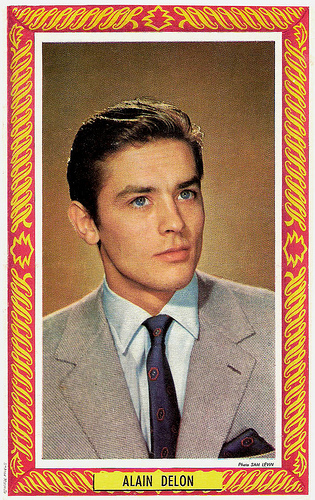
French postcard by St. Anne, Marseille. Photo: Sam Lévin.
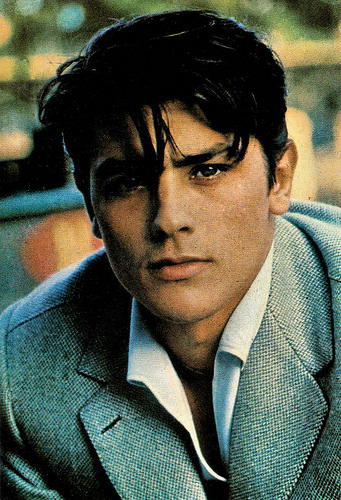
Spanish postcard, no. 161. Photo: Philippe R. Doumic.
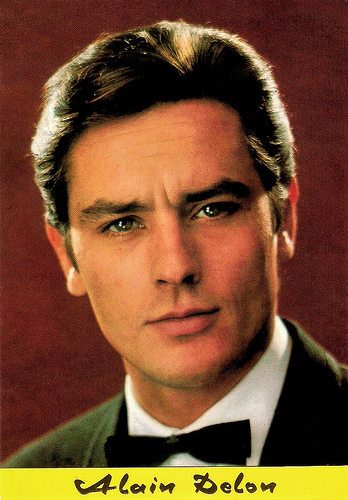
Spanish postcard by Bergas Ind. Graf., Barcelona, no. 463, 1967.
Stormy Childhood
Alain Fabien Maurice Marcel Delon was born in Sceaux, a suburb of Paris in 1935. His parents, Édith Arnold and Fabien Delon, divorced when Delon was four. He had a stormy childhood and was six times expelled from different schools.
At 14, Delon left school, and worked for a brief time at his stepfather Paul Boulogne's butcher shop. Three years later, the 17-year-old enlisted in the French Marines, serving in 1953-1954 in Indochina as a parachutist. In 1956, after being dishonourably discharged from the military, he returned to France. He had little money and worked at various odd jobs, including as a waiter, salesman, and porter in the Les Halles market.
During this time he became friends with the actress Brigitte Auber , and joined her on a trip to the Cannes Film Festival, where his film career would begin with a screentest for David O’Selznick. He didn't go to Hollywood, but decided to stay in France, and he made his film debut in Quand la femmes s'en mele/Send a Woman When the Devil Fails (Yves Allégret, 1957).
In 1958, during the making of the love story Christine (Pierre Gaspard-Huit, 1959) he met Romy Schneider . They would be engaged till 1964.
Delon’s first outstanding success came with the role of the parasite Tom Ripley in the sundrenched thriller Plein soleil/Purple Noon (René Clément, 1960), based on the crime novel The Talented Mr. Ripley by Patricia Highsmith. Delon presented a psychological portrait of a murderous young cynic who attempts to take on the identity of his victim. The cricics liked his performance. According to Wikipedia , Highsmith herself was also a fan of his portrayal.
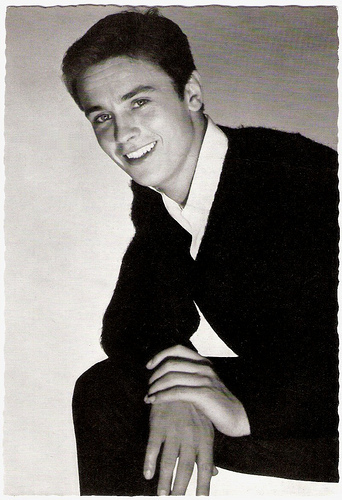
German postcard by WS-Druck, Wanne Eickel, no. 419. Photo: Sam Lévin, 1957.
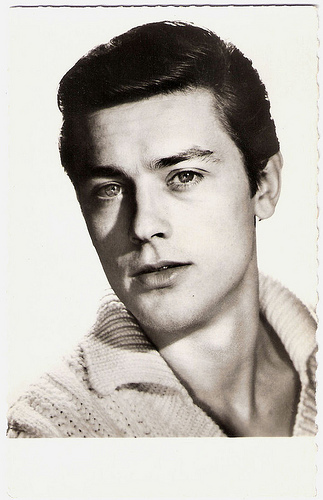
French postcard by Editions P.I., no. 1004. Offered by Les Carbones Korès 'Carboplane'. Photo: Sam Lévin.
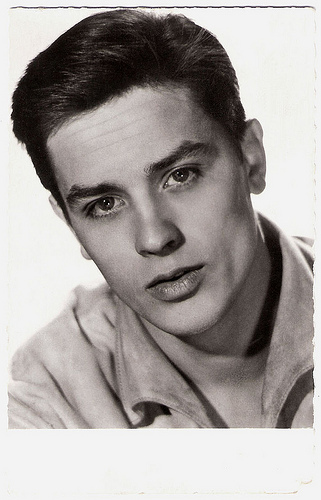
French postcard by Editions P.I., no. 1026. Photo: Sam Lévin.
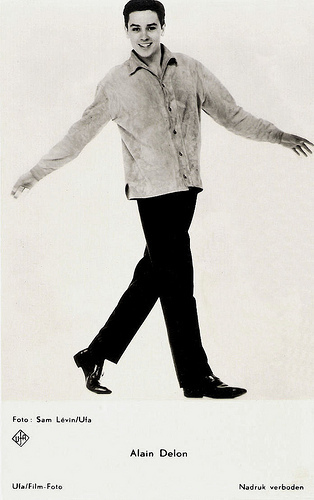
Belgian postcard by D.R.C, licency holder for Belgium and Belgian Congo of Universum Aktiengesellschaft, Berlin-Tempelhof, no. 4615. Photo: Sam Lévin / UFA.
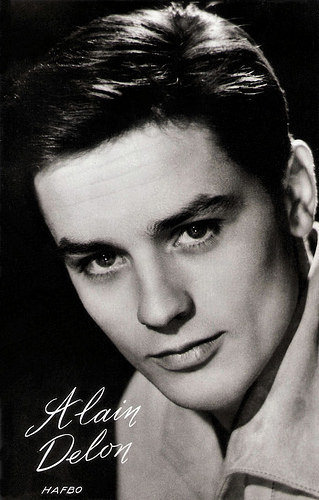
Dutch postcard by Muziekparade, Hilversum, no. AX 4701. Photo: Hafbo / Sam Lévin.
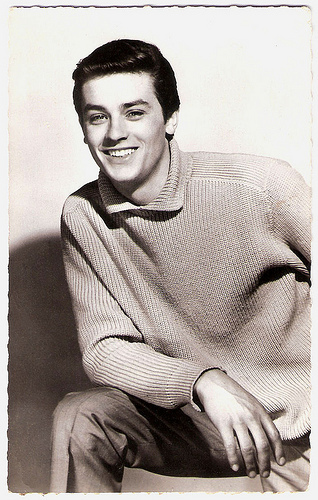
French postcard by Editions du Globe (EDUG), Paris, no. 838. Photo: Sam Lévin.
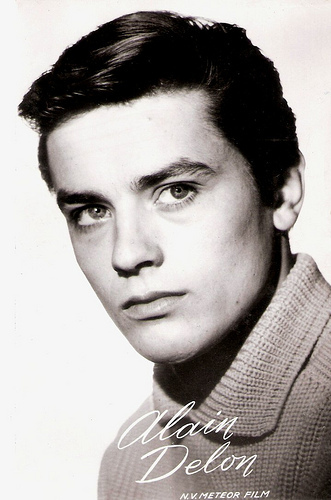
Dutch postcard by Uitg. Takken, Utrecht, no. 3980. Photo: N.V. Meteor Film / Speva / Play Art Prod. Publicity still for Christine/Liebelei (Pierre Gaspard-Huit, 1958).
The Eclipse
Luchino Visconti offered Alain Delon a totally different role in Rocco e i suoi fratelli/Rocco and His Brothers (Luchino Visconti, 1960). In this film, he plays the devoted Sicilian immigrant Rocco, who accepts the greatest sacrifices to save his characterless brother Simon, played by Renato Salvatori. Delon received international recognition for this role.
The following year Alain Delon made his stage debut in Paris in Dommage qu'elle soit une putain/'Tis Pity She’s a Whore, alongside Romy Schneider . The play, written by John Ford, was directed by Luchino Visconti. The production cost a reported 60 million francs and broke box office records. It ran for more than 8 months.
Delon also gave tremendous performances in L'Eclisse/The Eclipse (Michelangelo Antonioni, 1962) opposite Monica Vitti , and the epic Il Gattopardo/The Leopard (Luchino Visconti, 1963) starring opposite Burt Lancaster and Claudia Cardinale . L’Eclisse won the Special Prize of the jury at the Cannes Film Festival, and the following year Il Gattopardo won the Golden Palm in Cannes.
After these acclaimed Italian films, Alain Delon returned to France and to the crime film in Mélodie en sous-sol/The Big Snatch (Henri Verneuil, 1963) with Jean Gabin . This classic genre film was distinguished by a soundly worked-out screenplay, by careful production and by excellent performances of both Gabin and Delon.
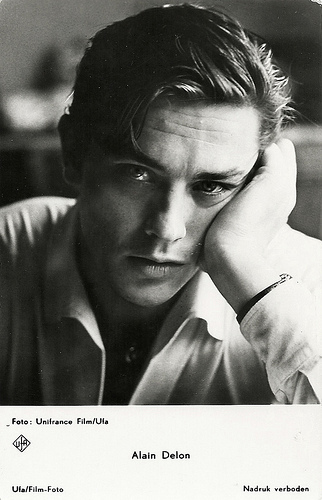
Dutch postcard by Gebr. Spanjersberg, Rotterdam, no. 1383. Photo: Unifrance Film / Ufa.
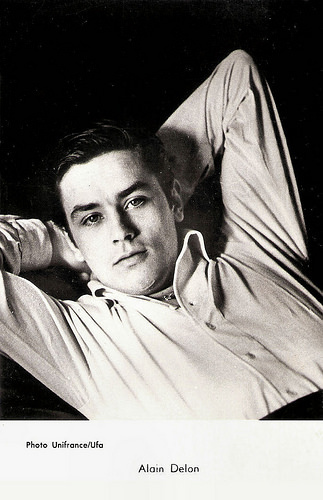
French postcard by Editions P.I., Paris, no. FK 44. Photo: Unifrance / Ufa.
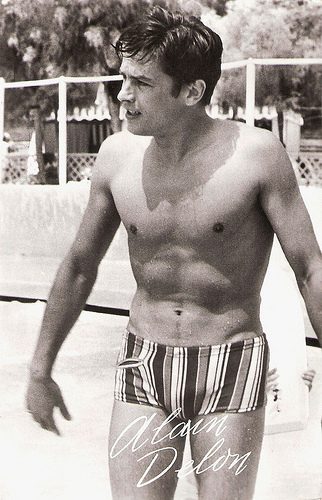
Dutch postcard by 't Sticht, Utrecht, no. 6176.
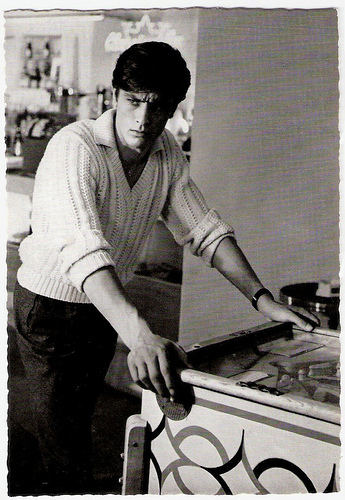
German postcard by WS-Druck, Wanne-Eickel, no. 444. Photo: Privat.
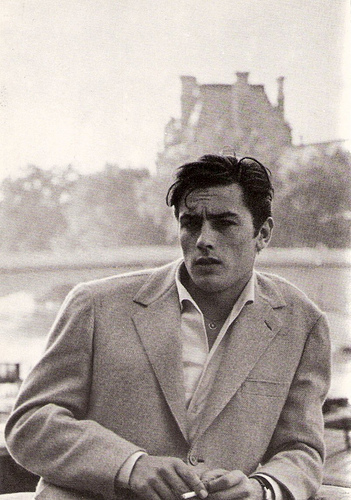
French postcard by Editions P.I., Paris, no. FK 42. Photo: Unifrance Film / Philippe R. Doumic.
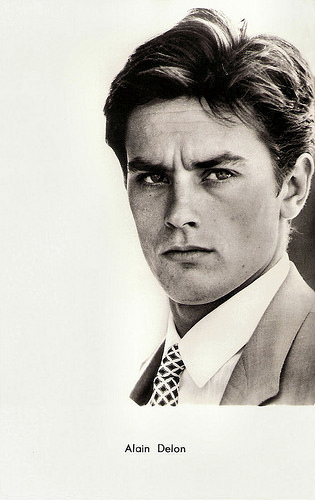
French postcard by Editions P.I., no. 1151A, offered by Les Carbones Korès 'Carboplane.
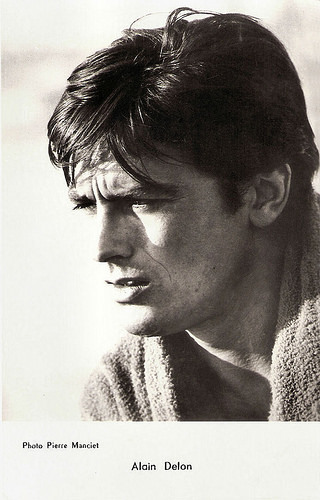
French postcard by Editions P.I., no. 1161, offered by Les Carbones Korès 'Carboplane. Photo: Pierre Manciet.
A bid for American stardom
By now Hollywood studios were very interested in him and Alain Delon decided to make a bid for American stardom. In 1965, MGM signed him to a five picture contract. The first movie of this deal was Les Félins/Joy House (René Clément, 1964), shot in France with Jane Fonda. He then followed it up with two more films for the studio: the all-star The Yellow Rolls Royce (Anthony Asquith, 1965), in which Delon had a relatively small role, and Once a Thief (Ralph Nelson, 1965), where he co-starred with Ann-Margret.
Delon signed a three picture deal with Columbia, for whom he appeared in the big budget action film Lost Command (Mark Robson, 1966) with Anthony Quinn. Universal Studios used Delon in a Western, opposite Dean Martin, Texas Across the River (Michael Gordon, 1966).
For Seven Arts he starred in Paris brûle-t-il?/Is Paris Burning? (René Clément, 1966) about the liberation of Paris in August 1944 by the French Resistance and the Free French Forces. This was a massive hit in France but performed disappointingly at the US box office - as did all of Delon's Hollywood financed films. After six Hollywood movies Delon returned to France.
In the late sixties, Delon came to epitomise the calm, psychopathic hoodlum, staring into the camera like a cat assessing a mouse. His tough, ruthless side was used to grand effect in Le Samouraï/The Godson (Jean-Pierre Melville, 1967), maybe Delon’s finest moment. Later Melville directed him again in the crime films Le Cercle Rouge/The Red Circle (1970) with Bourvil and Yves Montand , and Un Flic/A Cop (1972) with Catherine Deneuve .
In 1968 Delon also in real life got involved in a murder scandal when one of his bodyguard was found shot dead on a garbage dump nearby Delon's house. Eventually Delon was cleared of all charges.
In the cinema, he had a huge success in the bloodstained Borsalino (1970, Jacques Deray). He and Jean-Paul Belmondo played small-time gangsters who become kings of the Marseilles underworld of the 1930s. He also produced Borsalino, and the film became one of France’s highest grossing films of the time. Between 1968 and 1990 he went on to produce 26 films.
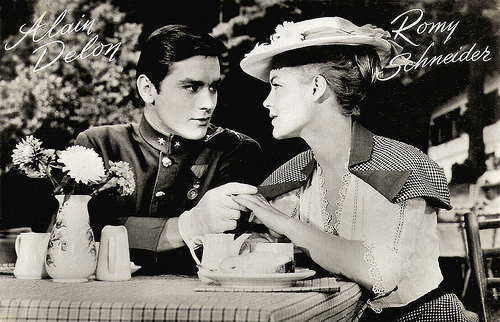
Dutch postcard by Takken, Utrecht. Photo: NV Meteor Film. Publicity still for Christine/Liebelei (Pierre Gaspard-Huit, 1958) with Romy Schneider .
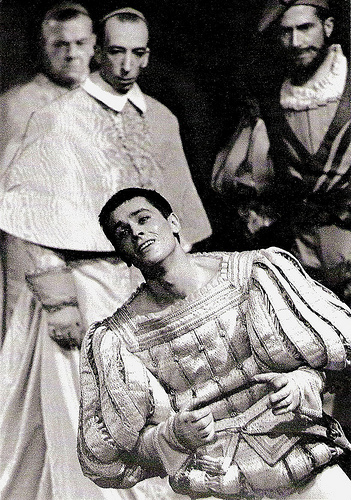
French postcard by the Bibliothèque Nationale Paris / Imp. Bussière A.G., Paris, 1990. Photo: Roger Pic. Alain Delon in the play Dommage qu'elle soit une p.../'Tis Pity She’s a Whore directed by Luchino Visconti (1961).
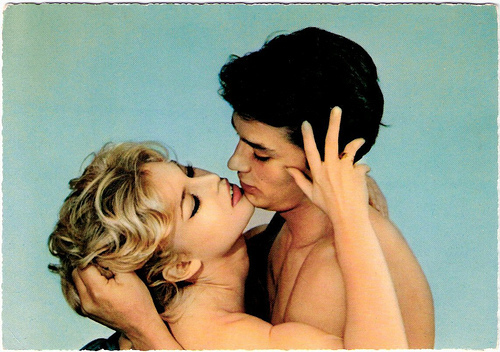
German postcard by Krüger, no. 902/95. Photo Sam Lévin. Another sexy publicity photo for Amours célèbres (Michel Boisrond, 1961) with Brigitte Bardot .

Small Romanian collectors card by Casa Filmului Acin. Photo: publicity still for L'eclisse/The Eclypse (Michelangelo Antonioni, 1962) with Monica Vitti.
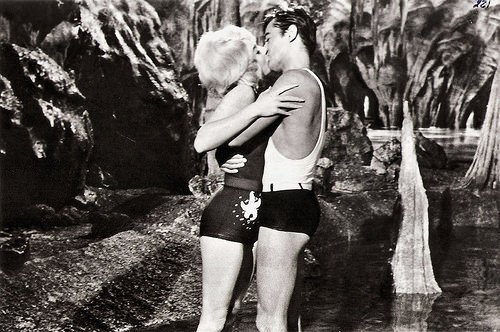
Romanian postcard by Casa Filmului Acin, no. 313. Photo: publicity still for The Yellow Rolls-Royce (Anthony Asquith, 1964) with Shirley MacLaine.
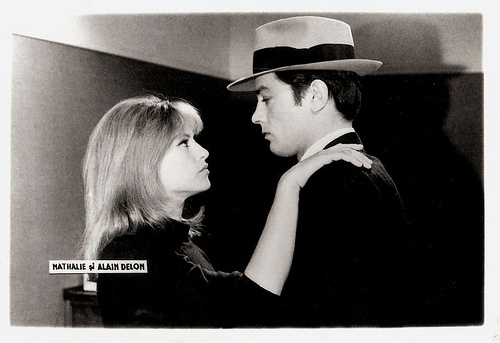
Small Romanian collectors card. Photo: publicity still for Le Samouraï (Jean-Pierre Melville, 1967) with Nathalie Delon .
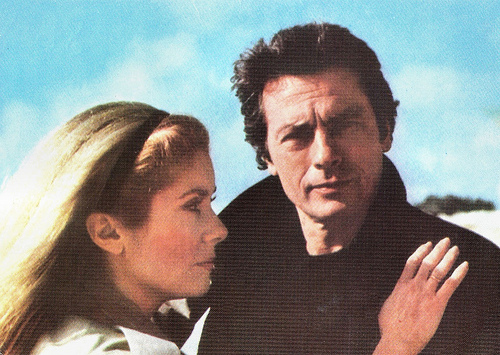
Romanian postcard by Casa Filmului Acin. Photo: publicity still for Le choc/Shock (Robin Davis, 1982) with Catherine Deneuve.
Roles Against Type
In later years Alain Delon won critical acclaim for roles against type. In the Kafkaesk thriller Mr. Klein (Joseph Losey, 1976) he was brilliant as the icily sinister art trader in German-occupied France.
In 1985 he was awarded the César Award as Best Actor for his role as an alcoholic in Notre histoire/Our Story (Bertrand Blier, 1984). Another acclaimed role was the homosexual Baron de Charlus in the fine Marcel Proust adaptation Un amour de Swann/Swann in Love (Volker Schlöndorf, 1984).
And in 1990, Delon worked with New Wave auteur Jean-Luc Godard on Nouvelle vague/New Wave (1990), in which he played twins. He also directed two films himself, Pour la peau d'un flic/For a Cop's Hide (1981) and Le Battant/The Fighter (1983).
A string of box office disasters in the next years culminated in 1998 in the unexpected failure of Une chance sur deux/Half a Chance (Patrice Leconte, 1998) in which Alain Delon was reunited with Jean-Paul Belmondo . Delon announced that he would give up acting.
For his impressive film career he received the Legion d'Honneur, the highest French decoration. Delon acquired Swiss citizenship in 1999, and the company managing products sold under his name is based in Geneva. Since the formation of a perfume label in his name, Delon has had a variety of products sold under his name including wristwatches, clothing, eyewear, stationery and cigarettes.
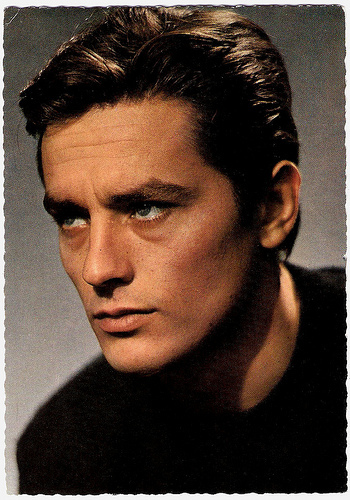
French postcard by E.D.U.G., no. 469. Photo: Sam Lévin.
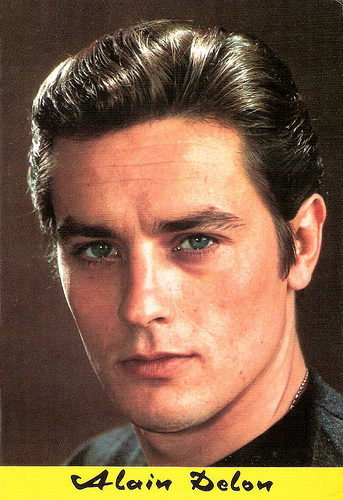
Spanish postcard by Bergas Ind. Graf., no. 572.

Romanian postcard by Casa Filmului Acin.
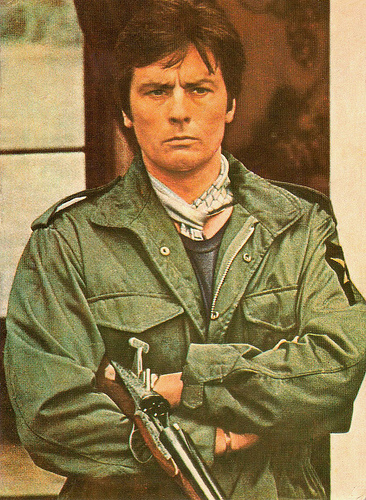
Romanian postcard by Casa Filmului Acin.
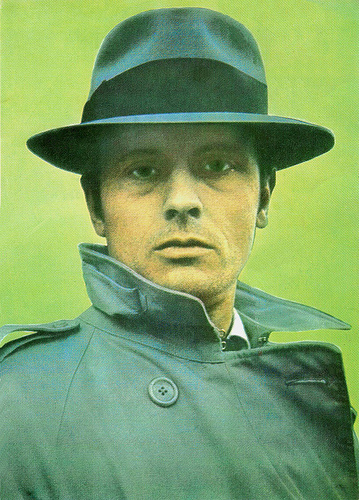
Romanian postcard by Casa Filmului Acin.
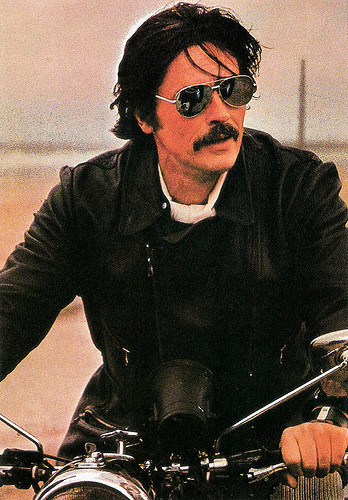
French postcard by Editions F. Nugeron, no. Star 28.
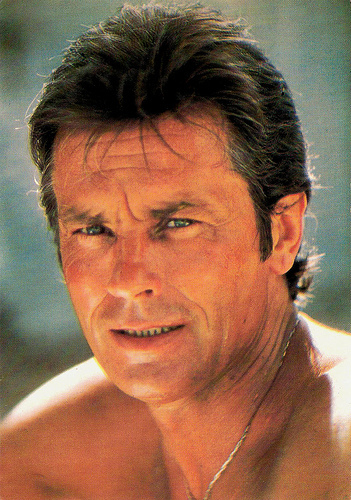
French postcard by Editions P.I., Paris, no. 3453. Photo: Michel Ginfray.
Astérix
Alain Delon returned in the cinema as Julius Cesar in Astérix aux Jeux Olympiques/Asterix at the Olympic Games (Frederic Forestier, Thomas Langmann, 2008), and he reunited with former girlfriend Mireille Darc in a stage adaptation of The Bridges of Madison County by Robert James Waller at the Marigny Theatre in Paris.
Alain Delon has a son, Christian Aaron Boulogne 'Ari' Päffgen (1962), from a relationship with German singer/supermodel Nico. The child was raised mostly by Delon's mother and stepfather. He broke the relationship with his mother after she insisted on taking care of Ari. They spoke again when his step-father died in 1988, the same year Nico died.
From his first marriage to Nathalie Delon (Nathalie Barthélemy) he has another son, Anthony Delon (1964), who also acted in a number of films. Then he was a longtime companion of actress Mireille Darc from 1968 to 1982. Then he had a relationship with Anne Parillaud.
From his second marriage with former Dutch model Rosalie van Breemen he has a son Alain-Fabien (1990) and a daughter Anouchka (1994). Rosalie was 21 when she met Alain who was 52. They lived together from 1987 till 2001.
Today, Alain Delon lives in Geneva, Switzerland. He acquired Swiss citizenship in 1999, and the company managing products sold under his name is based in Geneva. His most recent film appearance was in the Russian comedy S Novym godom, mamy!/Happy New Year, Mommies! (Artyom Aksyonenko, Sarik Andreasyan, Anton Bormatov, Dmitriy Grachev, Klim Poplavskiy, 2012).
Trailer for Plein Soleil/Purple Noon (1960). Source: Criterion Dungeon (YouTube)
Trailer Rocco e i suoi fratelli/Rocco and his Brothers (1960). Source: Filmmuseum Amsterdam (YouTube).
Trailer for Mélodie en sous-sol/The Big Snatch (1963). Source: Curtis Hayden (YouTube).
Trailer Le Samouraï/The Godson (1967). Source: Edwin Nieves (YouTube).
Trailer La Piscine/The Pool (1968). Source: Filmmuseum Amsterdam (YouTube).
Sources: Alain Delon.ch, Wikipedia, (IMDb), Il Cinema Ritrovato and .

East-German postcard by VEB Progress Film-Vertrieb, Berlin, 1967. retail price: 0,20 MDN.Photo: publicity still for Rocco e i suoi fratelli/Rocco and his brothers (Luchino Visconti, 1960).

French postcard by E.D.U.G., no. 22. Photo: Sam Lévin.

German postcard by Krüger. Photo: Ufa.

German postcard by ISV, no. H 25.

French postcard by St. Anne, Marseille. Photo: Sam Lévin.

Spanish postcard, no. 161. Photo: Philippe R. Doumic.

Spanish postcard by Bergas Ind. Graf., Barcelona, no. 463, 1967.
Stormy Childhood
Alain Fabien Maurice Marcel Delon was born in Sceaux, a suburb of Paris in 1935. His parents, Édith Arnold and Fabien Delon, divorced when Delon was four. He had a stormy childhood and was six times expelled from different schools.
At 14, Delon left school, and worked for a brief time at his stepfather Paul Boulogne's butcher shop. Three years later, the 17-year-old enlisted in the French Marines, serving in 1953-1954 in Indochina as a parachutist. In 1956, after being dishonourably discharged from the military, he returned to France. He had little money and worked at various odd jobs, including as a waiter, salesman, and porter in the Les Halles market.
During this time he became friends with the actress Brigitte Auber , and joined her on a trip to the Cannes Film Festival, where his film career would begin with a screentest for David O’Selznick. He didn't go to Hollywood, but decided to stay in France, and he made his film debut in Quand la femmes s'en mele/Send a Woman When the Devil Fails (Yves Allégret, 1957).
In 1958, during the making of the love story Christine (Pierre Gaspard-Huit, 1959) he met Romy Schneider . They would be engaged till 1964.
Delon’s first outstanding success came with the role of the parasite Tom Ripley in the sundrenched thriller Plein soleil/Purple Noon (René Clément, 1960), based on the crime novel The Talented Mr. Ripley by Patricia Highsmith. Delon presented a psychological portrait of a murderous young cynic who attempts to take on the identity of his victim. The cricics liked his performance. According to Wikipedia , Highsmith herself was also a fan of his portrayal.

German postcard by WS-Druck, Wanne Eickel, no. 419. Photo: Sam Lévin, 1957.

French postcard by Editions P.I., no. 1004. Offered by Les Carbones Korès 'Carboplane'. Photo: Sam Lévin.

French postcard by Editions P.I., no. 1026. Photo: Sam Lévin.

Belgian postcard by D.R.C, licency holder for Belgium and Belgian Congo of Universum Aktiengesellschaft, Berlin-Tempelhof, no. 4615. Photo: Sam Lévin / UFA.

Dutch postcard by Muziekparade, Hilversum, no. AX 4701. Photo: Hafbo / Sam Lévin.

French postcard by Editions du Globe (EDUG), Paris, no. 838. Photo: Sam Lévin.

Dutch postcard by Uitg. Takken, Utrecht, no. 3980. Photo: N.V. Meteor Film / Speva / Play Art Prod. Publicity still for Christine/Liebelei (Pierre Gaspard-Huit, 1958).
The Eclipse
Luchino Visconti offered Alain Delon a totally different role in Rocco e i suoi fratelli/Rocco and His Brothers (Luchino Visconti, 1960). In this film, he plays the devoted Sicilian immigrant Rocco, who accepts the greatest sacrifices to save his characterless brother Simon, played by Renato Salvatori. Delon received international recognition for this role.
The following year Alain Delon made his stage debut in Paris in Dommage qu'elle soit une putain/'Tis Pity She’s a Whore, alongside Romy Schneider . The play, written by John Ford, was directed by Luchino Visconti. The production cost a reported 60 million francs and broke box office records. It ran for more than 8 months.
Delon also gave tremendous performances in L'Eclisse/The Eclipse (Michelangelo Antonioni, 1962) opposite Monica Vitti , and the epic Il Gattopardo/The Leopard (Luchino Visconti, 1963) starring opposite Burt Lancaster and Claudia Cardinale . L’Eclisse won the Special Prize of the jury at the Cannes Film Festival, and the following year Il Gattopardo won the Golden Palm in Cannes.
After these acclaimed Italian films, Alain Delon returned to France and to the crime film in Mélodie en sous-sol/The Big Snatch (Henri Verneuil, 1963) with Jean Gabin . This classic genre film was distinguished by a soundly worked-out screenplay, by careful production and by excellent performances of both Gabin and Delon.

Dutch postcard by Gebr. Spanjersberg, Rotterdam, no. 1383. Photo: Unifrance Film / Ufa.

French postcard by Editions P.I., Paris, no. FK 44. Photo: Unifrance / Ufa.

Dutch postcard by 't Sticht, Utrecht, no. 6176.

German postcard by WS-Druck, Wanne-Eickel, no. 444. Photo: Privat.

French postcard by Editions P.I., Paris, no. FK 42. Photo: Unifrance Film / Philippe R. Doumic.

French postcard by Editions P.I., no. 1151A, offered by Les Carbones Korès 'Carboplane.

French postcard by Editions P.I., no. 1161, offered by Les Carbones Korès 'Carboplane. Photo: Pierre Manciet.
A bid for American stardom
By now Hollywood studios were very interested in him and Alain Delon decided to make a bid for American stardom. In 1965, MGM signed him to a five picture contract. The first movie of this deal was Les Félins/Joy House (René Clément, 1964), shot in France with Jane Fonda. He then followed it up with two more films for the studio: the all-star The Yellow Rolls Royce (Anthony Asquith, 1965), in which Delon had a relatively small role, and Once a Thief (Ralph Nelson, 1965), where he co-starred with Ann-Margret.
Delon signed a three picture deal with Columbia, for whom he appeared in the big budget action film Lost Command (Mark Robson, 1966) with Anthony Quinn. Universal Studios used Delon in a Western, opposite Dean Martin, Texas Across the River (Michael Gordon, 1966).
For Seven Arts he starred in Paris brûle-t-il?/Is Paris Burning? (René Clément, 1966) about the liberation of Paris in August 1944 by the French Resistance and the Free French Forces. This was a massive hit in France but performed disappointingly at the US box office - as did all of Delon's Hollywood financed films. After six Hollywood movies Delon returned to France.
In the late sixties, Delon came to epitomise the calm, psychopathic hoodlum, staring into the camera like a cat assessing a mouse. His tough, ruthless side was used to grand effect in Le Samouraï/The Godson (Jean-Pierre Melville, 1967), maybe Delon’s finest moment. Later Melville directed him again in the crime films Le Cercle Rouge/The Red Circle (1970) with Bourvil and Yves Montand , and Un Flic/A Cop (1972) with Catherine Deneuve .
In 1968 Delon also in real life got involved in a murder scandal when one of his bodyguard was found shot dead on a garbage dump nearby Delon's house. Eventually Delon was cleared of all charges.
In the cinema, he had a huge success in the bloodstained Borsalino (1970, Jacques Deray). He and Jean-Paul Belmondo played small-time gangsters who become kings of the Marseilles underworld of the 1930s. He also produced Borsalino, and the film became one of France’s highest grossing films of the time. Between 1968 and 1990 he went on to produce 26 films.

Dutch postcard by Takken, Utrecht. Photo: NV Meteor Film. Publicity still for Christine/Liebelei (Pierre Gaspard-Huit, 1958) with Romy Schneider .

French postcard by the Bibliothèque Nationale Paris / Imp. Bussière A.G., Paris, 1990. Photo: Roger Pic. Alain Delon in the play Dommage qu'elle soit une p.../'Tis Pity She’s a Whore directed by Luchino Visconti (1961).

German postcard by Krüger, no. 902/95. Photo Sam Lévin. Another sexy publicity photo for Amours célèbres (Michel Boisrond, 1961) with Brigitte Bardot .

Small Romanian collectors card by Casa Filmului Acin. Photo: publicity still for L'eclisse/The Eclypse (Michelangelo Antonioni, 1962) with Monica Vitti.

Romanian postcard by Casa Filmului Acin, no. 313. Photo: publicity still for The Yellow Rolls-Royce (Anthony Asquith, 1964) with Shirley MacLaine.

Small Romanian collectors card. Photo: publicity still for Le Samouraï (Jean-Pierre Melville, 1967) with Nathalie Delon .

Romanian postcard by Casa Filmului Acin. Photo: publicity still for Le choc/Shock (Robin Davis, 1982) with Catherine Deneuve.
Roles Against Type
In later years Alain Delon won critical acclaim for roles against type. In the Kafkaesk thriller Mr. Klein (Joseph Losey, 1976) he was brilliant as the icily sinister art trader in German-occupied France.
In 1985 he was awarded the César Award as Best Actor for his role as an alcoholic in Notre histoire/Our Story (Bertrand Blier, 1984). Another acclaimed role was the homosexual Baron de Charlus in the fine Marcel Proust adaptation Un amour de Swann/Swann in Love (Volker Schlöndorf, 1984).
And in 1990, Delon worked with New Wave auteur Jean-Luc Godard on Nouvelle vague/New Wave (1990), in which he played twins. He also directed two films himself, Pour la peau d'un flic/For a Cop's Hide (1981) and Le Battant/The Fighter (1983).
A string of box office disasters in the next years culminated in 1998 in the unexpected failure of Une chance sur deux/Half a Chance (Patrice Leconte, 1998) in which Alain Delon was reunited with Jean-Paul Belmondo . Delon announced that he would give up acting.
For his impressive film career he received the Legion d'Honneur, the highest French decoration. Delon acquired Swiss citizenship in 1999, and the company managing products sold under his name is based in Geneva. Since the formation of a perfume label in his name, Delon has had a variety of products sold under his name including wristwatches, clothing, eyewear, stationery and cigarettes.

French postcard by E.D.U.G., no. 469. Photo: Sam Lévin.

Spanish postcard by Bergas Ind. Graf., no. 572.

Romanian postcard by Casa Filmului Acin.

Romanian postcard by Casa Filmului Acin.

Romanian postcard by Casa Filmului Acin.

French postcard by Editions F. Nugeron, no. Star 28.

French postcard by Editions P.I., Paris, no. 3453. Photo: Michel Ginfray.
Astérix
Alain Delon returned in the cinema as Julius Cesar in Astérix aux Jeux Olympiques/Asterix at the Olympic Games (Frederic Forestier, Thomas Langmann, 2008), and he reunited with former girlfriend Mireille Darc in a stage adaptation of The Bridges of Madison County by Robert James Waller at the Marigny Theatre in Paris.
Alain Delon has a son, Christian Aaron Boulogne 'Ari' Päffgen (1962), from a relationship with German singer/supermodel Nico. The child was raised mostly by Delon's mother and stepfather. He broke the relationship with his mother after she insisted on taking care of Ari. They spoke again when his step-father died in 1988, the same year Nico died.
From his first marriage to Nathalie Delon (Nathalie Barthélemy) he has another son, Anthony Delon (1964), who also acted in a number of films. Then he was a longtime companion of actress Mireille Darc from 1968 to 1982. Then he had a relationship with Anne Parillaud.
From his second marriage with former Dutch model Rosalie van Breemen he has a son Alain-Fabien (1990) and a daughter Anouchka (1994). Rosalie was 21 when she met Alain who was 52. They lived together from 1987 till 2001.
Today, Alain Delon lives in Geneva, Switzerland. He acquired Swiss citizenship in 1999, and the company managing products sold under his name is based in Geneva. His most recent film appearance was in the Russian comedy S Novym godom, mamy!/Happy New Year, Mommies! (Artyom Aksyonenko, Sarik Andreasyan, Anton Bormatov, Dmitriy Grachev, Klim Poplavskiy, 2012).
Trailer for Plein Soleil/Purple Noon (1960). Source: Criterion Dungeon (YouTube)
Trailer Rocco e i suoi fratelli/Rocco and his Brothers (1960). Source: Filmmuseum Amsterdam (YouTube).
Trailer for Mélodie en sous-sol/The Big Snatch (1963). Source: Curtis Hayden (YouTube).
Trailer Le Samouraï/The Godson (1967). Source: Edwin Nieves (YouTube).
Trailer La Piscine/The Pool (1968). Source: Filmmuseum Amsterdam (YouTube).
Sources: Alain Delon.ch, Wikipedia, (IMDb), Il Cinema Ritrovato and .
Published on July 02, 2015 22:00
Imported from the USA: Buster Keaton
At Il Cinema Ritrovato 2015 (27 June - 4 July 2015) in Bologna, a new, multi-year project starts with brand new restorations of the films of Buster Keaton (1895–1966). The Keaton Project will be launched with the screening of the silent short One Week (1920) and with the silent feature Sherlock Jr. (1924), an early example of film within a film. The film showcases all of Buster Keaton’s virtues: his deadpan humour, his innovative technical accomplishments, his amazing stunts and perfect gags. The two restorations will be presented tonight in Piazza Maggiore in Bologna accompanied live by Timothy Brock’s original scores and performed by the Bologna Opera House Orchestra.
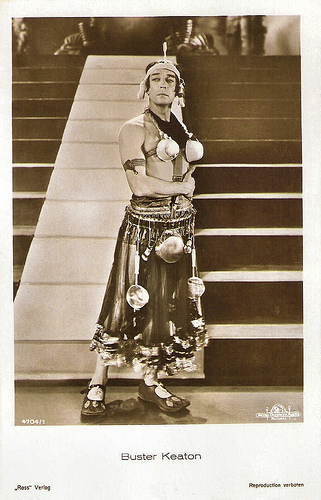
German postcard by Ross Verlag, no. 4704/1, 1929-1930. Photo: MGM. Publicity still for The Hollywood Revue of 1929 (Charles Reisner, 1929) with Keaton as Princess Raja. This performance must have been inspired by the Egyptian dance in The Cook (Roscoe 'Fatty' Arbuckle, 1918).
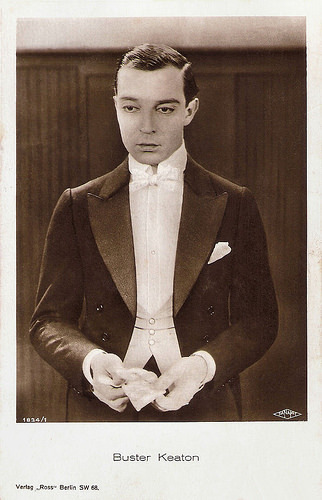
German postcard by Ross Verlag, no. 1834/1, 1927-1928. Photo: Fanamet. Publicity still for Spite Marriage (Edward Sedgewick, Buster Keaton, 1929).
The great stone face
Buster Keaton was born Joseph Frank Keaton in 1895 into a vaudeville family. His father was Joseph Hallie ‘Joe’ Keaton, who owned a travelling show with Harry Houdini called the Mohawk Indian Medicine Company. Keaton was born in Piqua, Kansas, the small town where his mother, Myra Keaton (née Myra Edith Cutler), happened to go into labour.
By the time he was 3, Keaton began performing with his parents in The Three Keatons. He was being thrown around the stage and into the orchestra pit, or even into the audience. His little suits even had a handle concealed at the waist, so Joe could sling him like luggage. "It was the roughest knockabout act that was ever in the history of the theatre," Keaton told the historian Kevin Brownlow. It led to accusations of child abuse, and occasionally, arrest. However, Buster Keaton was always able to show the authorities that he had no bruises or broken bones.
Noticing that his laughing drew fewer laughs from the audience, Keaton adopted his famous deadpan expression whenever he was working. For the rest of his career, Keaton was 'the great stone face', with an expression that ranged from the impassive to the slightly quizzical.
By the time he was 21, his father's alcoholism threatened the reputation of the family act, so Keaton and his mother, Myra, left for New York, where Buster Keaton's career swiftly moved from vaudeville to film. In February 1917, Keaton met Roscoe ‘Fatty’ Arbuckle at the Talmadge Studios in New York City, where Arbuckle was under contract to Joseph M. Schenck. He was hired as a co-star and gag man, making his first appearance in the short The Butcher Boy (Roscoe 'Fatty' Arbuckle, 1917).
Keaton appeared in a total of 14 Arbuckle shorts, running into 1920. They were popular and, Keaton and Arbuckle became close friends. Keaton was one of few people to defend Arbuckle's character during accusations that he was responsible for the death of actress Virginia Rappe in 1921.
In The Saphead (Herbert Blaché, Winchell Smith, 1920), Keaton had his first starring role in a full-length feature. It was a success and Schenck gave him his own production unit, Buster Keaton Comedies. He made a series of two-reel comedies, including One Week (Edward F. Cline, Buster Keaton, 1920), The Boat (Edward F. Cline, Buster Keaton, 1921), Cops (Edward F. Cline, Buster Keaton, 1922), and The Paleface (Edward F. Cline, Buster Keaton, 1922).
Keaton then moved to full-length features. His first feature, Three Ages (Edward F. Cline, Buster Keaton, 1923), was produced similarly to his short films, and was the dawning of a new era in comedic cinema, where it became apparent to Keaton that he had to put more focus on the story lines and characterization. His most enduring features include Our Hospitality (John G. Blystone, Buster Keaton, 1923), The Navigator (Donald Crisp, Buster Keaton, 1924), Sherlock Jr. (Buster Keaton, 1924), College (James W. Horne, Buster Keaton, 1927), and The General (Clyde Bruckman, Buster Keaton, 1927).
My favourite is The General, set during the American Civil War. The film combines physical comedy with Keaton's love of trains, including an epic locomotive chase. Employing picturesque locations, the film's storyline re-enacted an actual wartime incident. Though it would come to be regarded as Keaton's greatest achievement, the film received mixed reviews at the time. It was too dramatic for some filmgoers expecting a lightweight comedy. It was an expensive misfire, and Keaton was never entrusted with total control over his films again. His distributor, United Artists, insisted on a production manager who monitored expenses and interfered with certain story elements.
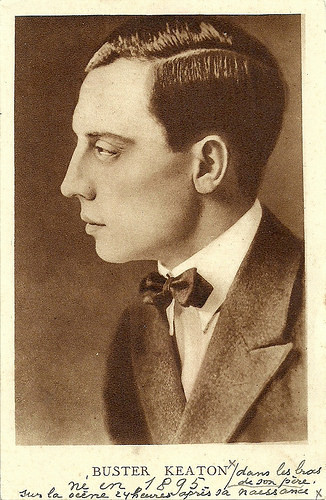
Belgian postcard by Ed. Weekblad Cinema, Antwerpen. French written caption: Buster Keaton, born in 1895, on the stage 24 hours after his birth, in the arms of his father.
The worst decision of his life
Buster Keaton endured this treatment by United Artists for two more feature films, including Steamboat Bill Jr. (Charles Reisner, Buster Keaton, 1928), and then exchanged his independent setup for employment at Hollywood's biggest studio, Metro-Goldwyn-Mayer (MGM). Keaton's loss of independence as a filmmaker coincided with the coming of sound films (although he was interested in making the transition) and mounting personal problems.
In 1921, Keaton had married Natalie Talmadge, sister-in-law of his boss, Joseph Schenck, and sister of actresses Norma Talmadge and Constance Talmadge. She co-starred with Keaton in Our Hospitality. The couple had two sons, James (1922-2007) and Robert (1924–2009), but after the birth of Robert, the relationship began to suffer. Influenced by her family, Talmadge decided not to have any more children and this led to the couple staying in separate bedrooms. Her financial extravagance (she would spend up to a third of his salary on clothes) was another factor in the breakdown of the marriage.
Keaton signed with MGM in 1928, a business decision that he would later call the worst of his life. He realized too late that MGM’s studio system would severely limit his creative input. For instance, the studio refused his request to make his early project, Spite Marriage (Edward Sedgwick, Buster Keaton, 1929), as a sound film and after the studio converted, he was obliged to adhere to dialogue-laden scripts.
However, MGM did allow Keaton some creative participation on his last originally developed/written silent film The Cameraman (Edward Sedgwick, Buster Keaton, 1928). which was his first project under contract with them. Keaton was forced to use a stunt double during some of the more dangerous scenes, something he had never done in his heyday, as MGM wanted badly to protect its investment.
Some of his most financially successful films for the studio were during this period. MGM tried teaming the laconic Keaton with the rambunctious Jimmy Durante in a series of films, The Passionate Plumber (Edward Sedgwick, 1932), Speak Easily (Edward Sedgwick, 1932), and What! No Beer? (Edward Sedgwick, 1933).
In the first Keaton pictures with sound, he and his fellow actors would shoot each scene three times: one in English, one in Spanish, and one in either French or German. The actors would phonetically memorize the foreign-language scripts a few lines at a time and shoot immediately after.
In 1932, Nathalie Talmadge had divorced Keaton, taking his entire fortune and refusing to allow any contact between Keaton and his sons, whose last name she had changed to Talmadge. Keaton was reunited with them about a decade later when his older son turned 18. With the failure of his marriage, and the loss of his independence as a filmmaker, Keaton lapsed into a period of alcoholism.
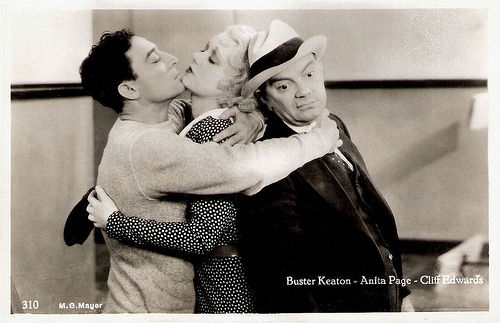
Dutch postcard by JosPe, no. 310. Photo: Metro-Goldwyn-Mayer (MGM). Publicity still for Sidewalks of New York (Zion Myers, Jules White, 1931).
The King of the Champs Elysees
Buster Keaton was so demoralized during the production of What! No Beer? (Edward Sedgwick, 1933) that MGM fired him after the filming was complete, despite the film being a resounding hit. In 1933, he married his nurse, Mae Scriven, during an alcoholic binge about which he afterwards claimed to remember nothing. Scriven herself would later claim that she didn't know Keaton's real first name until after the marriage. When they divorced in 1936, it was again at great financial cost to Keaton.
In 1934, Keaton accepted an offer to make an independent film in Paris, Le Roi des Champs-Élysées/The King of the Champs Elysees (Max Nosseck, 1934) with Paulette Dubost . In England, he made another film, The Invader/An Old Spanish Custom (Adrian Brunel, 1936).
Upon Keaton's return to Hollywood, he made a screen comeback in a series of 16 two-reel comedies for Educational Pictures. Most of these are simple visual comedies, with many of the gags supplied by Keaton himself, often recycling ideas from his family vaudeville act and his earlier films. The high point in the Educational series is Grand Slam Opera (Buster Keaton, Charles Lamont, 1936), featuring Buster in his own screenplay as a contestant in a radio amateur hour show hoping to win the first price... by dancing and juggling.
When the series lapsed in 1937, Keaton returned to MGM as a gag writer, including the Marx Brothers films At the Circus (Edward Buzzell, 1939) and Go West (Edward Buzzell, 1940), and providing material for Red Skelton. He also helped and advised Lucille Ball in her comedic work in films and television. In 1939, Columbia Pictures hired Keaton to star in ten two-reel comedies, running for two years. The director was usually Jules White, whose emphasis on slapstick and farce made most of these films resemble White's Three Stooges comedies. Keaton's personal favourite was the series' debut entry, Pest from the West (Del Lord, 1939), a shorter, tighter remake of The Invader (1936). Keaton's Columbia shorts rank as the worst comedies he made.
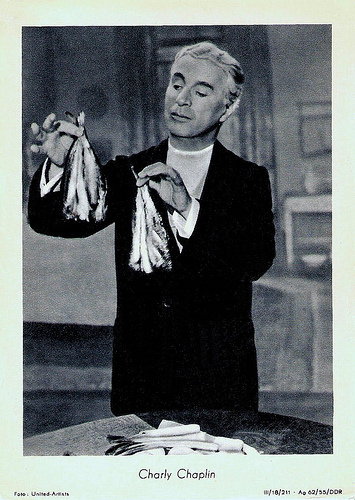
Charlie Chaplin . East-German collectors card, no. III/18/211, 1955. Photo: United Artists. Publicity still for Limelight (1952).
Another chance at the brass ring
Buster Keaton's personal life stabilized with his 1940 marriage with Eleanor Norris, a 21-year-old dancer. She stopped his heavy drinking, and helped to salvage his career. He abandoned Columbia for the less strenuous field of feature films. Throughout the 1940s, Keaton played character roles in features. He made his last starring feature El Moderno Barba Azul/Boom In The Moon (Jaime Salvador, 1946) in Mexico.
Critics rediscovered Keaton in 1949. He had cameos in such films as In the Good Old Summertime (Robert Z. Leonard, 1949), Sunset Boulevard (Billy Wilder, 1950), and Around the World in 80 Days (Michael Anderson, 1956), and did innumerable TV appearances. Keaton also appeared in a comedy routine about two inept stage musicians in Charlie Chaplin 's Limelight (1952).
In 1954, Keaton and his wife met film programmer Raymond Rohauer, with whom the couple would develop a business partnership to re-release Keaton's films. Around the same time, after buying the comedian's house, the actor James Mason found numerous cans of Keaton's films. Keaton had prints of the features Three Ages, Sherlock, Jr., Steamboat Bill, Jr., College (missing one reel) and the shorts The Boat and My Wife's Relations, which Keaton and Rohauer transferred to safety stock from deteriorating nitrate film stock. Unknown to them at the time, MGM also had saved some of Keaton's work: all his 1920-1926 features and his first eight two-reel shorts.
In 1962 came a retrospective at the Cinematheque Francaise in Paris, and in 1965 a tribute at the Venice Film Festival. "I can't feel sorry for myself," he said in Venice. "It all goes to show that if you stay on the merry-go-round long enough you'll get another chance at the brass ring. Luckily, I stayed on."
In 1960, Keaton had returned to MGM for the final time, playing a lion tamer in an adaptation of Mark Twain's The Adventures of Huckleberry Finn (Michael Curtiz, 1960). Later Keaton played a cameo in It's a Mad, Mad, Mad, Mad World (Stanley Kramer, 1963) and starred in four films for American International Pictures: Pajama Party (Don Weis, 1964), Beach Blanket Bingo (William Asher, 1965), How to Stuff a Wild Bikini (William Asher, 1964) and Sergeant Deadhead (Norman Taurog, 1964). As he had done in the past, Keaton also provided gags for the four AIP films.
In 1965, Keaton starred in the short film The Railrodder (Gerald Potterton, Buster Keaton, 1965) for the National Film Board of Canada. Wearing his traditional pork pie hat, he travelled from one end of Canada to the other on a railway motorcar, performing a few stunts similar to those in films he did 50 years earlier. The film was Keaton's last silent screen performance.
He also played the central role in Samuel Beckett's Film (Alan Schneider, 1965) and travelled to Italy to play a role in Due Marines e un Generale/War Italian Style (Luigi Scattini, 1965), with Italian comedy duo Franco Franchi and Ciccio Ingrassia.
Keaton's final film was A Funny Thing Happened on the Way to the Forum (Richard Lester, 1966) which was filmed in Spain in September-November 1965. He amazed the cast and crew by doing many of his own stunts. Shortly after completing the film, Keaton died of lung cancer in 1966 at his home in Woodland Hills, California. He was 70. In 1987, the documentary, Buster Keaton: A Hard Act to Follow, directed by Kevin Brownlow and David Gill, won two Emmy Awards.
One Week (1920). Source: (YouTube).
Trailer for The General (1927). Source: Fandor Movie Trailers (YouTube).
The Railrodder (1965). Source: NFB (YouTube).
Sources: Roger Ebert, (IMDb), New York Times, Wikipedia, and .

German postcard by Ross Verlag, no. 4704/1, 1929-1930. Photo: MGM. Publicity still for The Hollywood Revue of 1929 (Charles Reisner, 1929) with Keaton as Princess Raja. This performance must have been inspired by the Egyptian dance in The Cook (Roscoe 'Fatty' Arbuckle, 1918).

German postcard by Ross Verlag, no. 1834/1, 1927-1928. Photo: Fanamet. Publicity still for Spite Marriage (Edward Sedgewick, Buster Keaton, 1929).
The great stone face
Buster Keaton was born Joseph Frank Keaton in 1895 into a vaudeville family. His father was Joseph Hallie ‘Joe’ Keaton, who owned a travelling show with Harry Houdini called the Mohawk Indian Medicine Company. Keaton was born in Piqua, Kansas, the small town where his mother, Myra Keaton (née Myra Edith Cutler), happened to go into labour.
By the time he was 3, Keaton began performing with his parents in The Three Keatons. He was being thrown around the stage and into the orchestra pit, or even into the audience. His little suits even had a handle concealed at the waist, so Joe could sling him like luggage. "It was the roughest knockabout act that was ever in the history of the theatre," Keaton told the historian Kevin Brownlow. It led to accusations of child abuse, and occasionally, arrest. However, Buster Keaton was always able to show the authorities that he had no bruises or broken bones.
Noticing that his laughing drew fewer laughs from the audience, Keaton adopted his famous deadpan expression whenever he was working. For the rest of his career, Keaton was 'the great stone face', with an expression that ranged from the impassive to the slightly quizzical.
By the time he was 21, his father's alcoholism threatened the reputation of the family act, so Keaton and his mother, Myra, left for New York, where Buster Keaton's career swiftly moved from vaudeville to film. In February 1917, Keaton met Roscoe ‘Fatty’ Arbuckle at the Talmadge Studios in New York City, where Arbuckle was under contract to Joseph M. Schenck. He was hired as a co-star and gag man, making his first appearance in the short The Butcher Boy (Roscoe 'Fatty' Arbuckle, 1917).
Keaton appeared in a total of 14 Arbuckle shorts, running into 1920. They were popular and, Keaton and Arbuckle became close friends. Keaton was one of few people to defend Arbuckle's character during accusations that he was responsible for the death of actress Virginia Rappe in 1921.
In The Saphead (Herbert Blaché, Winchell Smith, 1920), Keaton had his first starring role in a full-length feature. It was a success and Schenck gave him his own production unit, Buster Keaton Comedies. He made a series of two-reel comedies, including One Week (Edward F. Cline, Buster Keaton, 1920), The Boat (Edward F. Cline, Buster Keaton, 1921), Cops (Edward F. Cline, Buster Keaton, 1922), and The Paleface (Edward F. Cline, Buster Keaton, 1922).
Keaton then moved to full-length features. His first feature, Three Ages (Edward F. Cline, Buster Keaton, 1923), was produced similarly to his short films, and was the dawning of a new era in comedic cinema, where it became apparent to Keaton that he had to put more focus on the story lines and characterization. His most enduring features include Our Hospitality (John G. Blystone, Buster Keaton, 1923), The Navigator (Donald Crisp, Buster Keaton, 1924), Sherlock Jr. (Buster Keaton, 1924), College (James W. Horne, Buster Keaton, 1927), and The General (Clyde Bruckman, Buster Keaton, 1927).
My favourite is The General, set during the American Civil War. The film combines physical comedy with Keaton's love of trains, including an epic locomotive chase. Employing picturesque locations, the film's storyline re-enacted an actual wartime incident. Though it would come to be regarded as Keaton's greatest achievement, the film received mixed reviews at the time. It was too dramatic for some filmgoers expecting a lightweight comedy. It was an expensive misfire, and Keaton was never entrusted with total control over his films again. His distributor, United Artists, insisted on a production manager who monitored expenses and interfered with certain story elements.

Belgian postcard by Ed. Weekblad Cinema, Antwerpen. French written caption: Buster Keaton, born in 1895, on the stage 24 hours after his birth, in the arms of his father.
The worst decision of his life
Buster Keaton endured this treatment by United Artists for two more feature films, including Steamboat Bill Jr. (Charles Reisner, Buster Keaton, 1928), and then exchanged his independent setup for employment at Hollywood's biggest studio, Metro-Goldwyn-Mayer (MGM). Keaton's loss of independence as a filmmaker coincided with the coming of sound films (although he was interested in making the transition) and mounting personal problems.
In 1921, Keaton had married Natalie Talmadge, sister-in-law of his boss, Joseph Schenck, and sister of actresses Norma Talmadge and Constance Talmadge. She co-starred with Keaton in Our Hospitality. The couple had two sons, James (1922-2007) and Robert (1924–2009), but after the birth of Robert, the relationship began to suffer. Influenced by her family, Talmadge decided not to have any more children and this led to the couple staying in separate bedrooms. Her financial extravagance (she would spend up to a third of his salary on clothes) was another factor in the breakdown of the marriage.
Keaton signed with MGM in 1928, a business decision that he would later call the worst of his life. He realized too late that MGM’s studio system would severely limit his creative input. For instance, the studio refused his request to make his early project, Spite Marriage (Edward Sedgwick, Buster Keaton, 1929), as a sound film and after the studio converted, he was obliged to adhere to dialogue-laden scripts.
However, MGM did allow Keaton some creative participation on his last originally developed/written silent film The Cameraman (Edward Sedgwick, Buster Keaton, 1928). which was his first project under contract with them. Keaton was forced to use a stunt double during some of the more dangerous scenes, something he had never done in his heyday, as MGM wanted badly to protect its investment.
Some of his most financially successful films for the studio were during this period. MGM tried teaming the laconic Keaton with the rambunctious Jimmy Durante in a series of films, The Passionate Plumber (Edward Sedgwick, 1932), Speak Easily (Edward Sedgwick, 1932), and What! No Beer? (Edward Sedgwick, 1933).
In the first Keaton pictures with sound, he and his fellow actors would shoot each scene three times: one in English, one in Spanish, and one in either French or German. The actors would phonetically memorize the foreign-language scripts a few lines at a time and shoot immediately after.
In 1932, Nathalie Talmadge had divorced Keaton, taking his entire fortune and refusing to allow any contact between Keaton and his sons, whose last name she had changed to Talmadge. Keaton was reunited with them about a decade later when his older son turned 18. With the failure of his marriage, and the loss of his independence as a filmmaker, Keaton lapsed into a period of alcoholism.

Dutch postcard by JosPe, no. 310. Photo: Metro-Goldwyn-Mayer (MGM). Publicity still for Sidewalks of New York (Zion Myers, Jules White, 1931).
The King of the Champs Elysees
Buster Keaton was so demoralized during the production of What! No Beer? (Edward Sedgwick, 1933) that MGM fired him after the filming was complete, despite the film being a resounding hit. In 1933, he married his nurse, Mae Scriven, during an alcoholic binge about which he afterwards claimed to remember nothing. Scriven herself would later claim that she didn't know Keaton's real first name until after the marriage. When they divorced in 1936, it was again at great financial cost to Keaton.
In 1934, Keaton accepted an offer to make an independent film in Paris, Le Roi des Champs-Élysées/The King of the Champs Elysees (Max Nosseck, 1934) with Paulette Dubost . In England, he made another film, The Invader/An Old Spanish Custom (Adrian Brunel, 1936).
Upon Keaton's return to Hollywood, he made a screen comeback in a series of 16 two-reel comedies for Educational Pictures. Most of these are simple visual comedies, with many of the gags supplied by Keaton himself, often recycling ideas from his family vaudeville act and his earlier films. The high point in the Educational series is Grand Slam Opera (Buster Keaton, Charles Lamont, 1936), featuring Buster in his own screenplay as a contestant in a radio amateur hour show hoping to win the first price... by dancing and juggling.
When the series lapsed in 1937, Keaton returned to MGM as a gag writer, including the Marx Brothers films At the Circus (Edward Buzzell, 1939) and Go West (Edward Buzzell, 1940), and providing material for Red Skelton. He also helped and advised Lucille Ball in her comedic work in films and television. In 1939, Columbia Pictures hired Keaton to star in ten two-reel comedies, running for two years. The director was usually Jules White, whose emphasis on slapstick and farce made most of these films resemble White's Three Stooges comedies. Keaton's personal favourite was the series' debut entry, Pest from the West (Del Lord, 1939), a shorter, tighter remake of The Invader (1936). Keaton's Columbia shorts rank as the worst comedies he made.

Charlie Chaplin . East-German collectors card, no. III/18/211, 1955. Photo: United Artists. Publicity still for Limelight (1952).
Another chance at the brass ring
Buster Keaton's personal life stabilized with his 1940 marriage with Eleanor Norris, a 21-year-old dancer. She stopped his heavy drinking, and helped to salvage his career. He abandoned Columbia for the less strenuous field of feature films. Throughout the 1940s, Keaton played character roles in features. He made his last starring feature El Moderno Barba Azul/Boom In The Moon (Jaime Salvador, 1946) in Mexico.
Critics rediscovered Keaton in 1949. He had cameos in such films as In the Good Old Summertime (Robert Z. Leonard, 1949), Sunset Boulevard (Billy Wilder, 1950), and Around the World in 80 Days (Michael Anderson, 1956), and did innumerable TV appearances. Keaton also appeared in a comedy routine about two inept stage musicians in Charlie Chaplin 's Limelight (1952).
In 1954, Keaton and his wife met film programmer Raymond Rohauer, with whom the couple would develop a business partnership to re-release Keaton's films. Around the same time, after buying the comedian's house, the actor James Mason found numerous cans of Keaton's films. Keaton had prints of the features Three Ages, Sherlock, Jr., Steamboat Bill, Jr., College (missing one reel) and the shorts The Boat and My Wife's Relations, which Keaton and Rohauer transferred to safety stock from deteriorating nitrate film stock. Unknown to them at the time, MGM also had saved some of Keaton's work: all his 1920-1926 features and his first eight two-reel shorts.
In 1962 came a retrospective at the Cinematheque Francaise in Paris, and in 1965 a tribute at the Venice Film Festival. "I can't feel sorry for myself," he said in Venice. "It all goes to show that if you stay on the merry-go-round long enough you'll get another chance at the brass ring. Luckily, I stayed on."
In 1960, Keaton had returned to MGM for the final time, playing a lion tamer in an adaptation of Mark Twain's The Adventures of Huckleberry Finn (Michael Curtiz, 1960). Later Keaton played a cameo in It's a Mad, Mad, Mad, Mad World (Stanley Kramer, 1963) and starred in four films for American International Pictures: Pajama Party (Don Weis, 1964), Beach Blanket Bingo (William Asher, 1965), How to Stuff a Wild Bikini (William Asher, 1964) and Sergeant Deadhead (Norman Taurog, 1964). As he had done in the past, Keaton also provided gags for the four AIP films.
In 1965, Keaton starred in the short film The Railrodder (Gerald Potterton, Buster Keaton, 1965) for the National Film Board of Canada. Wearing his traditional pork pie hat, he travelled from one end of Canada to the other on a railway motorcar, performing a few stunts similar to those in films he did 50 years earlier. The film was Keaton's last silent screen performance.
He also played the central role in Samuel Beckett's Film (Alan Schneider, 1965) and travelled to Italy to play a role in Due Marines e un Generale/War Italian Style (Luigi Scattini, 1965), with Italian comedy duo Franco Franchi and Ciccio Ingrassia.
Keaton's final film was A Funny Thing Happened on the Way to the Forum (Richard Lester, 1966) which was filmed in Spain in September-November 1965. He amazed the cast and crew by doing many of his own stunts. Shortly after completing the film, Keaton died of lung cancer in 1966 at his home in Woodland Hills, California. He was 70. In 1987, the documentary, Buster Keaton: A Hard Act to Follow, directed by Kevin Brownlow and David Gill, won two Emmy Awards.
One Week (1920). Source: (YouTube).
Trailer for The General (1927). Source: Fandor Movie Trailers (YouTube).
The Railrodder (1965). Source: NFB (YouTube).
Sources: Roger Ebert, (IMDb), New York Times, Wikipedia, and .
Published on July 02, 2015 05:24
June 30, 2015
Charles Laughton
One of the Hollywood sections at Il Cinema Ritrovato this year is Seriously funny, a retrospective of the films by director Leo McCarey. He made Duck Soup (1933) with the Marx Brothers and Ruggles of Red Gap (1935) with Charles Laughton (1899–1962), which is shown twice this week. The portly, versatile British-American stage and film actor was one of the most popular actors of the 1930s and 1940s. He gave great performances as Nero, Henry VIII, Inspector Javert, Captain Bligh, Rembrandt, Quasimodo, and of course as Ruggles, the British butler who is brought to the Wild, Wild West.
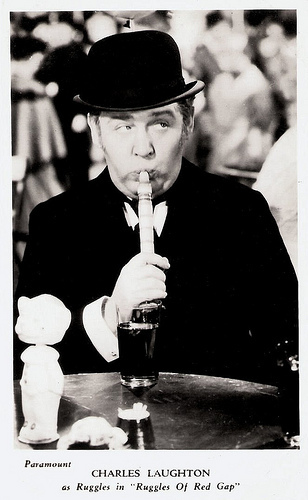
Vintage postcard. Photo: Paramount. Publicity still for Ruggles of Red Gap (1935).
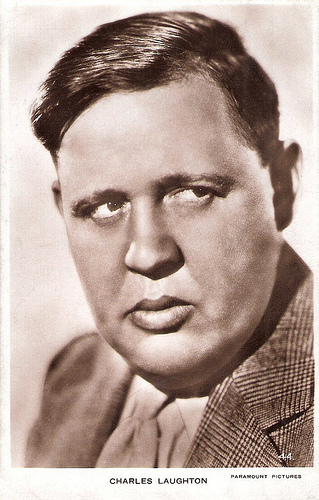
British postcard by Milton, no. 44. Photo: Paramount Pictures.
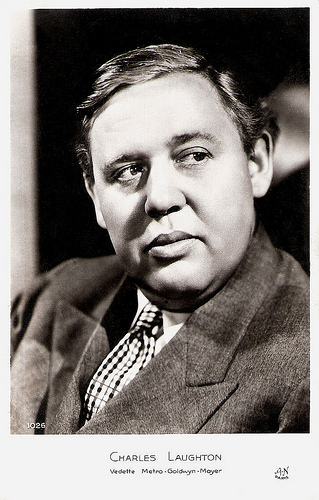
French postcard by A.N., Paris, no. 1026. Photo: Metro-Goldwyn-Mayer (MGM).
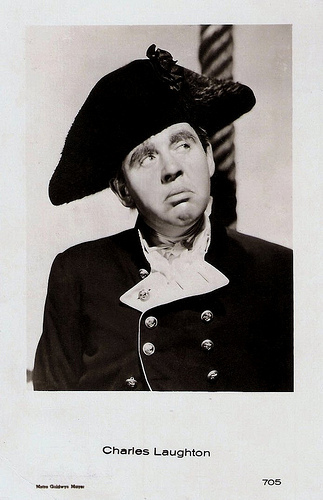
Dutch postcard, no. 705. Photo: Metro-Goldwyn-Mayer. Publicity still for Mutiny on the Bounty (1935).
Overweight and Not The Best Looking of Men
Charles Laughton was born to a wealthy hotel owning family in Scarborough, England, in 1899. He was the son of Robert Laughton and his wife Elizabeth Conlon, who was a devout Roman Catholic. They ran the Victoria Hotel, a well-known retreat for the middle class. Laughton and his two younger brothers thrived in the spacious hotel, always finding new places to play.
Laughton attended Stonyhurst College, a Jesuit school, in Lancashire, England. He was assigned the roll of a portly innkeeper in the school’s production of The Private Secretary. Even though the role was a minor one, he loved the opportunity to let out his artistic flair. In 1917, just 18 he was sent onto the battlefields of Europe. He joined the war at its conclusion, but none the less suffered not only a gas attack but also some deep mental scars.
He started work in the family hotel business, while participating in amateur theatricals in Scarborough. Finally he was allowed by his family to become a drama student at the Royal Academy of Dramatic Art (RADA) in 1925, where he received the gold medal. Laughton made his stage début in 1926 at the Barnes Theatre, as Osip in Gogol's comedy The Government Inspector, in which he also appeared at the London Gaiety Theatre. In the following years he appeared in many West End productions.
Overweight and not the best looking of men, many of the leading roles were not available to him. Despite this he impressed audiences with his talent and played classical roles in two plays by Anton Chekhov, The Cherry Orchard and The Three Sisters. One of his earliest stage successes was as Hercule Poirot in Alibi (1928), a stage adaptation of The Murder of Roger Ackroyd. In fact he was the first actor to portray Agatha Christie's Belgian detective.
That same year Laughton also played the lead role of Harry Hegan in the world première of Sean O'Casey's The Silver Tassie in London, and he played the title role in Arnold Bennett's Mr Prohack. Elsa Lanchester was also in the cast. Coming from a bohemian background, Lanchester was lively and strong willed. She fell for the reserved and sensitive Laughton and despite his suppressed feelings of homosexuality the two began a courtship. In 1929 they married.
Laughton went on to play the title role in Mr Pickwick after Charles Dickens, and Tony Perelli in Edgar Wallace's On the Spot. Another success was his role as William Marble in Payment Deferred. He took this last play across the Atlantic and in it he made his American début in 1931, at the Lyceum Theatre in New York. He returned to London for the 1933 - 1934 Old Vic Season and was engaged in four Shakespeare roles.
In 1936, he went to Paris and appeared at the Comédie-Française as Sganarelle in the second act of Molière's Le Médecin malgré lui He was the first English actor to appear at that theatre, acted the part in French and received an ovation.
Laughton commenced his film career in England while still acting on the London stage. He took small roles in three short silent comedies starring his wife Elsa Lanchester, Daydreams (Ivor Montagu, 1928), Blue Bottles (Ivor Montagu, 1928) and The Tonic (Ivor Montagu, 1928) which had been specially written for her by H. G. Wells. He made a brief appearance as a disgruntled diner in another silent film Piccadilly (Ewald André Dupont, 1929) with Anna May Wong .
Laughton appeared with Elsa Lanchester again in Comets (Sasha Geneen, 1930), featuring assorted British variety acts. In this ‘film revue’ they duetted in The Ballad of Frankie and Johnnie. The couple made two other early British talkies: Wolves (Albert de Courville, 1930) with Dorothy Gish from a play set in a whaling camp in the frozen north, and Down River (Peter Godfrey, 1931) in which he played a murderous, half-oriental drug-smuggler.
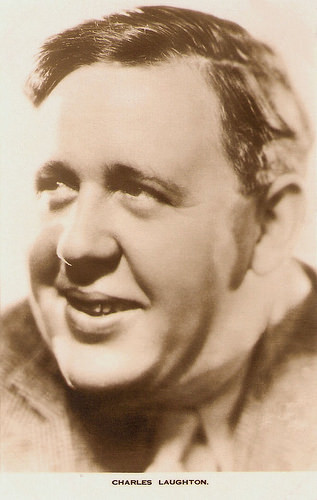
British postcard.
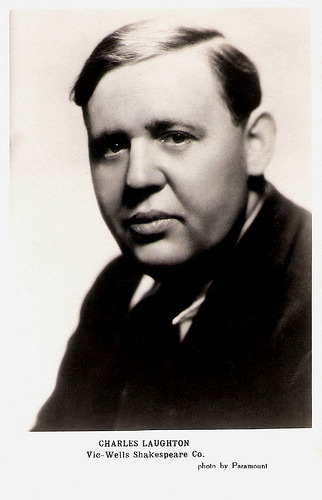
British postcard. Photo: Paramount. Caption: Vic-Wells Shakespeare Co.
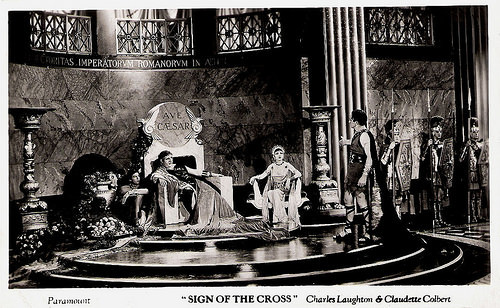
British postcard in the series Film Shots by Film Weekly. Photo: Paramount. publicity still of The Sign of the Cross (Cecil B. De Mille, 1932) with Claudette Colbert.
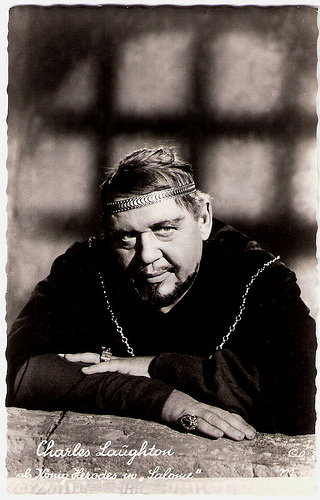
Austrian postcard by Verlag Hubmann (HDH Verlag), Wien (Vienna), no. 3390. Photo: publicity still for Salome (William Dieterle, 1953) with Charles Laughton as King Herod.
On Course For Instant International Stardom
Charles Laughton’s New York stage début in 1931 immediately led to film offers and Laughton's first Hollywood film was the classic horror comedy The Old Dark House (James Whale, 1932) with Boris Karloff. Laughton played a bluff Yorkshire businessman marooned during a storm with other travellers in a creepy mansion in the Welsh mountains. In the Encyclopedia of British Film , Anthony Slide calls it Laughton’s ‘greatest work in the US’.
He then played a demented submarine commander in The Devil and the Deep (Marion Gering, 1932) with Tallulah Bankhead, Gary Cooper and Cary Grant and followed this with his famous role as the perverted Nero in The Sign of the Cross (Cecil B. DeMille, 1932). He then repeated his stage role as a murderer in Payment Deferred (Lothar Mendes, 1932), played H. G. Wells's mad vivisectionist Dr. Moreau in Island of Lost Souls (Erle C. Kenton, 1932), and the meek raspberry-blowing clerk in the brief segment of If I Had a Million (1932) that was directed by Ernst Lubitsch.
In all, he appeared in six Hollywood films during 1932, a remarkable movie 'apprenticeship' which set him on course for instant international stardom. His association with film director Alexander Korda began with The Private Life of Henry VIII (1933), loosely based on the life of King Henry VIII of England. Laughton won an Academy Award for his role, the first British actor to do so.
He continued to act occasionally in the theatre. After the success of The Private Life of Henry VIII he appeared at the Old Vic Theatre in 1933 in roles as Macbeth, Lopakin in The Cherry Orchard, Prospero in The Tempest and Angelo in Measure for Measure. His 1947 American production of a new English version of Bertolt Brecht's play Galileo became legendary. Laughton played the title role at the play's premiere in Los Angeles on 30 July 1947 and later that year in New York. This staging was directed by Joseph Losey.
Laughton preferred a film career though and in 1933 he returned to Hollywood where his next film was White Woman (Stuart Walker, 1933) in which he co-starred with Carole Lombard as a cockney river trader in the Malaysian jungle. Then came The Barretts of Wimpole Street (Sidney Franklin, 1934) as Norma Shearer's overbearing father, Les Misérables (Richard Boleslawski, 1935) as inspector Javert, and Ruggles of Red Gap (Leo McCarey, 1935) as the very English and selfless butler transported to early 1900s America. One of his most famous screen roles was Captain William Bligh in Mutiny on the Bounty (Frank Lloyd, 1935), co-starring with Clark Gable as Fletcher Christian.
Back in England, and again with Alexander Korda, he played the title role in Rembrandt (1936). In 1937, also for Korda, he starred in an ill-fated film version of Robert Graves’ classic novel, I, Claudius (Josef von Sternberg, 1937), which was abandoned during filming owing to the injuries suffered by co-star Merle Oberon in a car crash.
After I, Claudius, he and the ex-pat German film producer Erich Pommer founded the production company Mayflower Pictures in the UK, which produced three films starring Laughton: Vessel of Wrath/The Beachcomber (Erich Pommer, 1938), based on a story by W. Somerset Maugham, with Elsa Lanchester; St. Martin's Lane/Sidewalks of London (Tim Whelan, 1938), a story about London street entertainers that also featured Vivien Leigh and Rex Harrison ; and Jamaica Inn (Alfred Hitchcock, 1939), with Maureen O'Hara. The latter was based on a novel about Cornish smugglers by Daphne du Maurier, and it was the last film Alfred Hitchcock directed in Britain before moving to Hollywood in the late 1930s.
The films produced were not successful enough, and the company was saved from bankruptcy when RKO Pictures offered Laughton the title role of Quasimodo in The Hunchback of Notre Dame (1939) directed by William Dieterle . Laughton and Pommer had plans to make further films, but the outbreak of World War II, which implied the loss of many foreign markets, meant the end of the company.
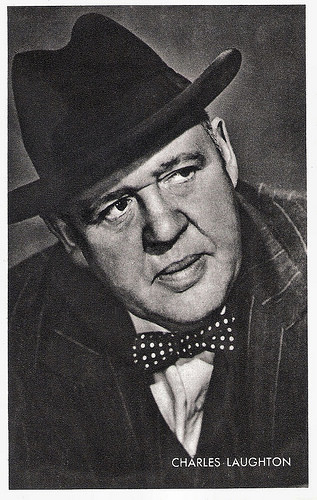
Belgian collectors card by Kwatta, Bois d'Haine, no. C. 152. Photo: Metro Goldwyn Mayer. Publicity still for Arch of Triumph (Lewis Milestone, 1948).
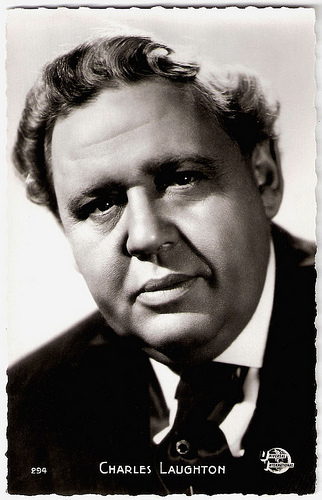
French postcard by Editions P.I., Paris, no. 294. Photo: Universal International.
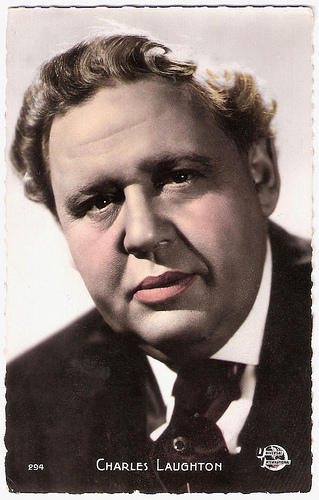
French postcard by Editions P.I., Paris, no. 294. Photo: Universal International.
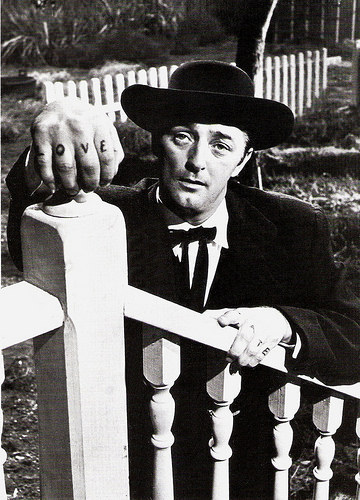
Italian programme card for Il Cinema Ritrovata 2003. Photo: publicity still for The Night of the Hunter (Charles Laughton, 1955) with Robert Mitchum.
The Night of the Hunter
Although the 1930s were Charles Laughton’s best cinematic years, there were as well some remarkable post-1930s performances. An example is the cowardly schoolmaster in occupied France in This Land is Mine (Jean Renoir, 1943). He played a modest, henpecked husband who eventually murders his wife in The Suspect (1944), directed by Robert Siodmak, who later became a good friend of Laughton. He played sympathetically an impoverished composer-pianist in Tales of Manhattan (Julien Duvivier, 1942) and starred in an updated version of Oscar Wilde's The Canterville Ghost (Jules Dassin, 1944).
Apart from these, he would enjoy his work in the two comedies he made with Deanna Durbin, It Started with Eve (Henry Koster, 1941) and Because of Him (Richard Wallace, 1946). He portrayed a bloodthirsty pirate in Captain Kidd (Rowland V. Lee, 1945) and a malevolent judge in Alfred Hitchcock's The Paradine Case (1948) with Alida Valli . Laughton played a megalomaniac press tycoon in The Big Clock (John Farrow, 1948) starring Ray Milland . Laughton made his first colour film in Paris as Inspector Maigret in The Man on the Eiffel Tower (Burgess Meredith, 1949).
In 1950, Laughton and Lanchester became American citizens. In one of his funniest roles of the 1950s, he played a tramp in O. Henry's Full House (Henry Koster a.o., 1952), in which he had a one-minute scene with Marilyn Monroe. In later years he was frequently accused by the critics to ham, although he remained a popular star. He became a pirate again, buffoon style this time, in Abbott and Costello Meet Captain Kidd (Charles Lamont, 1952). He guest-starred in an episode of the Colgate Comedy Hour on TV that also featured Abbot and Costello and that was notable for his delivery of the Gettysburg Address.
He played Herod Antipas in Salome (William Dieterle, 1953) with Rita Hayworth in the title role, and repeated his role as Henry VIII in Young Bess (George Sidney, 1953) starring Jean Simmons . He returned to England for a memorable turn in Hobson's Choice (David Lean, 1954) as the patriarch brought to heel opposite John Mills .
Laughton directed several plays on Broadway. His most notable box-office success as a director came in 1954, with The Caine Mutiny Court-Martial, a full-length stage dramatization by Herman Wouk of the court-martial scene in Wouk's novel The Caine Mutiny. In 1955, Laughton directed (but did not act in) the film The Night of the Hunter. This poetic thriller has become a critical and cult favourite thanks to Laughton's intriguing combination of expressionism and realism, a fine script co-written by James Agee and compelling performances by an excellent cast headed by Robert Mitchum as a psychotic preacher and Lillian Gish as a resolute farm woman. At the time of its original release, however, it was a critical and box-office failure, and Laughton never had another chance to direct a film.
Laughton received Academy Award and Golden Globe nominations for his role as Sir Wilfrid Robarts in the screen version of Agatha Christie's play Witness for the Prosecution (Billy Wilder, 1957) with Marlene Dietrich . He played a British admiral in the Italian war film Sotto dieci bandiere/Under Ten Flags (Duilio Coletti, 1960) and worked for the only time with Laurence Olivier in Spartacus (Stanley Kubrick, 1960) as a wily Roman senator.
He also gave highly successful one-man reading tours for many years. His material ranged from the Bible to Jack Kerouac's The Dharma Bums. His final film was Advise and Consent (Otto Preminger, 1962), for which he received favourable comments for his performance as a southern US Senator (for which accent he studied recordings of Mississippi Senator John Stennis).
Laughton worked on the film, while he was dying. In January 1962 he had been diagnosed with cancer after being hospitalized with a collapsed vertebrae following a fall in the bath. Over the course of his final eleven months, his weight dropped to just ninety pounds. Following Laughton's death in 1962, Laughton's wife Elsa Lanchester wrote a memoir in which she stated that they never had children because Laughton was actually homosexual. The lesbian and gay Fyne Times writes about the couple: “Only two years into the marriage, Lanchester learnt of her husband’s homosexuality. Although she was initially shocked and deeply upset, over time the couple began to develop an altered relationship, one of close friendship. They decided to remain married, although both of them took lovers, and were instead constant companions, looking after and supporting each other as in any other marriage.”
Chicken eating scene from The Private Life of Henry VIII (1933). Source: adam28xx's channel (YouTube).
Theatrical Trailer for Mutiny On The Bounty (1935). Source: MOVIE Channel (YouTube).
Laughton's recitation of the Gettysburg Address in Ruggles of Red Gap (1935). Source: MediaMayhem (YouTube).
Trailer for The Night of the Hunter (1955). Source: enneme (YouTube).
Sources: Anthony Slide (Encyclopedia of British Film), Gloria (Rooting for Laughton), Fyne Times, TCM, Wikipedia and .

Vintage postcard. Photo: Paramount. Publicity still for Ruggles of Red Gap (1935).

British postcard by Milton, no. 44. Photo: Paramount Pictures.

French postcard by A.N., Paris, no. 1026. Photo: Metro-Goldwyn-Mayer (MGM).

Dutch postcard, no. 705. Photo: Metro-Goldwyn-Mayer. Publicity still for Mutiny on the Bounty (1935).
Overweight and Not The Best Looking of Men
Charles Laughton was born to a wealthy hotel owning family in Scarborough, England, in 1899. He was the son of Robert Laughton and his wife Elizabeth Conlon, who was a devout Roman Catholic. They ran the Victoria Hotel, a well-known retreat for the middle class. Laughton and his two younger brothers thrived in the spacious hotel, always finding new places to play.
Laughton attended Stonyhurst College, a Jesuit school, in Lancashire, England. He was assigned the roll of a portly innkeeper in the school’s production of The Private Secretary. Even though the role was a minor one, he loved the opportunity to let out his artistic flair. In 1917, just 18 he was sent onto the battlefields of Europe. He joined the war at its conclusion, but none the less suffered not only a gas attack but also some deep mental scars.
He started work in the family hotel business, while participating in amateur theatricals in Scarborough. Finally he was allowed by his family to become a drama student at the Royal Academy of Dramatic Art (RADA) in 1925, where he received the gold medal. Laughton made his stage début in 1926 at the Barnes Theatre, as Osip in Gogol's comedy The Government Inspector, in which he also appeared at the London Gaiety Theatre. In the following years he appeared in many West End productions.
Overweight and not the best looking of men, many of the leading roles were not available to him. Despite this he impressed audiences with his talent and played classical roles in two plays by Anton Chekhov, The Cherry Orchard and The Three Sisters. One of his earliest stage successes was as Hercule Poirot in Alibi (1928), a stage adaptation of The Murder of Roger Ackroyd. In fact he was the first actor to portray Agatha Christie's Belgian detective.
That same year Laughton also played the lead role of Harry Hegan in the world première of Sean O'Casey's The Silver Tassie in London, and he played the title role in Arnold Bennett's Mr Prohack. Elsa Lanchester was also in the cast. Coming from a bohemian background, Lanchester was lively and strong willed. She fell for the reserved and sensitive Laughton and despite his suppressed feelings of homosexuality the two began a courtship. In 1929 they married.
Laughton went on to play the title role in Mr Pickwick after Charles Dickens, and Tony Perelli in Edgar Wallace's On the Spot. Another success was his role as William Marble in Payment Deferred. He took this last play across the Atlantic and in it he made his American début in 1931, at the Lyceum Theatre in New York. He returned to London for the 1933 - 1934 Old Vic Season and was engaged in four Shakespeare roles.
In 1936, he went to Paris and appeared at the Comédie-Française as Sganarelle in the second act of Molière's Le Médecin malgré lui He was the first English actor to appear at that theatre, acted the part in French and received an ovation.
Laughton commenced his film career in England while still acting on the London stage. He took small roles in three short silent comedies starring his wife Elsa Lanchester, Daydreams (Ivor Montagu, 1928), Blue Bottles (Ivor Montagu, 1928) and The Tonic (Ivor Montagu, 1928) which had been specially written for her by H. G. Wells. He made a brief appearance as a disgruntled diner in another silent film Piccadilly (Ewald André Dupont, 1929) with Anna May Wong .
Laughton appeared with Elsa Lanchester again in Comets (Sasha Geneen, 1930), featuring assorted British variety acts. In this ‘film revue’ they duetted in The Ballad of Frankie and Johnnie. The couple made two other early British talkies: Wolves (Albert de Courville, 1930) with Dorothy Gish from a play set in a whaling camp in the frozen north, and Down River (Peter Godfrey, 1931) in which he played a murderous, half-oriental drug-smuggler.

British postcard.

British postcard. Photo: Paramount. Caption: Vic-Wells Shakespeare Co.

British postcard in the series Film Shots by Film Weekly. Photo: Paramount. publicity still of The Sign of the Cross (Cecil B. De Mille, 1932) with Claudette Colbert.

Austrian postcard by Verlag Hubmann (HDH Verlag), Wien (Vienna), no. 3390. Photo: publicity still for Salome (William Dieterle, 1953) with Charles Laughton as King Herod.
On Course For Instant International Stardom
Charles Laughton’s New York stage début in 1931 immediately led to film offers and Laughton's first Hollywood film was the classic horror comedy The Old Dark House (James Whale, 1932) with Boris Karloff. Laughton played a bluff Yorkshire businessman marooned during a storm with other travellers in a creepy mansion in the Welsh mountains. In the Encyclopedia of British Film , Anthony Slide calls it Laughton’s ‘greatest work in the US’.
He then played a demented submarine commander in The Devil and the Deep (Marion Gering, 1932) with Tallulah Bankhead, Gary Cooper and Cary Grant and followed this with his famous role as the perverted Nero in The Sign of the Cross (Cecil B. DeMille, 1932). He then repeated his stage role as a murderer in Payment Deferred (Lothar Mendes, 1932), played H. G. Wells's mad vivisectionist Dr. Moreau in Island of Lost Souls (Erle C. Kenton, 1932), and the meek raspberry-blowing clerk in the brief segment of If I Had a Million (1932) that was directed by Ernst Lubitsch.
In all, he appeared in six Hollywood films during 1932, a remarkable movie 'apprenticeship' which set him on course for instant international stardom. His association with film director Alexander Korda began with The Private Life of Henry VIII (1933), loosely based on the life of King Henry VIII of England. Laughton won an Academy Award for his role, the first British actor to do so.
He continued to act occasionally in the theatre. After the success of The Private Life of Henry VIII he appeared at the Old Vic Theatre in 1933 in roles as Macbeth, Lopakin in The Cherry Orchard, Prospero in The Tempest and Angelo in Measure for Measure. His 1947 American production of a new English version of Bertolt Brecht's play Galileo became legendary. Laughton played the title role at the play's premiere in Los Angeles on 30 July 1947 and later that year in New York. This staging was directed by Joseph Losey.
Laughton preferred a film career though and in 1933 he returned to Hollywood where his next film was White Woman (Stuart Walker, 1933) in which he co-starred with Carole Lombard as a cockney river trader in the Malaysian jungle. Then came The Barretts of Wimpole Street (Sidney Franklin, 1934) as Norma Shearer's overbearing father, Les Misérables (Richard Boleslawski, 1935) as inspector Javert, and Ruggles of Red Gap (Leo McCarey, 1935) as the very English and selfless butler transported to early 1900s America. One of his most famous screen roles was Captain William Bligh in Mutiny on the Bounty (Frank Lloyd, 1935), co-starring with Clark Gable as Fletcher Christian.
Back in England, and again with Alexander Korda, he played the title role in Rembrandt (1936). In 1937, also for Korda, he starred in an ill-fated film version of Robert Graves’ classic novel, I, Claudius (Josef von Sternberg, 1937), which was abandoned during filming owing to the injuries suffered by co-star Merle Oberon in a car crash.
After I, Claudius, he and the ex-pat German film producer Erich Pommer founded the production company Mayflower Pictures in the UK, which produced three films starring Laughton: Vessel of Wrath/The Beachcomber (Erich Pommer, 1938), based on a story by W. Somerset Maugham, with Elsa Lanchester; St. Martin's Lane/Sidewalks of London (Tim Whelan, 1938), a story about London street entertainers that also featured Vivien Leigh and Rex Harrison ; and Jamaica Inn (Alfred Hitchcock, 1939), with Maureen O'Hara. The latter was based on a novel about Cornish smugglers by Daphne du Maurier, and it was the last film Alfred Hitchcock directed in Britain before moving to Hollywood in the late 1930s.
The films produced were not successful enough, and the company was saved from bankruptcy when RKO Pictures offered Laughton the title role of Quasimodo in The Hunchback of Notre Dame (1939) directed by William Dieterle . Laughton and Pommer had plans to make further films, but the outbreak of World War II, which implied the loss of many foreign markets, meant the end of the company.

Belgian collectors card by Kwatta, Bois d'Haine, no. C. 152. Photo: Metro Goldwyn Mayer. Publicity still for Arch of Triumph (Lewis Milestone, 1948).

French postcard by Editions P.I., Paris, no. 294. Photo: Universal International.

French postcard by Editions P.I., Paris, no. 294. Photo: Universal International.

Italian programme card for Il Cinema Ritrovata 2003. Photo: publicity still for The Night of the Hunter (Charles Laughton, 1955) with Robert Mitchum.
The Night of the Hunter
Although the 1930s were Charles Laughton’s best cinematic years, there were as well some remarkable post-1930s performances. An example is the cowardly schoolmaster in occupied France in This Land is Mine (Jean Renoir, 1943). He played a modest, henpecked husband who eventually murders his wife in The Suspect (1944), directed by Robert Siodmak, who later became a good friend of Laughton. He played sympathetically an impoverished composer-pianist in Tales of Manhattan (Julien Duvivier, 1942) and starred in an updated version of Oscar Wilde's The Canterville Ghost (Jules Dassin, 1944).
Apart from these, he would enjoy his work in the two comedies he made with Deanna Durbin, It Started with Eve (Henry Koster, 1941) and Because of Him (Richard Wallace, 1946). He portrayed a bloodthirsty pirate in Captain Kidd (Rowland V. Lee, 1945) and a malevolent judge in Alfred Hitchcock's The Paradine Case (1948) with Alida Valli . Laughton played a megalomaniac press tycoon in The Big Clock (John Farrow, 1948) starring Ray Milland . Laughton made his first colour film in Paris as Inspector Maigret in The Man on the Eiffel Tower (Burgess Meredith, 1949).
In 1950, Laughton and Lanchester became American citizens. In one of his funniest roles of the 1950s, he played a tramp in O. Henry's Full House (Henry Koster a.o., 1952), in which he had a one-minute scene with Marilyn Monroe. In later years he was frequently accused by the critics to ham, although he remained a popular star. He became a pirate again, buffoon style this time, in Abbott and Costello Meet Captain Kidd (Charles Lamont, 1952). He guest-starred in an episode of the Colgate Comedy Hour on TV that also featured Abbot and Costello and that was notable for his delivery of the Gettysburg Address.
He played Herod Antipas in Salome (William Dieterle, 1953) with Rita Hayworth in the title role, and repeated his role as Henry VIII in Young Bess (George Sidney, 1953) starring Jean Simmons . He returned to England for a memorable turn in Hobson's Choice (David Lean, 1954) as the patriarch brought to heel opposite John Mills .
Laughton directed several plays on Broadway. His most notable box-office success as a director came in 1954, with The Caine Mutiny Court-Martial, a full-length stage dramatization by Herman Wouk of the court-martial scene in Wouk's novel The Caine Mutiny. In 1955, Laughton directed (but did not act in) the film The Night of the Hunter. This poetic thriller has become a critical and cult favourite thanks to Laughton's intriguing combination of expressionism and realism, a fine script co-written by James Agee and compelling performances by an excellent cast headed by Robert Mitchum as a psychotic preacher and Lillian Gish as a resolute farm woman. At the time of its original release, however, it was a critical and box-office failure, and Laughton never had another chance to direct a film.
Laughton received Academy Award and Golden Globe nominations for his role as Sir Wilfrid Robarts in the screen version of Agatha Christie's play Witness for the Prosecution (Billy Wilder, 1957) with Marlene Dietrich . He played a British admiral in the Italian war film Sotto dieci bandiere/Under Ten Flags (Duilio Coletti, 1960) and worked for the only time with Laurence Olivier in Spartacus (Stanley Kubrick, 1960) as a wily Roman senator.
He also gave highly successful one-man reading tours for many years. His material ranged from the Bible to Jack Kerouac's The Dharma Bums. His final film was Advise and Consent (Otto Preminger, 1962), for which he received favourable comments for his performance as a southern US Senator (for which accent he studied recordings of Mississippi Senator John Stennis).
Laughton worked on the film, while he was dying. In January 1962 he had been diagnosed with cancer after being hospitalized with a collapsed vertebrae following a fall in the bath. Over the course of his final eleven months, his weight dropped to just ninety pounds. Following Laughton's death in 1962, Laughton's wife Elsa Lanchester wrote a memoir in which she stated that they never had children because Laughton was actually homosexual. The lesbian and gay Fyne Times writes about the couple: “Only two years into the marriage, Lanchester learnt of her husband’s homosexuality. Although she was initially shocked and deeply upset, over time the couple began to develop an altered relationship, one of close friendship. They decided to remain married, although both of them took lovers, and were instead constant companions, looking after and supporting each other as in any other marriage.”
Chicken eating scene from The Private Life of Henry VIII (1933). Source: adam28xx's channel (YouTube).
Theatrical Trailer for Mutiny On The Bounty (1935). Source: MOVIE Channel (YouTube).
Laughton's recitation of the Gettysburg Address in Ruggles of Red Gap (1935). Source: MediaMayhem (YouTube).
Trailer for The Night of the Hunter (1955). Source: enneme (YouTube).
Sources: Anthony Slide (Encyclopedia of British Film), Gloria (Rooting for Laughton), Fyne Times, TCM, Wikipedia and .
Published on June 30, 2015 22:00
June 29, 2015
Ingrid Bergman
We're in Italy at the 29th edition of Il Cinema Ritrovato in Bologna. One of the sections is about ‘Sweden's illustrious gift to Hollywood’, Ingrid Bergman (1915-1982). In the 1940s, the fresh and naturally beautiful actress won three times the Oscar, twice the Emmy, and once the Tony Award for Best Actress. Little known is that before she went to Hollywood she already had a European film career. This morning I am gonna see one of her early successes, En kvinnas Ansikte (Gustav Molander, 1938), which was remade in Hollywood as A Woman's Face (George Cukor, 1941) with Joan Crawford in the Bergman role.
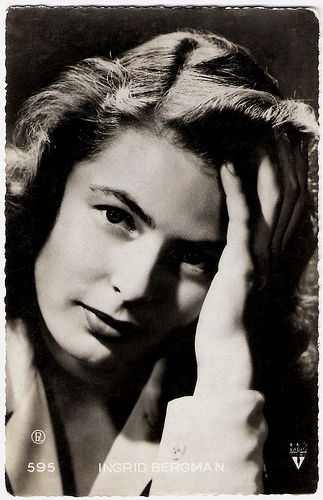
Vintage postcard by PE, no. 595. Photo: RKO Radio Pictures.
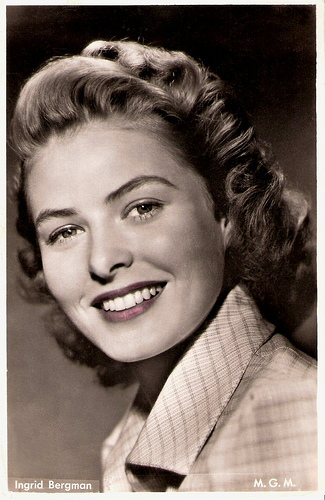
Dutch postcard by DRC/MEPA. Photo: MGM.
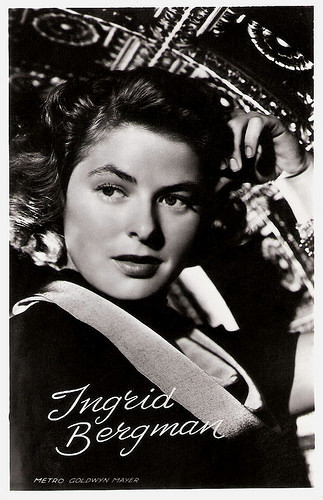
Dutch postcard, no. 3320. Photo: MGM (Metro-Goldwyn-Mayer).
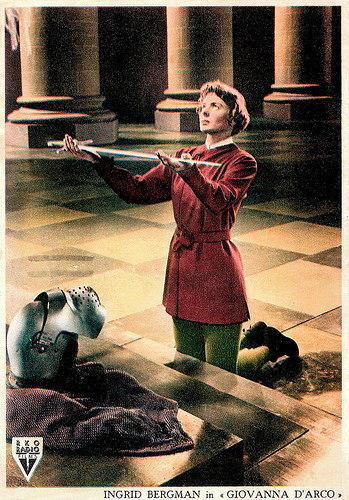
Italian postcard, no. 3161. Photo: R.K.O. Radio Pictures. Publicity still for Joan of Arc (Victor Fleming, 1948).
Summer Break
Ingrid Bergman was born in Stockholm, Sweden in 1915 to a Swedish father and a German mother.
At age 17, she had a taste of acting when she played an uncredited role of a girl standing in line in the Swedish film Landskamp (Gunnar Skoglund, 1932). The next year she was accepted to the Royal Dramatic Theatre in Stockholm, but she soon decided that stage acting was not for her.
During her first summer break, she was hired at a Swedish film studio to work in film full time. Her first film part was in Munkbrogreven/The Count of the Old Town (Edvin Adolphson, 1935), where she had a speaking part as Elsa Edlund.
The following years she made a dozen films in Sweden that established her as a class actress. Among them were Bränningar/The Surf (Ivar Johansson, 1935) and Dollar (Gustaf Mollander, 1938).
Another film, En kvinnas ansikte (Gustaf Molander, 1938) would later be remade as A Woman's Face with Joan Crawford. Bergman also made a film in Germany, Die Vier Gesellen/The Four Companions (Carl Froelich, 1938).
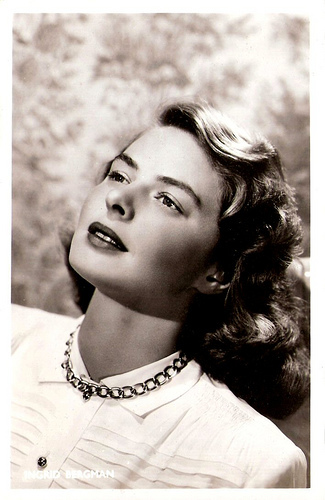
Dutch postcard.
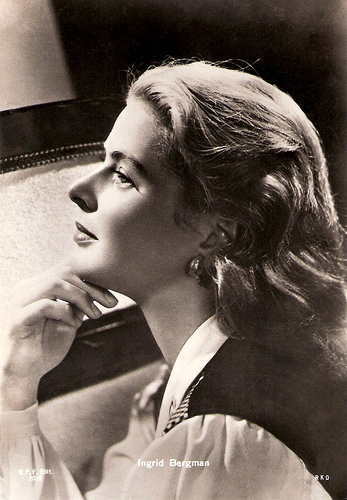
Italian postcard by Casa Edite Ballerini & Fratini, Firenze. Photo: RKO.
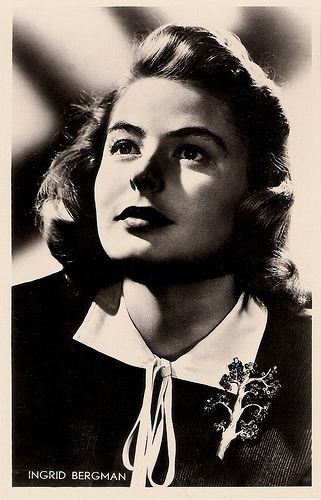
Dutch postcard by S. & v. H., A. Photo: M.P.E.A.
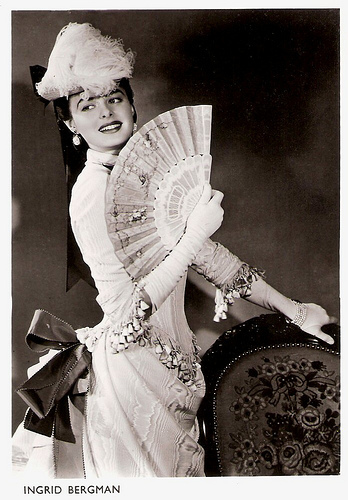
Dutch postcard by J. Sleding N.V., Amsterdam, no. 102/1250.
Intermezzo
Ingrid Bergman's breakthrough film was Intermezzo (Gustaf Molander, 1936), in which she played a pianist who has a love affair with a celebrated and married violinist, played by Gösta Ekman .
Hollywood producer David O. Selznick saw it and sent a representative from MGM to gain the rights to the story and have the actress signed to a contract. Ingrid went to California and starred in MGM's remake Intermezzo: A Love Story (Gregory Ratoff, 1939), reprising her original role.
The film was a hit and so was Ingrid. Her beauty was unlike anything the movie industry had seen before and her acting was superb. She was under contract to go back to Sweden to film En enda natt/One Single Night (Gustaf Molander, 1939) and Juninatten/A Night in June (Per Lindberg, 1940).
Back in the US she appeared in three films, all well-received. In 1942 she played in only one film, but that film, Casablanca (Michael Curtiz, 1942), would make her a huge star. Bergman chose her roles well after Casablanca.
In 1943 she was nominated for an Academy Award for her role in Ernest Hemingway's For Whom the Bell Tolls (Sam Wood, 1943), the only film she made that year. The critics and public didn't forget her when she made Gaslight (George Cukor, 1944) the following year - her role as the persecuted wife of Charles Boyer got her the Oscar for Best Actress.
In 1945 Ingrid played in Spellbound (Alfred Hitchcock, 1945) with Gregory Peck, Saratoga Trunk (Sam Wood, 1945) and The Bells of St. Mary's (Leo McCarey, 1945), for which she received her third Oscar nomination for her part as Sister Benedict.
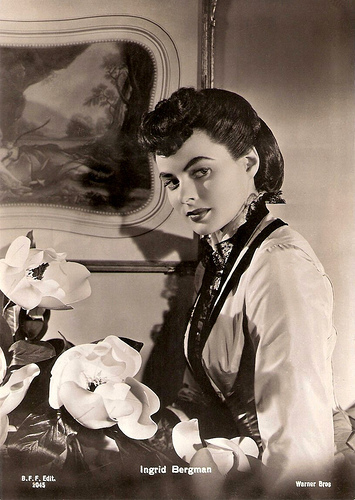
Italian postcard by Casa Editr. Ballerini & Fratini, Firenze, no. 2045. Photo: Warner Bros.
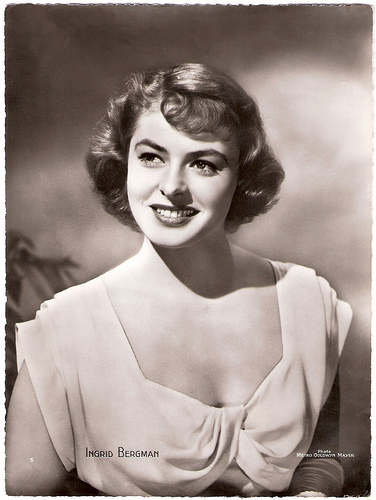
Big Belgian card by Chocolaterie Clovis, Pepinster. Photo: Metro Goldwyn Mayer.
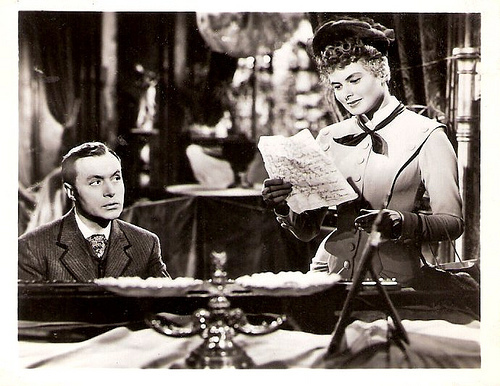
Small card. Photo: MGM. Photo: still from Gaslight (George Cukor, 1944) with Charles Boyer .
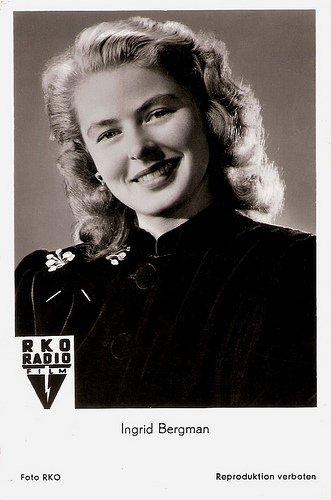
German postcard by Film-Postkartenverlag Hbg.-Bergedorf, no. 150. Photo: RKO. Publicity still for Notorious (Alfred Hitchcock, 1946).
Jeanne d'Arc
Ingrid Bergman also worked with Alfred Hitchcock on another classic, Notorious (1946) with Cary Grant, and the less successful Under Capricorn (1949) with Joseph Cotten.
Bergman went to Alaska during World War II in order to entertain troops. Soon after the war ended, she also went to Europe for the same purpose, where she was able to see the devastation caused by the war. It was during this time that she began a relationship with the famous photographer Robert Capa.
She made no films in 1947, but bounced back with a fourth nomination for Joan of Arc (Victor Fleming, 1948). She played the part of Jeanne d'Arc three times in her career: on stage in 1946 in Maxwell Anderson's Joan of Lorraine for which she won the Tony Award, in the film version in 1948, and in 1954 in the Italian film Giovanna d'Arco al rogo/Joan of Arc at the Stake (Roberto Rossellini, 1954), based on a 1935 dramatic oratorio by Arthur Honegger.
But in 1949 Saint Ingrid first would suffer a sudden and disastrous fall from grace.
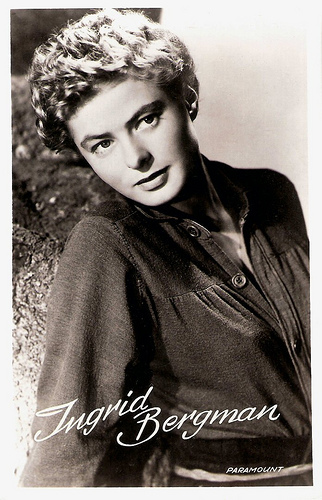
Dutch postcard. Photo: Paramount. Publicity still for Joan of Arc (1948).
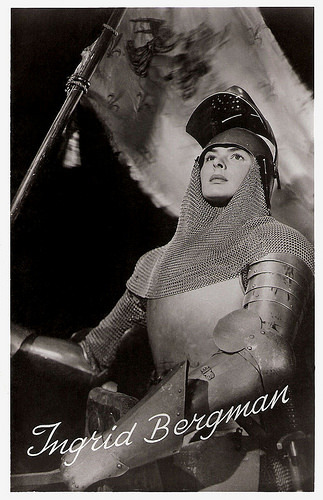
Dutch postcard, no. 3161. Photo: publicity still for Joan of Arc (1948).
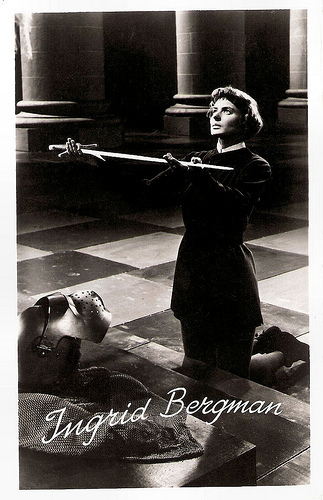
Dutch postcard. Photo: Paramount. Publicity still for Joan of Arc (1948).
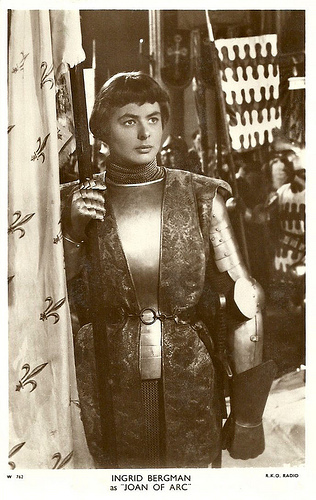
British postcard, no. W 762. Photo: R.K.O. Publicity still for Joan of Arc (1948).
Scandal
In 1949 Ingrid Bergman went to Italy to film Stromboli (1950), directed by Roberto Rossellini. She fell in love with him and got pregnant. The pregnancy caused a huge scandal in the United States. It even led to Bergman being denounced on the floor of the US Senate by Edwin C. Johnson, a Democratic senator, who referred to her as "a horrible example of womanhood and a powerful influence for evil." In addition, there was a floor vote, which resulted in her being made persona non grata.
The scandal forced Ingrid Bergman to exile herself to Italy, leaving her husband, Dr. Petter Lindström, and daughter, Pia Lindström in the United States. Dr. Lindström eventually sued for desertion and waged a custody battle for their daughter.
In 1950 Bergman married Rossellini and the same year their son, Renato Roberto, was born. In 1952 Ingrid had twins, Isotta and Isabella Rossellini. Isabella would later become an outstanding actress in her own right, as did her halfsister Pia.
From 1950 to 1955 Bergman and Rossellini made six films together: Stromboli (1950), Europa '51/No Greater Love (1952), a segment of Siamo donne/We, the Women (1953), Viaggio in Italia/Voyage in Italy (1954), La paura/Fear (1954) and Giovanna d'Arco al rogo/Joan of Arc at the Stake (1954). These films were ahead of their time but were generally not received well, especially in the US, where many conservative political and religious leaders still raised a hue and cry about her past.
Bergman also starred in Jean Renoir's Elena et les Hommes/Elena and Her Men (1956), a romantic comedy where she played a Polish princess caught in political intrigue. Although the film wasn't a success, it has since come to be regarded as one of her best performances.
Finally, after being exiled from Hollywood for seven years, Bergman returned opposite Yul Brynner in the title role in Anastasia (Anatole Litvak, 1956), which was filmed in England. For this she won her second Academy Award. She had scarcely missed a beat. The award was accepted for her by her friend Cary Grant. Bergman would not make her first post-scandal public appearance in Hollywood until the 1958 Academy Awards, when she was the presenter of the Academy Award for Best Picture. Furthermore, after being introduced by Cary Grant and walking out on stage to present, she was given a standing ovation.
In 1957 she had divorced Rosselini and in 1958 she married Lars Schmidt, a theatrical entrepreneur from a wealthy Swedish shipping family. After all the years she spent away from Hollywood, she still managed to maintain her status as a major star, as the success of films like Indiscreet (Stanley Donen, 1958) opposite Cary Grant and The Inn of the Sixth Happiness (Mark Robson, 1958) with Curd Jürgens showed.
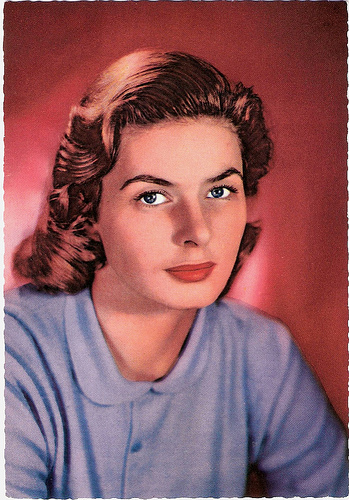
German postcard by ISV, no. A 58. Photo: 20th Century Fox. Publicity still for Anastasia (Anatole Litvak, 1956).
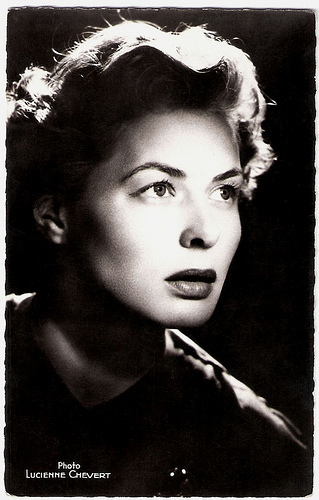
French postcard by Editions du Globe, Paris, no. 198. Photo: Lucienne Chevert.
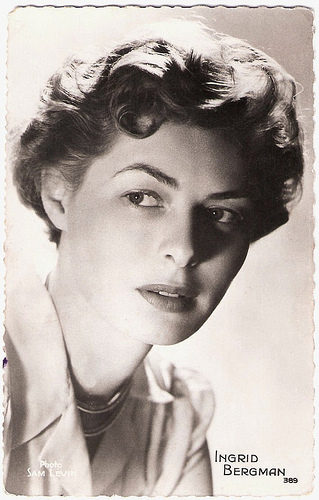
French postcard by Editions P.I., Paris, no. 389. Photo: Sam Lévin.
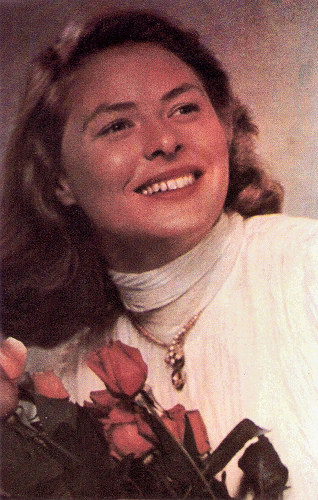
American postcard by Coral-Lee, Rancho Cordova, Ca., no. Personality 77.
Emmy Award
In the 1960s, Ingrid Bergman concentrated on stage work and television appearances, collaborated with her husband, theatrical producer Lars Schmidt, in such TV plays as The Turn of The Screw (John Frankenheimer, 1960) for which she won an Emmy Award, and Twenty-Four Hours in a Woman's Life (Silvio Narrizano, 1961).
She didn't appear in as many films as she had before, but she continued to bounce between Europe and the US making films. After a long hiatus, Bergman appeared in Cactus Flower (Gene Saks, 1968), with Walter Matthau and Goldie Hawn. In 1972, Senator Charles H. Percy entered an apology into the Congressional Record for the attack made on Bergman 22 years earlier by Edwin C. Johnson.
Bergman won her third Academy Award for her role as Greta Ohlsson in Murder on the Orient Express (Sidney Lumet, 1974). Her performance is contained in a single scene: her interrogation by Poirot, captured in a single continuous take, nearly five minutes long. By 1975 Ingrid Bergman was divorced again.
In her final big-screen performance in Höstsonaten/Autumn Sonata (Ingmar Bergman, 1978) she had her seventh Academy Award nomination. Bergman plays in this film a celebrity pianist who returns to Sweden to visit her neglected daughter, played by Liv Ullmann. Though she didn't win the Oscar, many felt it was the best performance of her career.
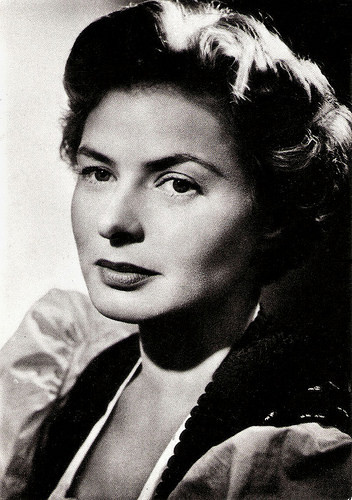
French postcard by Editions P.I. Paris, no. FK 1585. Photo: Lars Looschen.
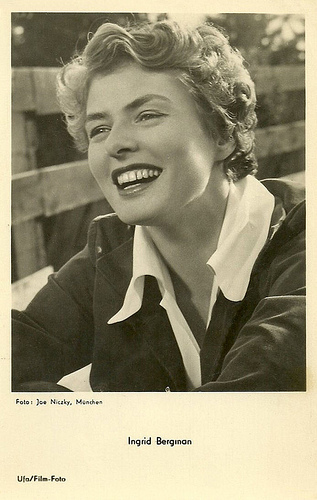
German postcard by Ufa/Film-Foto. Photo: Joe Niczky, Munich.
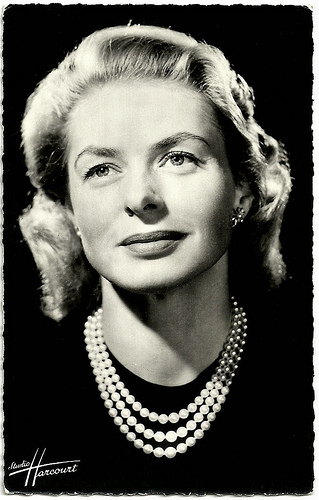
French postcard by Editions du Globe, Paris. Photo: Studio Harcourt.
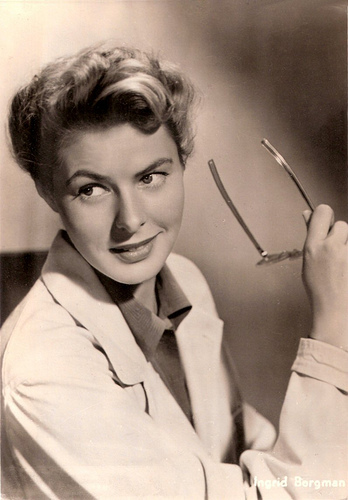
Dutch postcard by REB.
As Time Goes By
In the late 1970s Ingrid Bergman first discovered the symptoms of cancer and underwent a mastectomy. Her last role was in the television film A Woman Called Golda (Alan Gibson, 1982), about the late Israeli Prime Minister Golda Meir.
Ingrid Bergman died in 1982, in London, the day after having a small party with a few friends for her 67th birthday. At her burial a single violin played the song As Time Goes By, the theme from Casablanca, recalling her most famous role, that of Ilsa Lund.
That year her daughter, Pia Lindström accepted the Emmy Award as Best Actress that Ingrid won posthumously for A Woman Called Golda.
Seventeen years later, in 1999, she was ranked #4 in the American Film Institute's list of greatest female screen legends. Later she was ranked #5 in Premiere's list of 'The 50 Greatest Movie Stars of All Time'. Ingrid Bergman continues to be a cultural icon - for her films and for her innocent, natural beauty.
Ingrid Bergman in a scene from Die Vier Gesellen (1938). Source: Herweniel (YouTube). Sorry, no subtitles.
Scenes from Notorious (1946). Music by Sergei Rachmaninoff. Source: MovieMusic (YouTube).
Theatrical trailer for Anastasia (1956). Source: CaptainBijou (YouTube).
Scene from Elena et les Hommes (1956) with Mel Ferrer. Source: Anmili (YouTube).
Sources: Denny Jackson, Naim81 and Ezio Flavio de Freitas (), Wikipedia, Hitchcock.tv and .

Vintage postcard by PE, no. 595. Photo: RKO Radio Pictures.

Dutch postcard by DRC/MEPA. Photo: MGM.

Dutch postcard, no. 3320. Photo: MGM (Metro-Goldwyn-Mayer).

Italian postcard, no. 3161. Photo: R.K.O. Radio Pictures. Publicity still for Joan of Arc (Victor Fleming, 1948).
Summer Break
Ingrid Bergman was born in Stockholm, Sweden in 1915 to a Swedish father and a German mother.
At age 17, she had a taste of acting when she played an uncredited role of a girl standing in line in the Swedish film Landskamp (Gunnar Skoglund, 1932). The next year she was accepted to the Royal Dramatic Theatre in Stockholm, but she soon decided that stage acting was not for her.
During her first summer break, she was hired at a Swedish film studio to work in film full time. Her first film part was in Munkbrogreven/The Count of the Old Town (Edvin Adolphson, 1935), where she had a speaking part as Elsa Edlund.
The following years she made a dozen films in Sweden that established her as a class actress. Among them were Bränningar/The Surf (Ivar Johansson, 1935) and Dollar (Gustaf Mollander, 1938).
Another film, En kvinnas ansikte (Gustaf Molander, 1938) would later be remade as A Woman's Face with Joan Crawford. Bergman also made a film in Germany, Die Vier Gesellen/The Four Companions (Carl Froelich, 1938).

Dutch postcard.

Italian postcard by Casa Edite Ballerini & Fratini, Firenze. Photo: RKO.

Dutch postcard by S. & v. H., A. Photo: M.P.E.A.

Dutch postcard by J. Sleding N.V., Amsterdam, no. 102/1250.
Intermezzo
Ingrid Bergman's breakthrough film was Intermezzo (Gustaf Molander, 1936), in which she played a pianist who has a love affair with a celebrated and married violinist, played by Gösta Ekman .
Hollywood producer David O. Selznick saw it and sent a representative from MGM to gain the rights to the story and have the actress signed to a contract. Ingrid went to California and starred in MGM's remake Intermezzo: A Love Story (Gregory Ratoff, 1939), reprising her original role.
The film was a hit and so was Ingrid. Her beauty was unlike anything the movie industry had seen before and her acting was superb. She was under contract to go back to Sweden to film En enda natt/One Single Night (Gustaf Molander, 1939) and Juninatten/A Night in June (Per Lindberg, 1940).
Back in the US she appeared in three films, all well-received. In 1942 she played in only one film, but that film, Casablanca (Michael Curtiz, 1942), would make her a huge star. Bergman chose her roles well after Casablanca.
In 1943 she was nominated for an Academy Award for her role in Ernest Hemingway's For Whom the Bell Tolls (Sam Wood, 1943), the only film she made that year. The critics and public didn't forget her when she made Gaslight (George Cukor, 1944) the following year - her role as the persecuted wife of Charles Boyer got her the Oscar for Best Actress.
In 1945 Ingrid played in Spellbound (Alfred Hitchcock, 1945) with Gregory Peck, Saratoga Trunk (Sam Wood, 1945) and The Bells of St. Mary's (Leo McCarey, 1945), for which she received her third Oscar nomination for her part as Sister Benedict.

Italian postcard by Casa Editr. Ballerini & Fratini, Firenze, no. 2045. Photo: Warner Bros.

Big Belgian card by Chocolaterie Clovis, Pepinster. Photo: Metro Goldwyn Mayer.

Small card. Photo: MGM. Photo: still from Gaslight (George Cukor, 1944) with Charles Boyer .

German postcard by Film-Postkartenverlag Hbg.-Bergedorf, no. 150. Photo: RKO. Publicity still for Notorious (Alfred Hitchcock, 1946).
Jeanne d'Arc
Ingrid Bergman also worked with Alfred Hitchcock on another classic, Notorious (1946) with Cary Grant, and the less successful Under Capricorn (1949) with Joseph Cotten.
Bergman went to Alaska during World War II in order to entertain troops. Soon after the war ended, she also went to Europe for the same purpose, where she was able to see the devastation caused by the war. It was during this time that she began a relationship with the famous photographer Robert Capa.
She made no films in 1947, but bounced back with a fourth nomination for Joan of Arc (Victor Fleming, 1948). She played the part of Jeanne d'Arc three times in her career: on stage in 1946 in Maxwell Anderson's Joan of Lorraine for which she won the Tony Award, in the film version in 1948, and in 1954 in the Italian film Giovanna d'Arco al rogo/Joan of Arc at the Stake (Roberto Rossellini, 1954), based on a 1935 dramatic oratorio by Arthur Honegger.
But in 1949 Saint Ingrid first would suffer a sudden and disastrous fall from grace.

Dutch postcard. Photo: Paramount. Publicity still for Joan of Arc (1948).

Dutch postcard, no. 3161. Photo: publicity still for Joan of Arc (1948).

Dutch postcard. Photo: Paramount. Publicity still for Joan of Arc (1948).

British postcard, no. W 762. Photo: R.K.O. Publicity still for Joan of Arc (1948).
Scandal
In 1949 Ingrid Bergman went to Italy to film Stromboli (1950), directed by Roberto Rossellini. She fell in love with him and got pregnant. The pregnancy caused a huge scandal in the United States. It even led to Bergman being denounced on the floor of the US Senate by Edwin C. Johnson, a Democratic senator, who referred to her as "a horrible example of womanhood and a powerful influence for evil." In addition, there was a floor vote, which resulted in her being made persona non grata.
The scandal forced Ingrid Bergman to exile herself to Italy, leaving her husband, Dr. Petter Lindström, and daughter, Pia Lindström in the United States. Dr. Lindström eventually sued for desertion and waged a custody battle for their daughter.
In 1950 Bergman married Rossellini and the same year their son, Renato Roberto, was born. In 1952 Ingrid had twins, Isotta and Isabella Rossellini. Isabella would later become an outstanding actress in her own right, as did her halfsister Pia.
From 1950 to 1955 Bergman and Rossellini made six films together: Stromboli (1950), Europa '51/No Greater Love (1952), a segment of Siamo donne/We, the Women (1953), Viaggio in Italia/Voyage in Italy (1954), La paura/Fear (1954) and Giovanna d'Arco al rogo/Joan of Arc at the Stake (1954). These films were ahead of their time but were generally not received well, especially in the US, where many conservative political and religious leaders still raised a hue and cry about her past.
Bergman also starred in Jean Renoir's Elena et les Hommes/Elena and Her Men (1956), a romantic comedy where she played a Polish princess caught in political intrigue. Although the film wasn't a success, it has since come to be regarded as one of her best performances.
Finally, after being exiled from Hollywood for seven years, Bergman returned opposite Yul Brynner in the title role in Anastasia (Anatole Litvak, 1956), which was filmed in England. For this she won her second Academy Award. She had scarcely missed a beat. The award was accepted for her by her friend Cary Grant. Bergman would not make her first post-scandal public appearance in Hollywood until the 1958 Academy Awards, when she was the presenter of the Academy Award for Best Picture. Furthermore, after being introduced by Cary Grant and walking out on stage to present, she was given a standing ovation.
In 1957 she had divorced Rosselini and in 1958 she married Lars Schmidt, a theatrical entrepreneur from a wealthy Swedish shipping family. After all the years she spent away from Hollywood, she still managed to maintain her status as a major star, as the success of films like Indiscreet (Stanley Donen, 1958) opposite Cary Grant and The Inn of the Sixth Happiness (Mark Robson, 1958) with Curd Jürgens showed.

German postcard by ISV, no. A 58. Photo: 20th Century Fox. Publicity still for Anastasia (Anatole Litvak, 1956).

French postcard by Editions du Globe, Paris, no. 198. Photo: Lucienne Chevert.

French postcard by Editions P.I., Paris, no. 389. Photo: Sam Lévin.

American postcard by Coral-Lee, Rancho Cordova, Ca., no. Personality 77.
Emmy Award
In the 1960s, Ingrid Bergman concentrated on stage work and television appearances, collaborated with her husband, theatrical producer Lars Schmidt, in such TV plays as The Turn of The Screw (John Frankenheimer, 1960) for which she won an Emmy Award, and Twenty-Four Hours in a Woman's Life (Silvio Narrizano, 1961).
She didn't appear in as many films as she had before, but she continued to bounce between Europe and the US making films. After a long hiatus, Bergman appeared in Cactus Flower (Gene Saks, 1968), with Walter Matthau and Goldie Hawn. In 1972, Senator Charles H. Percy entered an apology into the Congressional Record for the attack made on Bergman 22 years earlier by Edwin C. Johnson.
Bergman won her third Academy Award for her role as Greta Ohlsson in Murder on the Orient Express (Sidney Lumet, 1974). Her performance is contained in a single scene: her interrogation by Poirot, captured in a single continuous take, nearly five minutes long. By 1975 Ingrid Bergman was divorced again.
In her final big-screen performance in Höstsonaten/Autumn Sonata (Ingmar Bergman, 1978) she had her seventh Academy Award nomination. Bergman plays in this film a celebrity pianist who returns to Sweden to visit her neglected daughter, played by Liv Ullmann. Though she didn't win the Oscar, many felt it was the best performance of her career.

French postcard by Editions P.I. Paris, no. FK 1585. Photo: Lars Looschen.

German postcard by Ufa/Film-Foto. Photo: Joe Niczky, Munich.

French postcard by Editions du Globe, Paris. Photo: Studio Harcourt.

Dutch postcard by REB.
As Time Goes By
In the late 1970s Ingrid Bergman first discovered the symptoms of cancer and underwent a mastectomy. Her last role was in the television film A Woman Called Golda (Alan Gibson, 1982), about the late Israeli Prime Minister Golda Meir.
Ingrid Bergman died in 1982, in London, the day after having a small party with a few friends for her 67th birthday. At her burial a single violin played the song As Time Goes By, the theme from Casablanca, recalling her most famous role, that of Ilsa Lund.
That year her daughter, Pia Lindström accepted the Emmy Award as Best Actress that Ingrid won posthumously for A Woman Called Golda.
Seventeen years later, in 1999, she was ranked #4 in the American Film Institute's list of greatest female screen legends. Later she was ranked #5 in Premiere's list of 'The 50 Greatest Movie Stars of All Time'. Ingrid Bergman continues to be a cultural icon - for her films and for her innocent, natural beauty.
Ingrid Bergman in a scene from Die Vier Gesellen (1938). Source: Herweniel (YouTube). Sorry, no subtitles.
Scenes from Notorious (1946). Music by Sergei Rachmaninoff. Source: MovieMusic (YouTube).
Theatrical trailer for Anastasia (1956). Source: CaptainBijou (YouTube).
Scene from Elena et les Hommes (1956) with Mel Ferrer. Source: Anmili (YouTube).
Sources: Denny Jackson, Naim81 and Ezio Flavio de Freitas (), Wikipedia, Hitchcock.tv and .
Published on June 29, 2015 22:00
Paul van Yperen's Blog
- Paul van Yperen's profile
- 13 followers
Paul van Yperen isn't a Goodreads Author
(yet),
but they
do have a blog,
so here are some recent posts imported from
their feed.



